GLAZE of GLORY
Why work by the pioneering potter Lucie Rie has the market in a spin

Inside: NATIONAL TREASURE HENRY SANDON’S COLLECTION UNDER THE HAMMER BARKING MAD THE REASON WE CAN’T GET ENOUGH OF DOG PORTRAITS
MARCH 2023
IN
THE FIRING LINE
POTTERY BY THE MARTIN BROTHERS
toTicket ride e sports stubs taking marketthe stormby
3
Women Artists
Every collector should know about
Ceramics special
Behind the scenes at two important exhibitions taking place this month
BOOK OFFERS ANTIQUE TEXTILES COME TO AUCTION PERIOD OAK ON SALE ALSO INSIDE A Gillows stand in the spotlight • Auction results • Columnists ANTIQUE COLLECTING VOL 57 N0.9 MARCH 2023





































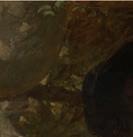



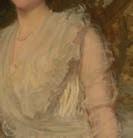






Welcome
If there was ever a Venn diagram made up of collectors and dog owners, I would hazard a guess the intersection would be rather crammed. If the categories were dog owners and antiques dealers the number might be even more. Maybe it’s the loneliness of hours spent on the road, or the fact no traditional interior is complete without a Labrador dozing by the Aga, but whatever the reason, we are an industry devoted to our pooches.
Such was the devotion of Diana Steel, one of the founders of the Antique Collectors’ Club, to her four-legged friends (of which she had dozens) she used the silhouette of a greyhound as the company logo – an image still seen on the spine of countless ACC books.
So when e Wallace Collection unveiled its pandemic-delayed exhibition Portraits of Dogs from Gainsborough to Hockney, we knew we needed a front row seat. Over the years dog portraits as a collecting category has also held its ground. Have a look on page 18.
As regular readers know, this magazine loves to champion artists overlooked by history. And with International Women’s Day on March 8 it only seemed right to shine a light on two female artists whose names deserve to be better known. For the feminists it is righting the patriarchal imbalance, but for others it just represents a solid investing opportunity. Between 2012 and 2018, Sotheby’s Mei Moses indices (which track the repeat-sale prices of 60,000 artworks) reported work by female artists rose in value by an average of 72.9 per cent, while art by their male counterparts rose by only 8.3 per cent. Discover more on page 34.
Talking of returns, did you know that a ticket for the rst US Masters golf tournament in Augusta in 1934 (thought to be one of 10 in existence) sold last year for $600,000? One of the same tickets sold for $50,000 in 2007, the gap re ecting a price hike of 1,100 per cent, or a growth rate of 73.3 per cent per annum. is could be one of the reasons why many experts are predicting sports tickets as one of the really big areas of collecting in 2023. Turn to page 48 for more insider tips.
Elsewhere in the magazine ceramics are at the fore, with a preview of an exhibition of work by the Viennese-born pioneering potter Lucie Rie on page 44, plus, on page 28, a deep dive into the eccentric designs of the Martin Brothers whose work continues to y out of salerooms around the world.
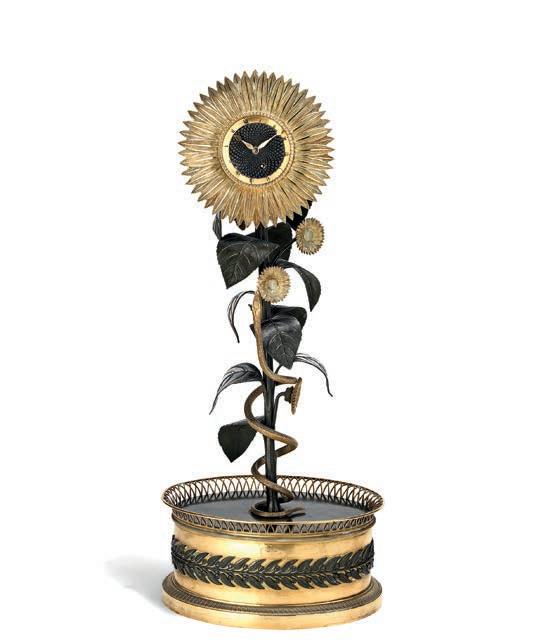
Enjoy the issue.
Georgina Wroe, Editor



KEEP IN TOUCH
Write to us at Antique
Collecting, Sandy Lane, Old Martlesham, Woodbridge, Suffolk, IP12 4SD, or email magazine@accartbooks.com. Visit the website at www.antique-collecting.co.uk and follow us on Twitter and Instagram @AntiqueMag
THE TEAM
Editor: Georgina Wroe, georgina. wroe@accartbooks.com
Online Editor: Richard Ginger, richard.ginger@accartbooks.com Design: Philp Design, james@philpdesign.co.uk
Advertising and subscriptions: Charlotte Kettell 01394 389969, charlotte.kettell @accartbooks.com


ANTIQUE COLLECTING 3
IN THIS ISSUE
JANE OAKLEY is on the scent with the best dog portraits as a new exhibition is unveiled, page 18
STEVEN SPARROW
Behind the scenes with the new managing director at Wilson 55, page 8
Antique Collecting subscription
FIRST WORD this Charles X gilt bronze clock in the shape of a sun ower, which has an estimate of £2,000-£3,000 at Bonhams Chequers attic sale on March 21. We love!
GEORGE KINGHAM presents his collecting guide to the eccentric ceramic creations of the legendary Martin Brothers, page 28
MARIJKE
VARRALL-JONES considers the pioneering work of the potter Lucie Rie, page 44
£38 for 10 issues annually, no refund is available. ISSN: 0003-584X
RemarkableRoomsAuctions
wecontinuetoinviteconsignmentstoourRemarkableRooms auctionsthroughout2023
PreviouslysoldinourRemarkableRoomsauctionwasthisLate17thCenturyWilliamandMarylacquered cabinetonstand,thecabinetdecoratedwithchinoiserieornithologicalsceneswithgiltmetalpiercedand shapedcornerbrackets,hingesandornateescutcheonenrichedwithengravedflowersandfoliage. Soldfor£28,000(includingbuyerspremium)

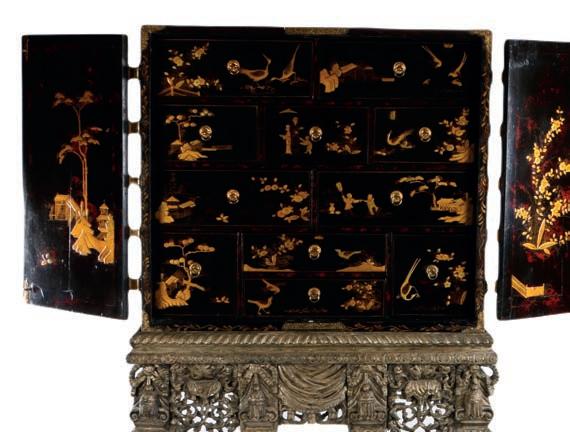
OurnextRemarkableRoomsauctiontakesplaceatourStowmarketsaleroomson Thursday30March2023startingat10am.Viewingforthisauctionwillbeavailablein personfromMonday27March2023.

www.bishopandmillerauctions.co.uk

SuffolkSaleroom:19CharlesIndustrialEstate,Stowmarket,Suffolk,IP145AH enquiries@bm-auctions.co.uk01449673088
NorfolkAuctionGallery:12ManorFarm,Glandford,nrHolt,Norfolk,NR257JP norfolk.enquiries@bm-auctions.co.uk01263687342

A bowl by Lucie Rie, part of Sotheby’s selling exhibition (Women) Makers from March 10-16, with bidding open from March 2-16, image courtesy of Sotheby’s
REGULARS
3 Editor’s Welcome: Georgina Wroe introduces the March issue which sees ceramics in the limelight and reveals three hot collecting categories in 2023
6 Antique News: A round-up of all the latest events from around the country including an exhibition of Andy Warhol’s lesser-seen textiles
10 Your Letters: is month’s postbag reveals some very personal re ections on the bombing of Hiroshima
12 Around the Houses: Princess Diana’s favourite ballgown goes under the hammer and a banner celebrating the end of slavery creates a stir
16 Waxing Lyrical: David Harvey is upstanding for a pair of salver stands by the renowned maker Gillows

Subscription O er: Save 50 per cent on the annual subscription to Antique and receive a book worth £75

Saleroom Spotlight: e Beedham collection of the nest period oak goes under the hammer in Su olk


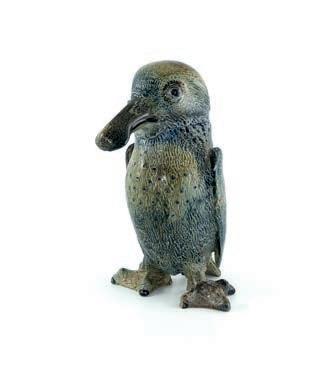
Crossword editor Peter Wade-Wright puts us through our paces with two pages of head-scratching posers
An Auctioneer’s Lot: Charles Hanson is left standing when a eet of classic cars is discovered in a barn
e closing of a London antique textiles shop sees a mouth-watering array of tapestries come to market, while a rare stained glass window is set to shatter records
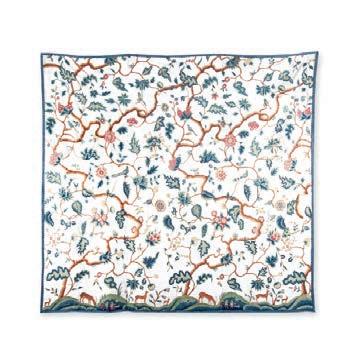
Book O ers: Discover the latest titles from out sister publisher ACC Art Books and save more than a third on the RRP into the bargain

58 Fair News: An announcement from two major London fairs plus other events taking place around the UK this month
59 Fairs Calendar: Plan your ‘antiquing’ month with our guide to all the latest fairs near you and in the rest of the UK
60 Auction Calendar: Our up-to-date listings will help you navigate all the best sales taking place this month
66 Marc My Words: Fresh from a trip to India, Antiques Roadshow specialist Marc Allum gives a global perspective
FEATURES



18 Hound for Hound: Behind the scenes of a new exhibition exploring how artists have portrayed dogs down the centuries
28 e Brothers Whim: 150 years since the inauguration of the famous Martin Brothers pottery in 1875 and a century on from the death of Robert Wallace Martin, a new exhibition and sale puts the brothers back in the spotlight

34 Femme Fatales: As the market wakes up to women artists of the avant-garde working in 19th-century Paris, we put three in the spotlight
40 National Treasure: e outstanding collection of long-standing Antiques Roadshow favourite and ceramics expert Henry Sandon is o ered for sale in Gloucestershire
44 We Love Lucie: e 20th-century pioneering potter Lucie Rie is put in the limelight alongside a guide to collecting her work
48 Triple Jumps: Memorabilia expert Paul Fraser urges us all to take a look at three collecting categories set to transform the market this year

ANTIQUE COLLECTING 5 THIS MONTH Contents
COVER
VOL 57 NO 9 MARCH 2023 ALSO INSIDE A Gillows stand in the spotlight Auction results GLAZE of GLORY Inside: COLLECTION UNDER THE HAMMER BARKING MAD Why work by the pioneering potter Lucie Rie has the market in a spin Ceramics special Behind the scenes at two important exhibitions taking place this month
US @AntiqueMag
FOLLOW
TO SUBSCRIBE TODAY VISIT WWW.ANTIQUE-COLLECTING.CO.UK/SUBSCRIBE WEEKDAYS FROM 9.30AM TO 1PM, 40
26 54 12 44 28
WHAT’S GOING ON IN MARCH

A NTIQUE news
Sew long
The results of one of the National Trust’s longest conservation projects in its history are set to go on show later this year. After a 24-year revamp, the last of the 13 ‘Hardwick Tapestries’ is set to return to the Long Gallery at Hardwick Hall in Derbyshire in the early summer. The conservation of each tapestry has cost £278,000, taking more than two years to complete.
Hardwick Hall’s Denise Edwards said: “The tapestries are huge and one of the most ambitious tapestry sets of the period, rivalling other great works of the 1530s and 1540s.”
Top Edvard Munch (1863-1944), Dance on the Beach carries a pre-sale estimate of £12m-£20m

Above e painting on board the MS Black Watch in 1969

Right Panagyurishte treasure, racian, 400-300BC, © National Museum of History, Bulgaria
Below left e Hardwick Tapestry (Gideon Attacking the Midianites, 1578) being worked on in the Long Gallery at Hardwick Hall, © National Trust Images/Trevor Ray Hart

Hidden masterpiece
A 4m-wide painting by the Norwegian painter Edvard Munch (1863-1944) hidden in a barn, to keep it out of the hands of German soldiers, is to be sold with the proceeds split with the family of the Jewish man who was forced to sell it when eeing the Nazis.
e monumental Dance on the Beach will be auctioned by Sotheby’s in London on March 1 and is estimated to fetch around £12m-£20m. It is being sold by the family of omas Olsen, a Norwegian shipowner and Munch’s neighbour, who died in 1969. Olsen bought the painting in Oslo in 1934, just months after Curt Glaser, an eminent German academic, had been forced to sell it in Berlin.
He hung it in the rst-class lounge of his passenger liner, the MS Black Watch but, after Britain declared war on Germany, he hid the painting in a remote barn in the Norwegian forest.
TREASURE TROVE
Described as a “once-in-a-generation” loan, there’s an opportunity to see the Panagyurishte treasure in May when it goes on display at the British Museum.
Made up of nine richly decorated gold vessels: eight rhyta used to pour wine and one bowl to drink it, the treasure was accidentally discovered by three brothers in Bulgaria in 1949.
The pieces will take centre stage at the exhibition Luxury and Power: Persia to Greece, from May 4 to August 13, whch considers how objects were used as symbols of authority between high-ranking members of the two sparring cultures. While Athenians considered Persian culture decadent, they also tried to emulate it.

NEWS All the latest
6 ANTIQUE COLLECTING
Fashion looms large in this month’s events, including an exhibition of Andy Warhol’s textiles and a focus on Georgian out ts
Left Textile of Candy Apples, silk by Stehli Silks, © 2022 e Andy Warhol Foundation for the Visual Arts, Inc. Licensed by DACS, London

Right Paul Cézanne (1839-1906) Bathers (Les Grandes Baigneuses), c. 1894-1905, © National Gallery, London

Left Shoes textile, blouse, by Jayson Classics, c. 1957, © 2022 e Andy Warhol Foundation for the Visual Arts, Inc. Licensed by DACS, London
Below left Textile of luggage tags and suitcases, blouse, by Cohama, © 2022 e Andy Warhol Foundation for the Visual Arts, Inc. Licensed by DACS, London
1Handy Andy
Pop artist Andy Warhol’s (1928-1987) scarcely seen textiles are the spotlight of a new exhibition in London.

e Fashion and Textile Museum in Bermondsey is set to include more than 45 of his textile patterns dating from the 1950s and early 1960s, featuring a range of motifs from ice cream sundaes to pretzels.

e exhibition from March 31 to September 10 reveals the importance textiles had on Warhol’s broader development as an artist. Leading US textile manufacturers, including Stehli Silks, Fuller Fabrics and M Lowenstein and Sons, also feature in the exhibition.
3Growing interest
An exhibition celebrating 20th-century artists and their gardens is unveiled this month in London. e Garden Museum, housed in the deconsecrated church of St Mary-at-Lambeth, is hosting Private & Public: Finding the Modern British Garden from March 22 to June 25.
e interwar period in Britain saw a growth of artists who retreated to planting and painting in their gardens viewing them as private havens.
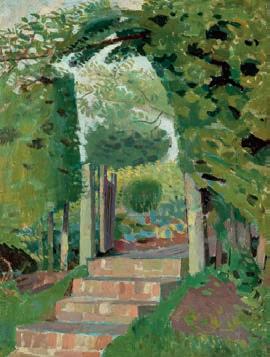
e exhibition brings together artists who revelled in the natural
to see in March
Above right Georges Seurat (1859-1891) e Channel of Gravelines, Grand Fort-Philippe, 1890, © e National Gallery, London

Above far right Paul Gauguin (1848-1903)
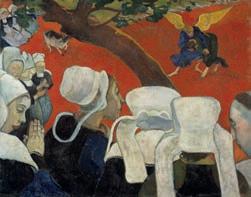
Vision of the Sermon (Jacob Wrestling with the Angel), 1888. Photo © National Galleries of Scotland, Edinburgh
Far right Ithell Colquhoun (19061988) Crane Flowers, image courtesy of Liss Llewellyn

Right Evelyn Dunbar (1906-1960) Invitation to the Garden, c. 1938, image courtesy of Liss Llewellyn
Left Gilbert Spencer (1892-1979) e Balcony, c.1928, image courtesy of Liss Llewellyn

32 Gallery view
e National Gallery’s spring blockbuster exhibition opens this month looking at the revolutionary work made in and around Paris by Vincent van Gogh, Paul Gauguin and Paul Cezanne between 1880 and 1906, during the Belle Époque. Featuring more than 100 paintings, it also traces how the methods employed by these artists to break free from conventional representation spread across Europe inspiring artists to invent Cubism, Expressionism and Abstraction. Inspiring Picasso, After Impressionism: Inventing Modern Art runs from March 25 to August 1.
world, including Charles Mahoney (1903-1968), Evelyn Dunbar (1906-1960), Eric Ravilious (19031943) and Ithell Colquhoun (1906-1988).
At the same time public spaces expanded, re ecting a growing provision for recreation boosted by more paid holidays (cemented by the Holidays with Pay Act of 1938).
ANTIQUE COLLECTING 7
Scot Free
Sir Walter Scott’s manuscript of his novel Rob Roy is set to go on show to the public this month for the first time in at least a century.
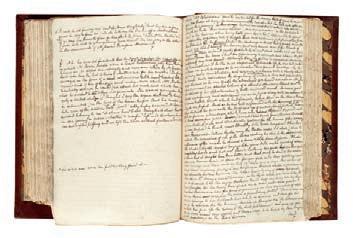
The original draft of the historical classic, published in 1817, had been among many literary gems held in the Honresfield Library formed in the 19th century by Rochdale mill owner William Law. The manuscript was saved for public view after a collective of UK-wide organisations stepped in to buy it at auction at Sotheby’s.
This month it goes on permanent show at the Treasures of the National Library of Scotland exhibition in Edinburgh.
Fashion forward
e role Jewish Londoners played in the UK’s fashion industry is put in the spotlight at a new exhibition opening this autumn.
A dress worn by David Bowie on the cover of e Man Who Sold the World, Sean Connery’s 007 shirts and a hat worn by Greta Garbo are among key items created by leading Jewish designers Mr Fish, Cecil Gee, Otto Lucas, Rahvis, Neymar and Madame Isobel.

From East End tailors to the couture salons of the West End, the exhibition, opening at the Museum of London Docklands in October, tells the story of the Jewish makers behind some of the most recognisable looks of the 20th century.
GAUGING INTEREST
Some of the best model railways from around the UK covering all major scales/gauges come together in Su olk this month.

Stonham
Barns Park, near Stowmarket, is hosting its rst ever model railway show on March 19 with a range of model railway layouts on display from manufacturers including Hornby, Bachmann and Dapol. YouTuber Lawrie Rose of Lawrie’s Mechanical Marvels will be bringing a layout based on Scole Railway near Diss built by William Betts in the 1860s.
30 seconds with...
with Steven Sparrow the new managing director at Wilson 55 auction house in Nantwich

Do you have a favourite artist?
There are many artists I rate very highly but Donald McIntyre has been a longtime favourite. He is a master of colour in the great tradition of the Scottish colourists and his paintings always lift the spirits with his depictions of white Iona beaches and sunny Cornish harbours.

What market changes have you seen?

When I started 20 years ago Northern
Makers Maak
London Ceramics specialist Maak is to hold its first auction dedicated to contemporary craft on September 17. It will include 120 pieces from the

Art wasn’t a recognised genre asi Lowry. Fast forward to today and see the deserved recognition Northern Art now receives in the saleroom and with buyers nationwide. Numerous galleries supporting this genre have sprung up andwe hold standalone Northern Art sales.
What would be your ideal find?
I have met many people over the years who knew or met Lowry in person, sadly, I never did. I would love to find a Lowry oil painting that nobody had seen before, gifted perhaps, and kept hidden away
Do you collect? If so, what?
Coinssatisfy my love of history whilealso appreciating the artistic side of numismatics.
Walking my two dogs – Molly and Poppy, especially on the Llyn Peninsula in Wales.
Wilson 55’s next Northern Art sale is on March 9.
8 ANTIQUE COLLECTING NEWS All the latest
Above Bowie dress designed by Mr Fish, © Trinity Mirror, Mirrorpix, Alamy Stock Photo
Above For the rst time in a century, members of the public will get to see the manuscript of Rob Roy
Below Ipswich Station in the 1950s by Michael Su ing, photo credit Keith Su ing
Below Donald McIntyre (1923-2009), Sunlight, Coverack, sold for £13,000 at Wilson 55
Dandy days
e extraordinary world of Georgian fashion is explored in an upcoming exhibition.
e Queen’s Gallery in Buckingham Palace hosts the display, from April 21 to October 8, which reveals how advances in trade, entertainment and technological innovations became driving forces for iconic fashion trends across all levels of society.
Style & Society: Dressing the Georgians brings together more than 200 works from the Royal Collection as well as rare surviving examples of clothing and accessories.
As well as in uences from abroad, fashionable society looked to the lower classes for style inspiration, adopting working-class garments such as aprons and knee breeches which were worn by men for most of the 18th century.


By the end of the period, upper-class men adopted trousers for the rst time.
New broom
A trio of specialists has joined Olympia Auctions, including Janet Rady who will launch the London auctioneer’s rst modern and contemporary African and Middle Eastern art sale in May.
Janet who graduated from the School of Oriental and African Studies and has an MA in Islamic art history, joined Olympia from Chiswick Auctions along with Adrian Biddell and Maryam Daoudi.

SISTER ACT
A 19th-century painting of a white and African-American girl both portrayed as social peers has been bought by London art dealers Philip Mould & Company for close to $1m at Christie’s in New York.

Painted by an unknown American artist in around 1820, and estimated at $50,000$100,000, it attracted heated competition from around the world. Mould, who is also known as the art expert on BBC1’s Fake or Fortune, said: “The constraints and social protocol in painted portraiture of the period make such palpable depiction of interracial attachment almost without precedent.”
In its description of the painting Christie’s acknowledged its rarity, stating: “This double portrait presents its subjects as equals at a time of pervasive racial inequality. If anything, the pose and props cast the AfricanAmerican girl as the superior figure.”

Janet said: “ e market for both African and Middle Eastern art is witnessing very strong sales with an emphasis on high quality modern and contemporary works.” Works in the upcoming sale on May 11, originate in Iran, the Arab world and Africa. Adrian Biddell becomes Olympia Auction’s head of British and Continental paintings and works on paper, with Maryam Daoudi as his assistant and junior cataloguer.
New look
A newly-restored painting by the French modernist Édouard Manet (1832-1883) of his cousin has gone on display at the National Museum Cardiff.

Manet’s Portrait de Monsieur Jules Dejouy (1879) was acquired by the museum after spending more than 90 years in a private collection.
Jules Dejouy (1815-1894) was not only Manet’s older cousin, but also an important figure in the artist’s life. He was a successful lawyer, appointed to the Imperial Court in France in 1849.
The portrait joins three other works by Manet in the museum’s collection.
FIGHT AT THE MUSEUM
A popular London museum that claims to be the city’s oldest toy museum is looking for a new home after it was forced to close. Pollock’s Toy Museum, just o Tottenham Court Road, has closed its doors on its current building “due to a change in circumstances regarding the ownership of the buildings.”
Its collection of toy theatres, teddy bears, dolls, games and toys has gone into temporary storage while a new building is found. e museum was started by Marguerite Tawdry, the current owner Jack Fawdry-Tatham’s great-grandmother, when she bought the entire stock from a toy theatre shop.
Below Pollock’s Toy Museum in Scala Street has had to close and is looking for new premises

ANTIQUE COLLECTING 9
Left e front of a Georgian dress on show this April, © Fashion Museum Bath
Above Men wore knee breeches for most of the 18th century, © Fashion Museum Bath
Above e painting was conserved thanks to support from the TEFAF Museum Restoration Fund
Above e 19th-century painting sold to a London gallery for more than 10 times its top estimate
Above left Janet Rady will launch Olympia Auction’s rst modern and contemporary African and Middle Eastern art sale in May
Your Let ters
is month’s topics include antiques as a marker of time and some very personal memories of the bombing of Hiroshima
Star letter
While the poet TS Eliot famously marked the passage of time in e Love Song of J. Alfred Prufrock with co ee spoons, I have another method: antiques. When I rst subscribed to the magazine in the late ‘60s (perhaps making me one of the longest-serving subscribers?) art deco was not a historic event, it was within my memory. Modernist furniture was just that – modern. Now of course they are all antiques. And I can’t help thinking I am the same. But, like all the best antiques, my patina and signs of use have only added value!
K. Forrester, by email
Like many readers during buying trips, I pick up unusual or interesting items that I know little or anything about. Please see attached photos of a small pin with a retractable needle I bought at auction with some medals and buttons. It’s approximately 85mm long, with a retractable, barbed needle that extends 40mm from the end. It is brass and steel and stamped ‘Perfect’. ere are no makers marks or any indication to its use or age. Can anybody help? ank you in anticipation.
 John Kane, Nottingham, by email
John Kane, Nottingham, by email
Our star letter receives a copy of British Designer Silver by John Andrew and Derek Styles worth £75. Write to us at Antique Collecting, Sandy Lane, Old Martlesham, Woodbridge, Suffolk, IP12 4SD or email magazine@ accartbooks.com
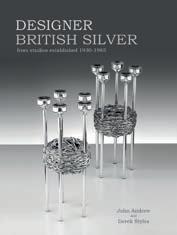
I very much enjoyed a recent article on the bombing of Hiroshima (Saleroom Spotlight, December issue Antique Collecting). I had the honour of meeting and interviewing Colonel Paul Tibbets, the pilot who ew the Enola Gay on August 6, 1945, at Maxwell Air Force Base, Alabama when I was an oral historian assigned to the Historical Research Center there in February 1985. It was my pleasure to thank him for his heroic e orts. Why was I so pleased?
Left For some, art deco is just about within living memory

Above right Aerial images by US Air Force of Hiroshima showing res still burning, part of a collection recently sold at Hansons, credit Hansons Auctioneers

Below Does anyone have details on the pin and retractable needle?
At that time, my father, who, having survived the Normandy invasion of 1944, was a member of the 4th/7th Royal Dragoon Guards and ordered to prepare for ocean shipment to Japan for another invasion, expected to be even more horri c than Normandy. So if the atomic bomb hadn’t been dropped, heralding Japan’s surrender and saving many, many UK and US lives, I might never have existed. erefore on a personal level, I was very pleased to shake General Tibbets’ hand. A lovely issue, and very meaningful to me.
Barry Anderson, Las Vegas, by email
The answers to the quiz on page 38 Q1 (a) In fact, it was 131, including, for spoons alone, 17 for serving and 19 just for getting food to the mouth. Q2 (c) They are all blacksmith’s tools. Q3 (A) = (ii), (B) = (iv), (C) = (i), (D) = (iii). Q4 (c) An overskirt of plain material, for warmth and gown protection. Q5 (b) A loxodromic curve, or rhumb line, is the course held to a fixed compass direction. On a sphere such a line is a curve. Q6 (b). Q7 (d) Issued in 1864 (the accepted 300th-anniversary of his birth), depicting the Bard and a fundraiser for a proposed theatre. Q8 (a) Opaque, brown glass sometimes, but wrongly, called caramel slag. Q9 (c) Although no doubt (b) was a factor as many footballers joined the forces as fitness instructors. Q10 (d) Guinness advertising products.
The answers to the anagrams: cash aunt can be rearranged to form acanthus; chest defiler can be rearranged to form Chesterfield; vegan grin can be rearranged to form engraving and peeled flatfish can be rearranged to form Sheffield plate
Have your say
LETTERS
10 ANTIQUE COLLECTING












Free valuations by email: henny@parkerfineartauctions.com or in person at Hawthorn House, Farnham, GU9 7SX info@parkerfineartauctions.com | 01252 20 30 20 | www.parkerfineartauctions.com CONSIGN TO OUR SPRING SALES VENDOR’S FEE JUST £10 (PLUS VAT) PER LOT INCLUDES COMMISSION, ILLUSTRATION AND INSURANCE – NO OTHER CHARGES
A ROUND the HOUSES
From a gun used in the Valentine’s Day Massacre to Princess Diana’s favourite ballgown, auction houses around the world have enjoyed a busy few weeks
Sotheby’s New York
A velvet ballgown worn by Princess Diana achieved more than ve times its pre-auction estimate when it sold in New York for £500,000 ($604,800). Designed by Victor Edelstein the dress was famously worn by the Princess of Wales in the 1997 photo shoot by Mario Testino for Vanity Fair months before her death, immortalising her in one of her most iconic and favourite dresses of all time.

Edelstein also designed the midnight-blue, o -theshoulder, velvet gown she wore at a state banquet at the White House when she danced with John Travolta.
At an earlier auction one of the princess’s favourite pieces of jewellery, the Attallah Cross, was bought by Kim Kardashian for £163,800 ($197,453) – more than doubling its estimate.

Made from square-cut amethysts and circular-cut diamonds it was part of a pendant created in 1920s by court jewellers Garrard.
Chiswick Auctions, London
A blue and gold silk banner, publicising the Slavery Abolition Act of 1833, expected to make £1,000-£2,000 sold for £14,375 at the London auctioneer’s recent sale.

At the same sale a life-size French bulldog pull toy, c.1890, expected to make £500-£700, sold for £1,375. Set on wooden casters under its paws, the dog had a painted papier mâché head with glass eyes and coconut husk collar. When pulled by a chain on the back of its neck, the pooch makes a growling or barking noise.


RR Auctions, Boston
A Colt .38 revolver, recovered from the Saint Valentine’s Day Massacre, sold for £112,000 ($135,473) at the Massachusetts auction house’s recent sale, alongside a press photo of the shooting, which doubled its low estimate to fetch (£1,700) $2,020


Part of the US auctioneers ‘Gangsters, Outlaws and Lawmen’ sale, the gun belonged to Frank Gusenberg one of Bugs Moran’s North Side Gang – Al Capone’s Chicago rivals.
On the morning of February 14, 1929, four unknown assailants—two dressed as police o cers— shot seven North Side Gang members and a liates at the 2122 North Clark Street garage, including brothers Peter and Frank Gusenberg. e massacre saw 70 rounds red from an arsenal that included two ompson submachine guns, the favourite rearm of the notorious Chicago syndicate.
An accompanying photo from the crime scene, stamped on the reverse Chicago Bureau, Tribune Tower’ had a low estimate of $1,000.
AUCTION Sales round up 12 ANTIQUE COLLECTING
The
in
princess
became increasingly bold
her fashion choices
The silk velvet dress was the gown the princess wore in the famous photo by Mario Testino
The Colt Detective Special .38 revolver belonged to a gang member
A press photo of the grisly scene also sold at the ‘gangsters’ sale
The
well-designed French bulldog was an unexpected hit
The important historic banner sold for more than 14 times its low estimate
Coins from the collection of sunken treasure realised £6,440

Gildings, Market Harborough
A single-owner collection of coins from famous shipwrecks more than doubled its estimate of £2,000£3,000, selling for £6,440 at the Leicestershire auction house.

e sale featured 51 coins in four lots grouped in the wrecks they were recovered from, ranging from 1686 to 1806. e standout lot in the auction was 17 coins from the Hollandia, a Dutch East India Company ship, which was wrecked on the Isles of Scilly’s Gunner Rock in 1743, resulting in the loss of 276 crew and company members. e lot sold for £2,700 against an estimate of £850-£1,250.
An Isles of Scilly-based diver who was part of the team that recovered some of the coins in the ‘70s was among the successful bidders.
Hansons, London
Two paintings of owers by Queen Victoria discovered in a Surrey cottage doubled their pre-sale estimate of £8,000-£10,000 when they sold for a combined total of £19,500.



Hansons’ Chris Kirkham said: “I was astounded and delighted when I discovered the paintings.” Both had been purchased decades ago by the seller’s grandfather who lived on the Isle of Wight and bought them at a sale of items relating to Osborne House, Queen Victoria’s holiday home on the island. Both paintings had letters of provenance on the reverse.
The paintings show a more colourful side to the monarch
Bonhams, Knightsbridge
A 1941 WWII recruitment poster banned for being too seductive, and condemned by the wartime leader Winston Churchill as “too Soviet”, almost doubled its low pre-sale estimate, selling for £3,825 at the London auction house in February.
Designed by Abram Games (1914-1996) to recruit women into the Auxiliary Territorial Service, its pouting red lips and blonde curls attracted widespread attention in the press, causing it to be dubbed the “Blonde Bombshell”.

Bonhams’ Richard Barclay, said: “While WWII posters such as ‘Keep Calm and Carry On’ are instantly recognisable ‘Join the ATS’ is much rarer and has cemented its place as a desirable vintage poster.”
Parker Fine Art Auctions, Farnham
A 16th-century oil on board by the Italian Renaissance artist Palma Vecchio (14801528) more than doubled its low guide price when it hammered at £42,000 at the Surrey auction house.
Several phone bidders competed for e Madonna and Child with Saint John the Baptist and Mary Magdalene, c. 1514, after its authenticity was con rmed by the specialist Philip Rylands (author of a book about the artist) who stated “there is no-one else it could be by.”
Working in Venice in the late 15th and early 16th century, Vecchio is widely considered to be the greatest artist after Titian.
A painting of the Virgin and Child, thought to be by the 15th-century Italian artist known as the Master of Roncajette, sold for £8,500, against a low estimate of £5,000, after being con rmed as a work by the artist by the Metropolitan Museum of Art.

Lawrences, Crewkerne
An enamel and gem set pendant by Carlo Giuliano and a gem set and enamel bracelet by Carlo and Arthur Giuliano both


The Virgin and Child by The Master of Roncajette sold for £8,500 in Surrey

Giuliano’s jewellery was inspired by the Renaissance and ancient Egypt
poster was banned for sending the
The oil on board by was authenticated by a leading authority
AUCTION Sales round up
Fellows, Birmingham
A limited-edition Audemars Piguet Royal Oak Leo Messi watch, expected to make £18,000-£24,000, sold for £31,200 at the Midlands auction house’s recent sale.

e Swiss watch maker began a relationship with the Argentinian footballer in 2005 when he was presented with a Royal Oak by his manager following his rst Liga title. After this, he became an avid collector of Royal Oaks and in 2010 became brand ambassador for the watchmaker.
e relationship was cemented in 2012 when Audermars Piguet released e Royal Oak Leo Messi limited edition. e collection was limited to just 1,000 pieces across three di erent variants – stainless-steel, gold, and platinum.
Graham Budd, London
A single-owner collection of football memorabilia amassed over 60 years and spanning 120 years of soccer history hit home with collectors on February 7.

Catherine Southon, Farleigh Court Golf Club
A collection of letters written on behalf of the Duke of Windsor in the 1930s fetched £350 at Catherine Southon’s sale in Surrey on February 8.
e 14 letters, posted from all over the world, were written by the private secretary of the Duke of Windsor (previously Edward VIII) and date from the period June 1937 – six months after his historic abdication - through to Christmas 1939.

One letter dated September 7, 1937, comments: “His Royal Highness wishes to assure you that the information that His Royal Highness is homesick is entirely without foundation...Quite apart from rumours in the press, it is not very likely he would be missing the country which in every possible way, tried to humiliate and misrepresent both himself and the Duchess of Windsor.”
Catherine Southon said:
“It’s amazing what parallels there are with today’s royal family.”
Made up of 460 lots of autographs, annuals and ceramics, it included several sought-after Manchester United programmes, including their rst away match in the European Cup at Anderlecht in 1956. Expected to make £1,600£1,800, it fetched £3,800. A rare programme printed in the event of a replay of the 1968 European Cup nal between Man U and Ben ca, expected to make £3,000-£4,000, sold for £7,500. But the star lot was a bound volume of Bradford City home match programmes, from 1911-1912. Expected to make £1,500-£2,000, it sold for £18,000.

Tennants, Leyburn
A watercolour and gouache of goshawks attributed to Archibald orburn (1860-1935) led the North Yorkshire auctioneer’s recent sale when it sold for £2,600, more than 10 times the expected price.

With his extraordinary eye for detail and wonderful sense of colour, orburn is arguably Britain’s nest and most popular ornithological artist.
Born in Scotland in 1860, he exhibited widely at the Royal Academy from 1880-1900. He settled in Hascombe Surrey in 1902, but regularly returned to his native Scotland.
His work was reproduced in numerous publications, most notably Coloured Figures of the Birds of the British Islands which contained nearly 270 watercolours and was carried out between 1885-1898.
14 ANTIQUE COLLECTING
Women’s programmes, estimated at £200-£300, sold for £400
The 1968 European Cup final between Man U and Benfica sold for £7,500
The archive gave an insight into the post-abdication life of the duke
Archibald Thorburn (1860-1935) studies of goshawks led the sale
The Audemars Piguet Royal Oak Leo Messi watch was issued in 2012



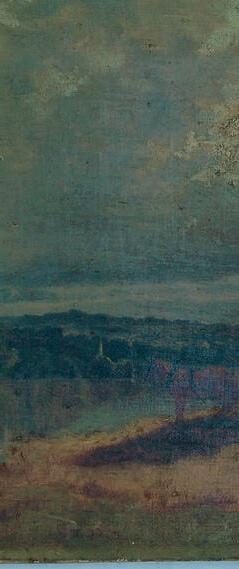


























ANTIQUE COLLECTING 15 Treasures like yours belong on eBay List your art & antiques in our new collectables category. For more information, scan the QR code Amy Kent Senior Category Manager, Art & Antiques UKCollectables@ebay.com fineart-restoration.co.uk ati n i e e ti n an e i er er i e erien e n er at r , in u in a re ite nta t u f r ur free n iti n a rai a n er ati n f fine art, furniture an e rati e e t
Waxing lyrical
David Harvey is upstanding for a pair of Regency period salver stands by the renowned maker Gillows
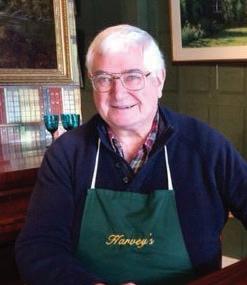

Just imagine, if you will, it is 1825 and you are pondering what to do with the impressive pair of silver salvers you have inherited from Great Aunt Maude. You would like to display them to best e ect on the serving table in the dining room, or in the grand hall on the console table. But how? A note to Mr Gillow of that famous furniture manufacturers of Lancaster and London may well solve the problem.
As regular readers of this column know, Gillows was renowned for making some of the nest mahogany furniture in England in the early 19th century. Based originally in Lancashire they opened a branch in Oxford Street, London in 1769 and quickly established a thriving business. e company had dealings with the West Indies and imported mahogany which allowed them to produce items made of the best timber at a reasonable price.
Above Gillows is recorded as having made several pairs of salver or plate stands
Right Price dictated how much decoration the salver had
e company is recorded as having made several pairs of stands which mostly correspond to the model shown above. e base is a box with a large lead weight inside to provide the stability needed when a heavy pair of salvers is displayed thereon. e sizes will of course vary according to the dimensions of the salvers. But they all have a central rising strut secured to the base and mostly split balusters or “two steps” salver retainers giving a choice of display angle.
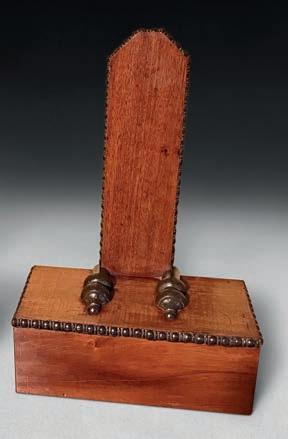

16 ANTIQUE COLLECTING EXPERT COMMENT David Harvey
Left Be careful to study a piece from all di erent angles
Right e bases retain the original baize cloth
Below left e reverse shows the original screws
Below right e stamp clearly identi es the stands’ maker
Fine decoration
e amount one wanted to spend dictated the level of decoration applied to the basic design. In this instance, the turned edge around the box base and the central splat is turned ebony as are the salver retainers. It would have been cheaper to use mahogany but not so e ective.


Many examples have su ced with just a moulded edge, rather than the turned, applied example. As these were display pieces they appear mostly to have been made of quality timbers and are well made – one wouldn’t want to spoil the whole e ect for a ha’p’orth of tar! ey are both brilliantly original and untouched, with their bases retaining the original baize cloth to protect whichever table or sideboard they sat on.
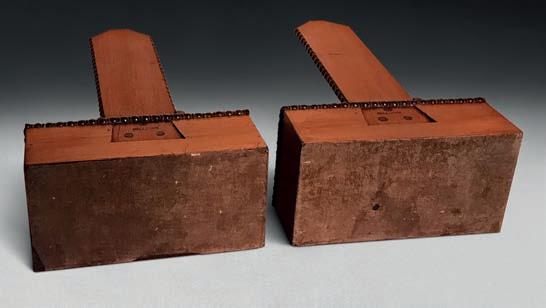
Alternative view
When I bought this pair I didn’t expect them to be as heavily weighted as they are, which suggests the salvers they were made for must have been quite substantial. I always recommend looking at pieces from underneath and behind as one can often see as much of the history of items from the less-viewed areas. e construction which you can see in the image below is reasonably simple, with the original screws still in place securing the struts to the bases.
Gillows stamp
ere is a temptation to simply attribute all similar models of stand to Gillows of Lancaster because of the illustration in Susan E. Stuart’s wonderful two-volume Gillows of
Westminster Central Archives
Neither stand had been cleaned for some time when I collected them, but after a few hours of tender loving care and several applications of a good quality wax, they came back to life in a most rewarding way. I don’t possess a pair of silver salvers so I have had to make do with a couple of china oval platters for this article.
Sadly, there is no traceable provenance for the pair but if I ever have a few days free I might venture into London to view the Gillows archives which are available to view at the Westminster Central Archives. The records reveal the furniture produced by the firm as well as information about furniture designs, cost of materials, workmanship and sometimes even the craftsmen responsible and the client for whom the piece was made.
Company records have mostly been put onto microfiches and, if one knows the years in question, are all in chronological order.
Wouldn’t it be fun to find out for whom they were made and even reunite them with the original owning family? We would also be able to see how much they cost to make and possibly which of the many craftsmen employed by Gillows was responsible for making them.
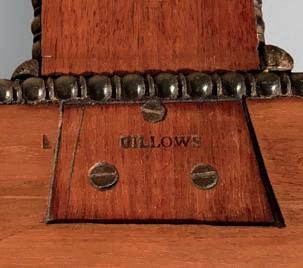
Lancaster and London 17301840, 2008, published by the Antique Collectors’ Club. Plate 669 on page 199 of Volume II shows one of a pair of salver stands, dated c. 1825-1830.
e split baluster turning on this pair is identical to the turnings of those shown in the illustration.
In this instance, however, there can be no doubt as to the authorship, as they are stamped clearly on the back.
e stamp is the same one illustrated on plate 55, on page 95 of Volume I of Stuart’s book, showing the stamp and date as one used only between 1823 and 1830.
David Harvey is the owner of Witney-based W R Harvey & Co. (Antiques) Ltd. For more details go to the website www.wrharvey.com
ANTIQUE COLLECTING 17
‘Sadly, there is no traceable provenance for this pair of stands but if I ever have a few days free I might venture into London to view the Gillows archives which are available to view at the Westminster Central Archives’
HOUND for HOUND
Above Rosa Bonheur’s (1822-1899) portrait of her French otterhound Brizo, the namesake of the ancient Greek goddess who protected sailors, mariners and shermen, © e Wallace Collection

Right omas
It was from the Renaissance onwards that it became fashionable for wealthy sitters to be represented with their dogs in a manner which allowed the artist to reveal more about the sitter. Dogs were seen as symbols of loyalty: Andrea Alciato’s Emblemata (1531) stated con dently that dogs mean delity, while Cesare Ripa’s Iconologia (1593) suggested “the dog is the most faithful animal in the world, and beloved by men.” Dogs were also synonymous with high social status and wealth, for only such people could lavish attention of this sort on their dogs.
Dogs appear in works by Van Dyck, as well as Titian, Velázquez and Rubens, their addition lent an informality to the scene while allowing the artist to introduce an element of wit as well as challenging their naturalistic skills in a di erent way.

e breed most associated with Titian’s paintings is the papillon (named after its butter y-like ears), also known as a “Titian spaniel”. e diminutive size of such toy dogs was perfect for images of children, while Velázquez tended to prefer mighty Spanish masti s in his hunting portraits of the Spanish royal family.
Hunting hounds
It was in the 17th century that dog portraiture acquired such stature that the representation of the dog alone was enough to indicate the nobility of the family that owned it.
Dog breeding was an obsession among the wellestablished landowning families and, by the second half of the 18th century in England, dog portraiture was ourishing. Landowners and aristocrats were a uent enough to commission stand-alone portraits of their favourite dogs.
e hunting set enjoyed a special relationship with their dogs, distinct from that of their French counterparts –perhaps due to di erent approaches to the sport. Shooting in Britain was a more solitary pursuit, carried out by a squire and his keeper with a few dogs. e performance of the individual dog, rather than the pack, became more important in determining the success of the hunt.
Hunting dogs were treated as prized possessions and objects of interest in themselves, becoming a status symbol of landowning and the landed English aristocracy.
omas Gainsborough
omas Gainsborough (1727-1788) had a countryman’s love of dogs and included them in numerous portraits and landscape paintings.
Gainsborough (17271788) Tristram and Fox, c.1775–1785, © Tate
Images
18 ANTIQUE COLLECTING
A new exhibition shines a light on how man’s best friend has been portrayed over the centuries. Antique Collecting takes a look and bones up on starting a collection
COLLECTING GUIDES Dog portraits
He also painted a few works where dogs were the central subjects. While most individual canine portraits were produced for their owners, he also painted his favourite dogs Tristram and Fox (named after the hero of Laurence Sterne’s novel e Life and Opinions of Tristram Shandy, Gentleman (1759–67) and the Whig politician Charles James Fox).
Gainsborough’s a ectionate portrayal of the two dogs, which he painted with warmth and spontaneity, shows them as sentient beings in their own right. A perception enhanced by the catch-lights in Fox’s eyes along with his part-opened mouth.
Executed with Gainsborough’s characteristic light and painterly brushwork, the pair are clearly seen as family companions rather than working or sporting animals.
Right Leonardo da Vinci (1452-1519) Studies of a Dog’s Paw (verso). National Galleries of Scotland, © National Galleries of Scotland

Below Jean-Jacques Bachelier (1724–1806), Dog of the Havana Breed, 1768, oil on canvas, French School, © e Bowes Museum, Barnard Castle
DA VINCI’S PAWS
Leonardo da Vinci’s (1452-1519)
fascination with animals is well known. In the 1490s he planned to make a comparative study of animals and men, including their movements and feet. But there is one particular canine detail over which Leonardo obsessed: the paw.
In a drawing executed in the early 1490s, he concentrated on the left forepaw of what is probably a deerhound, drawing it from a number of different angles.
In one drawing we see three separate studies of the same paw, including the five soft pads underneath. They are lively, sketchy renderings with the artist imparting an animated, almost electrical charge to the fur around the paw.
temperament and sociability and for their willingness to act as canine hot water bottles – happy as they were to sleep on the feet of their owners at the bottom of the bed. Pugs even became the symbol of a secret society called the Order of the Pug.
Lapdog mania
It wasn’t long before the trend in canine appreciation extended to the least energetic of the species. Lapdogs came into fashion with women in 18th-century France, particularly with popular gures such as Madame de Pompadour, Louis XV’s celebrated mistress, and Queen Marie Antoinette, wife of Louis XVI.
Both were well known for their love of papillons, pugs, bichon frises and Phalènes. Madame de Pompadour’s two Phalènes, Bébé and Mimi, were both portrayed by the French painter and artistic director at Vincennes and Sèvres, Jean-Jacques Bachelier (1724–1806). e extent of their indulgence is captured in a portrait of a Havanese.

Sitting up on her shaven hind legs, a bow in her hair, she is performing a trick for which she has presumably been rewarded; two coins have been placed in the foreground. She has evidently stolen her master’s slippers.
But their time in the sun was short lived. e French Revolution was unkind to pure-bred lapdogs. Considered totems of the ancien régime, they were actively eliminated or released into the streets of Paris and became common dogs trained to do tricks for popular amusements.
e other popular lapdog of the day in European aristocratic circles was the pug.
Introduced to Europe from China in the late 16th century, pugs were appreciated for their even
George Stubbs
e unsurpassed master of dog portraiture in Britain was George Stubbs (1724–1806). His extensive study of the anatomical make-up of animals through dissections, which he documented with precise anatomical drawings, enabled him to bring portraits of single working dogs, and later lapdogs, to a new level of sophistication from the mid-1760s onwards.
Stubbs undoubted skills meant he was quickly able to acquire patrons looking for something new in the painting of the sporting life of horses and dogs.
e group of clients Stubbs appealed to were young, extremely rich and in uential – deriving their wealth from country estates and their power from parliamentary seats.
‘The other breed of lapdog that was especially popular among European aristocratic circles in the 18th century was the pug. Introduced to Europe from China in the late 16th century, pugs were appreciated for their even temperament and sociability and for their willingness to act as canine hot water bottles’
ANTIQUE COLLECTING 19
FOND REMEMBRANCE
The architect Sir John Soane (1753-1837) was devoted to his wife’s dog Fanny. Following the death of his spouse in 1815, the Manchester terrier became his constant companion. When Fanny herself died in 1820, Soane buried her in a lead coffin in the courtyards of their house in Lincoln’s Inn Fields.

Two years later, Soane acquired a posthumous portrait of Fanny by the well-known animal painter James Ward (1769–1859). In classical pose, she sits on the capital of a column gazing towards a temple at the Parthenon in Athens.
Above Edwin Landseer (1802-1873) Doubtful Crumbs, 1858-1859, © e Wallace Collection
Below left James Ward (1769-1859), Fanny, A Favourite Dog, 1822. By courtesy of the Trustees of Sir John Soane’s Museum, London
Edwin Landseer
As a portrait painter of dogs Edwin Landseer (18021873) stands on his own. While contemporary sporting artists predominantly portrayed sporting dogs, Landseer developed a new brand that appealed to Victorian society. Using humour and satire, his ability to tell a story with moral values echoed literature of the time.
e image of the dog that he represented had strong parallels with the novels of Sir Walter Scott and Charles Dickens, where dogs have feelings and intelligence.
Landseer’s ability to humanise his dogs was one of the principal reasons for his success with collectors and the Victorian public. In one of his most popular works, known as Doubtful Crumbs or Crumbs from the Rich Man’s Table, two dogs of di erent sizes are humorously juxtaposed as the black-and-tan terrier looks longingly at a bone guarded by a dozing masti .

e title refers to the Parable of the Rich Man and Lazarus as told in the Gospel of Saint Luke (16:19–31) and would have been fully appreciated by the Victorian public.
When it was exhibited at the Royal Academy in 1859 critics from e Times reported “None but Landseer can thus render the human in the canine expression.”
e idea of dogs acting out a scene was to become Landseer’s speciality.
20 ANTIQUE COLLECTING COLLECTING GUIDES Dog portraits
e royal dog
For centuries dogs have been associated with the British monarchy: Richard Lionheart and Henry II both kept pet pooches, and the court of Henry VIII was so overrun by dogs that the king had to prohibit large dogs from entering.
Perhaps most dramatically of all, Mary, Queen of Scots, is even said to have hidden her small dog underneath her wide dress when she ascended the sca olding for her execution. Charles II famously allowed his spaniels to roam the grounds of the palace of Whitehall.
In his diary Samuel Pepys (1633–1703), an administrator of the navy of England, described the king’s behaviour during a council meeting: “All I observed there was the silliness of the King, playing with his dog all the while and not minding the business….”
Although every British sovereign was passionate about dogs, Queen Victoria had her pets immortalised in portraits and photographs to an unprecedented degree.
Landseer and Queen Victoria
In 1836 a portrait of Victoria’s spaniel Dash, became the rst royal commission given to Landseer – a relationship between patron and artist that transformed dog portraiture to a new level of sophistication.


Under Victoria’s patronage Landseer painted more than a dozen portraits of royal pets, mainly dogs. In his lifesize group portrait of Dash, Nero and Hector he positioned the dogs in a sumptuous domestic interior surrounded by the symbols of wealth. Landseer here introduces us to Queen Victoria’s favourite dogs and parrot, the low viewpoint making us feel part of their sumptuous and privileged world.
Victoria described the painting as “the most beautiful thing imaginable” when she saw it before it was exhibited at the Royal Academy in 1838.
Landseer also gave Victoria and her husband Albert
drawing and etching lessons during the early 1840s, enabling them to portray their own dogs. Both were competent artists – Victoria probably the more gifted.
Changing perception
is public interest for Queen Victoria’s dogs went hand in hand with a changing perception of the dog in society. While some dogs were fortunate enough to be pampered in the grand houses of the nobility, the expanding middle and urban working class were becoming able to a ord nonworking dogs of their own. However, many dogs lived in horrible conditions.
Blood sports such as dog- ghting and bull-baiting were popular social entertainments attended by men from all social backgrounds. From a very young age, Victoria was actively involved in changing animals’ living conditions: in 1835, aged 16, she became the patron of the Society for the Prevention of Cruelty to Animals. In 1840 she directed that it should enjoy the pre x ‘Royal’, a move that encouraged others to support the society.
In her modern kennels at Windsor Great Park all dogs got the same treatment, and she did not allow ear-cropping or tail-docking, which were common practice at the time. With the rising awareness of the mistreatment of dogs, blood sports were prohibited by an Act of Parliament in 1835. e kennels housed more than 100 dogs, among them breeds that were new to this country. Following royal example, dachshunds, Pekinese and Dandie Dinmont terriers became popular. e best loved of their dogs –Albert’s greyhound, Eos; Victoria’s Skye terriers, Islay and Cairnach; Victoria’s dachshunds, Waldmann and Waldina; the Sussex spaniel, Tilco, were all painted. Taking the lead from the royal family, dog portraits had nally come of age.
ANTIQUE COLLECTING 21
Left Edwin Landseer (1802-1873) Hector, Nero and Dash with the Parrot Lory, 1838 Royal Collection Trust, © His Majesty King Charles III 2022
Below right Edwin Landseer (1802-1873) Queen Victoria’s Spaniel ‘Tilco’, 1838 Anglesey Abbey, © National Trust
‘While some dogs were fortunate enough to be pampered in the grand houses of the nobility, the expanding middle and urban working class were becoming able to a ord non-working dogs of their own’
e Queen and her Corgis
Almost coinciding with Portraits of Dogs from Gainsborough to Hockney, The Wallace Collection opens its doors (from March 8 to June 25) on a special exhibition of photographs of the late Queen Elizabeth II and her corgis.
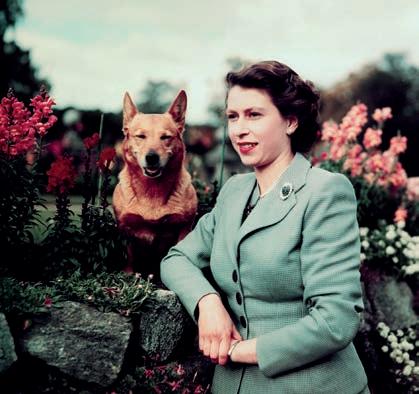
David Hockney
Some 150 years later, David Hockney painted a series of 40 paintings of his dachshunds, Stanley and Boodgie, over a two-year period beginning in 1994.

By portraying the two dogs sleeping, or at rest on their vibrantly coloured cushion, Hockney creates a strong sense of intimacy and immediacy. Before he began painting, the artist made several studies of the pair. In order to quickly sketch them he positioned piles of paper aound the house. Hockney shows them behaving naturally, as pets at home, in a posture of total relaxation, as opposed to sitting like models for a portrait – in what has become an informal mutation of the 18th-century dog portraits of Stubbs and Gainsborough.
He wrote: “ ey’re like little people to me. e subject wasn’t dogs but my love of the little creatures.”
Portraits of Dogs from Gainsborough to Hockney runs from March 29 to October 15 at e Wallace Collection, Hertford House, Manchester Square, London, W1U 3BN. For more details go to www.wallacecollection.org
Above David Hockney, Dog Painting 30, 1995, oil on canvas, © David Hockney, photo credit Richard Schmidt Collection e David Hockney Foundation
Top right Queen Elizabeth II at Balmoral Castle with one of her Corgis, September 28, 1952 (Bettmann Archive via Getty Images)
Above right Princess Elizabeth at home in 145 Piccadilly, London, July 1936. (Photo by Lisa Sheridan/Studio Lisa/ Hulton Archive via Getty Images)
Britain’s longest-serving monarch is often remembered for the famously close association she developed with Pembroke Welsh corgis, owning more than 30 of the breed throughout her 70-year reign.
Her passion started in 1933 when the 17-yearold princess was given a pair of corgis, Jane and Dookie, from her father, the future George VI. The earliest image in the exhibition dates from July 1936 and is of the future queen playing with the pair in the large garden of 145 Piccadilly – the London house where she spent her childhood.
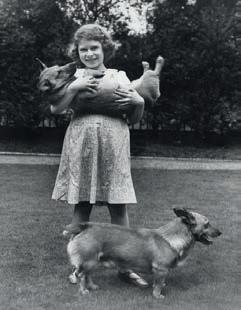
Dorgi owner
As an 18th-birthday present, her father gave the princess a corgi called Susan, the animal from which many of her later dogs were descended.
As well as corgis, the Queen also kept dorgis, a breed which came about when one of her corgis had a chance encounter with Princess Margaret’s dachshund Pipkin.
One of the photographs, dated October 15, 1969, shows the Queen with four corgis in tow, returning from Balmoral to meet the astronauts of Apollo 11 at Buckingham Palace.
Perhaps the most heart-rending image was taken at the Queen’s funeral when two of her corgis, Muick and Sandy, were caught on camera outside her committal service at Windsor.
22 ANTIQUE COLLECTING
Dog portraits
COLLECTING GUIDES
‘Hockney shows his dogs behaving naturally, as pets at home, in a posture of relaxation, as opposed to sitting like models for a portrait’
LEADING the WAY
People love pictures of dogs. Be it because of their breed, a reminder of a well-loved family pet, or as a sporting companion, they all symbolise loyalty and faithfulness. ey truly are man’s best friend, and we love to see them immortalised in paint or bronze.
Of all the sections in our sporting art and wildlife sales, the dog section has held up best on prices. While most traditional genres have come down in price over the last 15 to 20 years (19th-century works in particular) this has been the most enduring.
One of the reasons is that dog paintings cover such a diverse array of styles and genres that can appeal to almost anyone.
In our regular sporting art sales, one of the most popular forms of dog painting is that of a hunting companion, often seen in action, chasing down or retrieving their quarry.
Such paintings came to popularity in the 19th century with works by artists such as Edwin Landseer (1802-1873) and Richard Ansdell (1815-1885), with many other Victorian and Edwardian followers of their style.
Look out for the work of John Emms (18441912), who painted foxhounds and more sentimental dog portraits or packs in stables. His record for an artwork sold at auction sits at just under £450,000.
Current market
Prices for dog portraits peaked in the early 2000s when Bonhams was enjoying recordbreaking sales in New York. While it is true to say there is less of a market for sporting art today (with fewer people taking part in it as a pursuit), when a quality piece comes to market it will still generate strong bidding. e
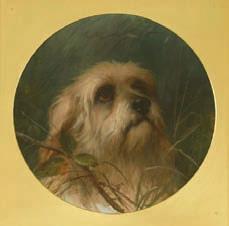
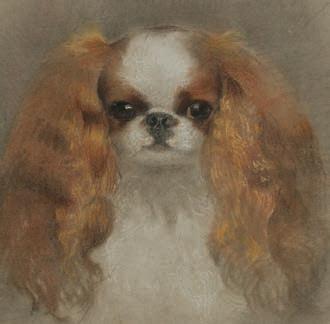


popularity is su cient to ensure a number of artists working today are increasingly sought after by collectors.
John Trickett (b.1953) is a popular contemporary artist whose paintings of hunting spaniels are dramatic and well-observed. Spaniels – be it cocker, toy or springer – are a popular breed, with so many of us owning them (I include myself among their number). So it is no wonder Trickett (below left) sold recently for £2,470, including fees.
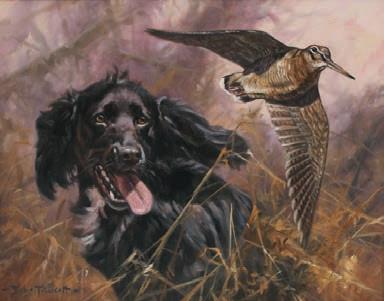
combination contributed to a very strong price of £3,770 and it was bought in the end by the Kennel Club for its collection.
e cute factor
Bull terriers have also been popular breeds in recent sales, with a painting by Ralph Bowen (1875-c.1951) recently selling for £2,470. In this case, we know nothing about the dog, and the artist is not well known. But the dog is well painted and is very representative of the breed. In the same vein, George Earl’s In the Brambles, was also ercely contested in the room, selling for or £5,980, more than twice its pre-sale estimate of £2,000-£3,000. e reason? It’s absolutely charming, the dog’s eyes are beautifully rendered and any dog lover will know that look.

But hunting is not to everyone’s taste and there are other collectors who prefer to look for a particular breed.
Just as lapdogs were frequent subjects in the last century, today we achieve remarkable prices for King Charles spaniels. A collection of studies of the breed by the husband of the wellknown breeder, e Hon. Mrs Neville Lytton, recently sparked a bidding war between a New York collector and a European breeder to sell for thousands rather than the hundreds they were expected to sell for.
Dogs with pedigree
Known dogs can also attract high prices.We recently achieved a very strong price for the portrait of ‘Crib’ a Dalmatian, by George Earl (1824-1908). Not only was the dog a prize winner and well listed in the Kennel Club, but he was also owned by R.T.L Price, a famous

is winning
e secret to a good animal portrait is to make the subject look like an animal and not a painting of an animal; a surprisingly di cult achievement, but when it’s done well, it is magical. So when it comes to buying look for the dog you nd appealing and that works as a picture, the chances are someone else will too.
Sworders next sporting art, wildlife and dogs sale is on June 6 with the date for the last consignment on April 21. For more details go to www.sworder.co.uk
ANTIQUE COLLECTING 23
Sworders auctioneer’s head of painting and sporting art, Jane Oakley, reveals the never-ending appeal of pooch portraits
‘Spaniels – be it cocker, toy or springer – are a popular breed, with so many of us having them (I include myself among their number)’
owner and Kennel Club judge.
Below John Trickett (b.1953) A spaniel ushing a woodcock, signed oil on canvas, sold for £2,470 in 2020, image courtesy of Sworders
Below Ralph Bowen (1875-c.1915) Study of a bull terrier, signed, oil on canvas, expected to sell for £300£500, it sold for £2,470 in 2020, image courtesy of Sworders
Above Neville Stephen Lytton (1879-1951) Champion Windfall, a Blenheim chestnut and white toy spaniel, sold for £2,600 in 2020, image courtesy of Sworders
Above George Earl (1824-1908) ‘Crib’ A Dalmatian, oil on canvas, sold for £3,770 in 2019, image courtesy of Sworders
Above right George Earl (1824-1908) In the Brambles, signed, oil on board, sold for £5,980, close to twice its top estimate in 2019, image courtesy of Sworders
Q&A
We asked Xavier Bray, the director of The Wallace Collection (and owner of Bluebell, Lady Wallace and Winston) for his exhibition highlights
QCan you spell out the Wallace Collection’s links with dogs?
ASir Richard Wallace, the founder of the Wallace Collection, was passionate about all things canine, and his dog, Snipe, went with him everywhere. As many as 907 dogs appear in the artworks he collected with his father, the 4th Marquess of Hertford, and a selection of his most brilliant portraits feature in the exhibition.
QWhat was the inspiration behind the exhibition?
ADog portraiture, in more recent years, has come to be described as simply ‘sporting art’. However, this exhibition, the first major show to exclusively display portraits just of dogs, seeks to encourage a reappraisal of the genre and a celebration of the special relationship between humans and their four-legged friends.
QHow many dogs are featured?
Which breeds tend to be most represented artistically?
AMore than 50 dogs, of all sorts of breeds, are in the exhibition. Terriers and spaniels make regular appearances.
QWhich breeds were viewed as the most highbrow, noble, etc
AKings, queens and aristocrats have kept all sorts of dogs. From toy breeds that provided comfort at court, to large breeds that worked landed estates, dogs have been loyal confidants to the coroneted for centuries.
QHow does the exhibition chart the arrival of different breeds, and their popularity, in the UK?
ASome dog breeds have become popular at particular moments in time, usually as a result of the ebb and flow of fashion, but sometimes because of world events.

This might be something our visitors pick up on when they walk around the exhibition, particularly when they explore the history of the Pekinese. Brought to Britain following the looting of Beijing’s Summer Palace by British and French soldiers in 1860, they became sought after for their unique appearance and association with the Chinese imperial family.
Unfortunately for many, today’s popular breed of Labradors don’t appear in the exhibition. Had there been more space, we would have loved to have included Mrs Bowes’s Labrador from the Bowes Museum.
QHow do portraits reflect social attitudes to dogs?
ACanine portraits say as much about owners as they do dogs. People celebrate their pooches through art for a whole range of reasons, perhaps because they were a particularly cherished friend or a good working dog. Artists also used dog portraiture as a means of expressing identities and interests, as well as reflecting on the human condition.
QWhat particular skills do dog portraits demand of the artist? A

Portraying dogs requires great skill.
To render their form and behaviour convincingly, artists typically draw dogs from life, observing small details and mannerisms, then translating them to paper, canvas or sculpture.
QHow has our attitude to dogs changed since the pandemic?
ADuring the pandemic, we saw an enormous increase in dog ownership. People wanted the company and to spend time with their dogs.
Having a dog also allowed them to take a walk around their local park. Since then, the bond has become stronger.
Having said that, a volunteer from Battersea Dogs & Cats Home knocked on my door yesterday saying they needed money for all the dogs abandoned after lockdown.

QHow would you ‘sell’ the exhibition to non-dog lovers?
AAlthough the exhibition has a sentimental element, it is also an important study of portraiture from Antiquity, through the Renaissance and the 18th century, to modern artists, like Freud and Hockney. It also explores how generations of artists have challenged themselves to represent the distinctive spirit of dogs.
QHave you got a favourite picture?
AOne of my favourite artists is Rosa Bonheur, a trailblazing painter who defied conventions in 19th-century France.
Her ability to capture canine likenesses with an unsentimental naturalism is extraordinary. I am particularly fond of her picture of the otterhound Brizo, which features in the exhibition. It is remarkable for the way it depicts the dog’s gentle intelligence.

24 ANTIQUE COLLECTING COLLECTING GUIDES Dog portraits
‘Portraying dogs requires great skill. To render their form and behaviour convincingly, artists typically draw dogs from life, observing small details and mannerisms, then translating them to paper, canvas or sculpture’
Above Dr Xavier Bray with this pugs Bluebell, Lady Wallace (left) and Winston (right)
Right Rosa Bonheur (1822-1899) detail from Brizo, A Shepherd’s Dog, 1864, © e Wallace Collection
Below Charles Burton Barber (1845–1894) Minna, c. 1873 Royal Collection Trust, © His Majesty King Charles III 2022


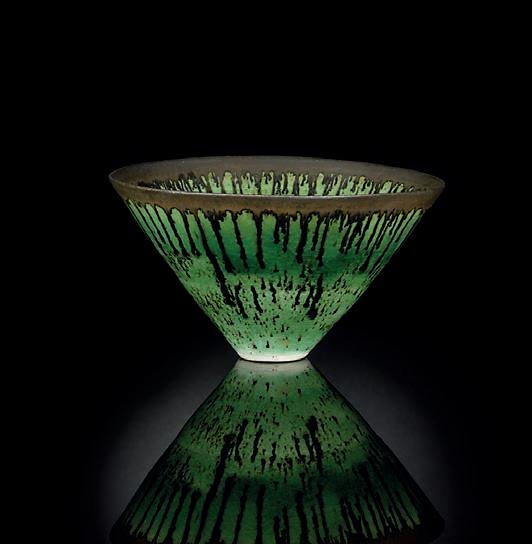


SUBSCRIBE TODAY • SUBSCRIBE TODAY • SUBSCRIBE TODAY • SUBSCRIBE TODAY • SUBSCRIBE TODAY • SUBSCRIBE SUBSCRIBE TODAY • SUBSCRIBE TODAY • SUBSCRIBE TODAY • SUBSCRIBE TODAY • SUBSCRIBE TODAY • SUBSCRIBE BOOK OFFERS ANTIQUE TEXTILES COME TO AUCTION PERIOD OAK ON SALE ALSO INSIDE A Gillows stand in the spotlight • Auction results • Columnists ANTIQUE COLLECTING VOL 57 N0.9 MARCH 2023 Ticket to ride e sports stubs taking marketthe by storm GLAZE of GLORY Inside: NATIONAL TREASURE HENRY SANDON’S COLLECTION UNDER THE HAMMER BARKING MAD THE REASON WE CAN’T GET ENOUGH OF DOG PORTRAITS POTTERY BY THE MARTIN BROTHERS IN THE FIRING LINE Women Artists 3 Every collector should know about Why work by the pioneering potter Lucie Rie has the market in a spin Ceramics special MARCH 2023 Behind the scenes at two important exhibitions taking place this month SAVE 33 PER CENT AND GET 10 ISSUES A YEAR FOR JUST £25* PLUS a FREE BOOK when you subscribe to Antique Collecting SUBSCRIBE www.antique-collecting.co.uk/subscribe and enter code: ACMAR23 Subscribe today and pay JUST £25 for your rst 10 issues rather than £38. Plus receive a FREE copy of Oak Furniture e British Tradition by Victor Chinnery, worth £75* Each copy is packed with collecting guides and specialist advice. Don’t delay, this o er ends on March 31st. e o er applies to new subscribers and new gift subscriptions only. * O er applies to new UK subscribers only ANTIQUE COLLECTING 25 Only £2.50 per issue! THEPERFECT GIFTIDEA Subscribe Now! ANTIQUE COLLECTING MAGAZINE •Give the gift that lasts all year and save 33 per cent on an annual subscription •Plus receive a free copy of Oak Furniture e British Tradition worth £75, for you, or a friend
SAL EROOM SPOTLIGHT
Paul Beedham said: “ e time has come to move some of our pieces on. We have recently undergone a substantial storage reorganisation and felt it was an appropriate time to sell a selection of our family things. Some of which have been owned for up to 60 years.”
Many of the pieces being o ered in the sale on March 29 were collected from the mid 1960s to the mid 1980s.
Return to glory
ese were the glory days of period oak with both Bonhams and Christie’s holding several dedicated sales annually. But while oak prices started to plateau in 2000, all the signs are it’s time in the sun is returning.
Last year the Su olk-based auction house Bishop & Miller launched a series of specialist oak sales, recruiting David Houlston, formerly Bonhams’ oak expert, as a consultant, a distinguished pedigree which helped secure this month’s sale.
Paul Beedham continued: “You don’t have to live in a Jacobean mansion to enjoy early oak. I think it’s good to have an eclectic taste. e pieces on o er this month look good in di erent or more modern surroundings with other styles of furnishing.”

Baronial manors
e sale includes a number of panel-back chairs from the mid 16th to late 17th century – the most numerous type of early British chair to survive. eir longevity owes much to solid construction – with pegged mortise and tenon joints – and durable materials (chie y oak).
In stylistic terms, all these chairs, even the earliest, embody the classical style of architecture and design that arrived in England at the beginning of the 16th century. Chair legs and arm supports are conceived as columns and the frames are decorated with a broad repertoire of lunettes, guilloches, owerheads, vines and other foliage, all derived from the new decorative styles emanating from France and Italy.
Armchairs of the period were high-status objects for wealthy people – usually members of the provincial gentry; not necessarily aristocrats but certainly landowners and businessmen. Paul Beedham said: “ ese pieces would have been made for the hyper wealthy of the period. It’s a very specialised market and a very specialised taste.”
Early oak collector-turned-dealer Herbert Beedham and his wife, Norma, opened their rst antique shop in Baslow, near Chatsworth in Derbyshire in 1974, with their son Paul joining the business in 1977. By late 1979 the trio renamed the business Beedham Antiques Ltd., establishing a showroom at Holme Hall in Bakewell. Soon after, Beedham Antiques was a xture on the fairs circuit establishing a reputation as specialists in ne English and European 15th, 16th, 17th-century oak and early sculptural works of art. In 1997 the company relocated to Hungerford, establishing itself at Charnham Close.
Above An exceedingly rare and good Elizabeth I oak tester bed, Exeter, c. 1570. At the time of going to press the estimates were not available. Bidders are advised to check online
Right A rare Henry VIII oak parchemincarved co er (so-called because it imitates folded parchment), c. 1530

26 ANTIQUE COLLECTING
ANTIQUES UNDER THE HAMMER the Beedham Collection of period oak
For close to half a century the name Beedham has stood for high-quality period oak. is month 130 pieces from the family’s personal collection go under the hammer in Su olk
Of equal stature is a rare Elizabeth I oak tester bed, Exeter, c. 1570 (left), which is also part of this month’s sale. Paul continued: “ e bed would have been made for an important manor house or city merchant. e bedding in an Elizabethan house would probably have been the most costly item of wooden furniture in the home due to the elaborateness of the design, weight of timber used and carving. Beds were also a vehicle to display incredibly expensive fabrics which would have cost far more than the bed.”
Joint stools
Another stalwart of the period are joint stools, made in bulk quantities during the 16th and the 17th centuries, and one of the most versatile pieces of domestic furniture. Even though their use lessened over time, demand has surfaced yet again and now they are very sought after.
‘Joined’ or ‘joint’ stools were so-called because the framework is constructed entirely using morticeand-tenon joints. Predominantly four-legged, they joined both at the top by rails and a few inches above the floor with long stretchers often with intricate carvings.
They were used from about the mid-16th-century with usually six around a dining table, under which they could be tucked when not in use. While stools of average height (22in) were used to sit at a table, shorter versions were reserved for other common uses, such as foot stools.
AUCTION fact file
WHAT: The Beedham Collection
Where: Bishop & Miller Auctioneers, 19 Charles Industrial Estate, Stowmarket, Suffolk, IP14 5AH
When: March 29 from 10am
Viewing: March 24, 27, 28 from 9.304.30pm, March 25 from 9-12noon and on the day of the sale from 9am. Also online at www.bishopand millerauctions.co.uk
IN MY OPINION...
We asked managing director at Bishop & Miller, Oliver Miller, for his sale highlights

Why is the sale so special?
This is the largest number of Tudor objects from a single owner to come on the market in recent years, with some of the pieces not having seen the light of day for many many decades. It’s a truly exciting prospect.
Over a 50-year period Beedham Antiques built up a reputation locally, nationally and internationally for its high-quality items of early oak furniture, with genuine colour and surface patination. The colour is rich on all the pieces making them true collectors’ examples.
As a category, is oak returning to favour?
Yes! Which is the reason why we decided to make period oak a centrepiece of our auction calendar. While rare, high-end pieces with provenance have always maintained their value, the mid-market is also starting to reinvigorate in an exciting way.
These pieces were made by highly-skilled craftsman and possess a deep integrity and outer beauty of which more people are becoming aware. Not only that, the style suits almost every interior, from antique to modern.
Which pieces might attract the more experienced collector
Top left A 16th-century elm and beech dome lidded casket, At the time of going to press the estimates were not available. Bidders are advised to check online

Above left A rare Elizabeth I oak joint stool, c. 1580

Right An extremely rare Elizabeth I oak armchair, with jester roundel to back board, c. 1580,

I would say the stand-out lots for the experienced collector would be the very rare chair with a Jester carved to the back panel (below). It excites me as it is not something we have seen before and is almost certainly unique. We also have a fabulous tester bed that is breath-taking in quality. Once again it is something that is rarely seen in the saleroom.
Do you have a favourite piece? For me it has to be the Elizabethan joint stool. I have always been drawn towards joint stools and this one is a cracker. As a relatively affordable piece of early oak furniture the market for joint stools is seeing a return to form.
Not only are they attractive, they are really practical pieces of furniture – even in the modern home.
ANTIQUE COLLECTING 27
‘Armchairs of the period were high-status objects for wealthy people – usually members of the provincial gentry; not necessarily aristocrats but certainly landowners and businessmen’
BROTHERS WHIM
150 years since the inauguration of the famous Martin Brothers pottery and a century on from the death of Robert Wallace Martin, a new exhibition and sale puts their incredible work in the spotlight
Coming across a Martin bird for the rst time is rather like seeing a naturist photobomb a wedding photo. Amid all the high-blown, serious art the Victorian era was famed for, their sly-eyed, avian cheek seems to cock a snook at the sombre, stovepipe hat-wearing sensibility of the age. e story becomes even more beguiling when we delve into their history and that of their penniless and eccentric creators – four brothers: Wallace (1843-1923) - after whom the famous “Wally” birds were named; Charles (18461910), Walter (1857-1912) and Edwin (1860-1915).
As well as penury, the siblings were dogged by
preposterous bad luck and illness. Charles ended up in a lunatic asylum following a shop re, another brother, William, died due to medical complications following a rally in support of Garibaldi, while one sister died aged 21 following a monkey bite.
Despite the popularity of their designs (Edward BurneJones and Dante Gabriel Rosetti were collectors, and Queen Mary ordered 60 pieces of Martinware for the Paris Exposition), Wallace wrote in 1910, “my brothers and myself never got more than a labourer’s wages.”
Despite this, the name of the Martin brothers is one of the most signi cant in the history of British pottery. Together, the unlikely, often fractious quartet was responsible for idiosyncratic, whimsical creations that would represent the peak of Victorian art pottery and the beginning of 20th-century studio pottery. For collectors, their wares remain among the most sought-after pots two centuries on.
Early days
ee brothers were four of nine children, part of a family who had its roots in Bury St Edmunds in Su olk. In the early 19th century their parents, Robert omas Martin and Margaret Fraser moved to London, where their large family took shape. Of their nine children, one died as a child, one emigrated to Australia, but four of the sons joined forces as potters. Head of the family concern founded in 1873 was Robert Wallace Martin (known as Wallace). Robert omas Martin’s work for a family of stationers meant the family moved from home to home in the capital. For most of his early years ‘Wallace’ grew up in the immediate environs of the newly rising Palace of Westminster and for a time he worked in the o ce of James Barry, the son of Charles Barry the architect of the Houses of Parliament.
Gothic in uence
Wallace’s early impressions would have certainly taken in the various Gothic grotesques and architectural nials of the nearby stonemason’s yard.
When con ned to bed following an accident in which his wrist was badly damaged Wallace’s ability with paper 1907,
Above Robert Wallace Martin for Martin Brothers, ree Birds in Harmony, 1907, incised marks to base and to each head ange R W Martin & Bros, London & Southall 1907, 20cm high, sold for £60,000, image courtesy of Kinghams

Right Robert Wallace Martin for Martin Brothers, a stoneware creature, 1885, signed R.W Martin & Bros, London & Southall, image courtesy of the Metropolitan Museum of Art
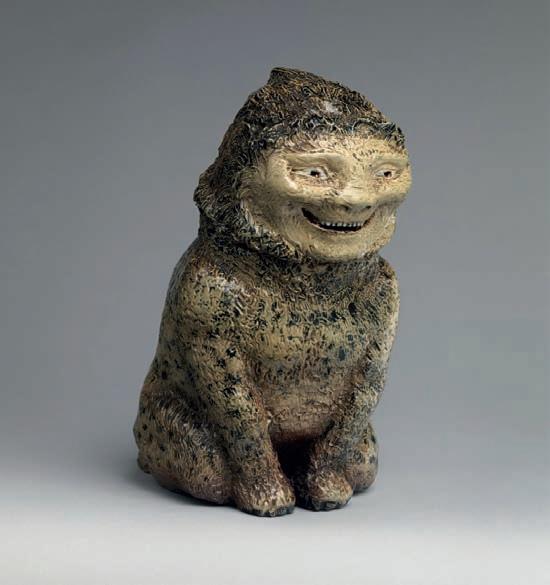
28 ANTIQUE COLLECTING
COLLECTING GUIDES Martin Brothers
supplying Gothic ornaments and restorations to churches throughout the land.
While there he noticed an advertisement placed by the Lambeth School of Art, an institution created for educating working class boys in technical and engineering draughtsmanship, led by its principal John Sparkes. Once enlisted it was here Wallace met the young George Tinworth, future pioneer of art pottery at the Doulton factory, Lambeth.
Sewage works
At this time the ceramics industry of Lambeth and south London was overwhelmingly commercial, mainly manufacturing salt-glazed stoneware agons, asks, drinking vessels, mugs and jugs. e major manufacturers of the mid 19th century were George and Henry Doulton, specialising in sanitary and industrial ceramics, their business expanding rapidly on receiving contracts including the modernisation of the Paris sewage system.
Flush with recent success and prompted by John Sparkes, Henry Doulton decided to venture into the art market, eventually recruiting a number of Lambeth students as ceramic designer-makers. e rst of these was the promising pupil George Tinworth, joining the enterprise in 1866. Six years previously, however, the birth of another Martin Brother, Edwin Bruce, temporarily caused the then 17-year-old Wallace to switch his attendance at Lambeth to nights while by day working in the studio of sculptor Alexander Munro where, in addition to helping the artist, he began to produce his own terracotta creations.
Salt-glazed stoneware
Wallace’s e orts were encouraging, occasionally winning prizes and soon he left Munro to set up his own workshop. For a brief period in the early 1870s Wallace worked for the Fulham company of C.I. Bailey, learning the trade of salt-glazed stoneware. Stoneware is a much harder material than terracotta: it is red to a higher temperature rendering the clay impervious to water. Furthermore by throwing salt into the kiln during the ring a ne lustrous glaze of ‘orange peel’ texture forms on the ceramic surface. Combined with washes of coloured slip and details touched in certain metal oxides (such as iron for brown, cobalt for blue and manganese for purple) the piece could be given colour as well as sparkle.
Pomona House, Fulham
Above left Robert Wallace Martin for Martin Brothers, a stoneware dog jar, 1885, incised marks to the lid, R W Martin & Bros, London & Southall, 13cm high, sold for £40,000, image courtesy of Kinghams

Above Robert Wallace Martin for Martin Brothers, stoneware sculptural bird jar, 1880, modelled spoon-billed duck or penguin, incised marks to the head, sold for £36,000, image courtesy of Kinghams

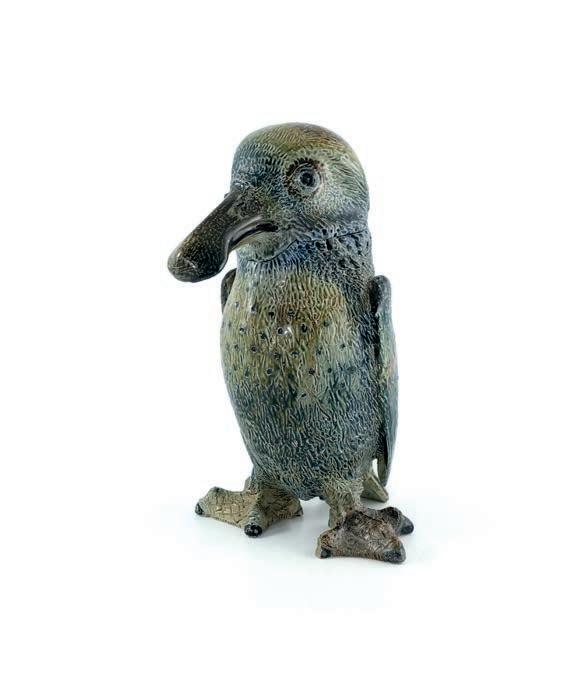
Right Robert Wallace Martin for Martin Brothers, a stoneware sculptural bird jar and cover, incised marks to base Martin Bros London and Southall, 1899, 28cm high, sold for £60,000, image courtesy of Kinghams
In 1873, on his purchase of Pomona House, King’s Road, Fulham, Wallace was joined by three of his brothers. Two years earlier, aged 14, Walter had joined the Doulton rm (at Tinworth’s suggestion) learning the skills of throwing, colouring, kiln setting and ring until an accident prevented him from continuing.
For a time, before she married, they were joined by their sister Alice as a colourist. Her place was taken by the youngest of the family, 12-year-old Edwin, who specialised in raised ornament as well as etching clay. Wallace’s own sculptural expertise was thus augmented by the two brothers’ knowledge of the stoneware processes while the fourth, Charles (1846-1910), was later to concentrate on his business and marketing skills with the opening of a shop in Holborn, central London.
ANTIQUE COLLECTING 29
‘As well as penury, the siblings were dogged by preposterous bad luck and illness. Charles ended up in a lunatic asylum following a shop fire, another brother, William, died due to medical complications following a rally in support of Garibaldi, while a sister died aged 21 following a monkey bite’
BEGINNING OF THE END
A letter, dated 1914, from Martin Brothers customers Reverend W.G.Beardmore to George Swinburne describes the poor start of the business. It was part of an archive sold by Roseberys auctioneers in December 2022.
The reverend writes: “Yesterday I went down to the Martins place in Brownlow St, Holborn; but I found the place closed. They have given up the shop; and now only to be found at their works in Southall - 10 miles from London! It is a very grave error of judgement. They are very unworldly and unpractical men in relation to business.
“Moreover, two of the brothers are now dead. One died very suddenly; and unfortunately with him died some of the most important secrets of the production, blending of clay, firing and colouring. He had rather foolishly kept much of this a secret even from his brothers, and left no written record. He also was ‘the thrower’, or chief man at the wheel of the potter.

“There are now only 2 of them left; and one of them has had an operation upon the tongue, suspiciously suggestive of cancer. The eldest one (Wallace) however is fairly well, but getting old. He is the one who makes the face jugs. The loss of the technical secrets which died with their brother, has left them nervous and terribly at sea. They were secrets which pertained to the soft glowing fusion of colour and the rich delicacy and subtle charm of surface. I find this lacking in their recent work.”
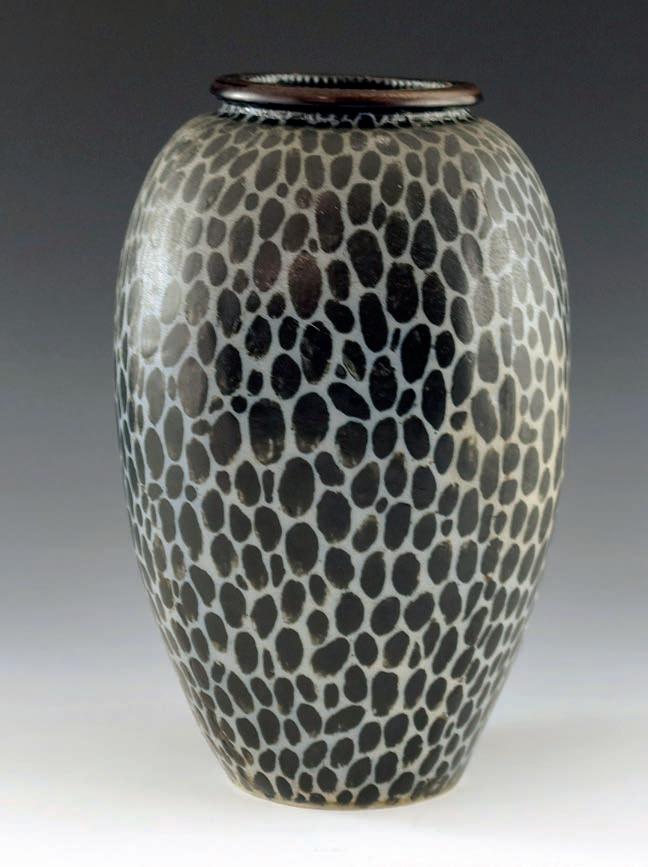
Move to Southall
For two years from 1874 the Martin brothers’ wares continued to be red at Bailey’s Fulham works as well as Shepherd’s Bush. But, from 1877, production issues and rising costs at both caused them to look for new premises. A friend who worked as surveyor at the Southall Brick Company introduced them to the west London area close to Ealing. ey soon found a disused soap works in Havelock Road, next to the canal. is was an ideal location because it was close to rail and canal, to their raw material and to their London markets. e brothers divided responsibility within the pottery; Wallace modelled the gures, Walter red the kiln, mixed glazes and threw pots with Edwin serving as the chief decorator.
30 ANTIQUE COLLECTING
COLLECTING GUIDES Martin Brothers
‘Throughout the 1890s – at the height of the brothers’ production – the, by then, famous birds continued, migrating as incised ornament on to hollow wares and vases. Wallace also embarked on the modelling of game and fish’
Above Edwin Martin for Martin Brothers, a stoneware gourd vase, 1878, 28cm high, sold for £2,000, image courtesy of Kinghams Left A large Martin Brothers jar with four birds, 1892, incised underside: R.W. Martin & Bro. / 3-1892 / London & Southall image courtesy of Metropolitan Museum of Art
Holborn shop
In 1879, requiring a presence in town, the brothers took on a salesroom in 16 Brownlow Road in Holborn and brother Charles was duly summoned from Reading to manage it. However, their nancial success was not helped by shop manager Charles, who became so rmly attached to their wares that he often hid pieces away from the gazes of customers and frequently refused to let potential buyers into the shop. Sadly, the shop was destroyed in a re in 1903, and Charles su ered a breakdown from which he would never fully recover.
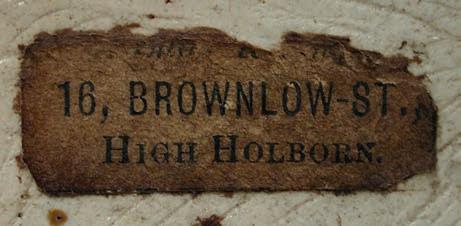
Wonderful grotesques
e 1880s saw the rst of the Martins’ truly eccentric creations, grinning wide-mouthed creatures, sometimes amphibian sometimes simian, which nominally served as spoon warmers.
While Doulton was into the mass production forms, each Martin animal was unique. Most popular of all the 1880s innovations – the Martin birds. ese were a rag-tag brood of hollow-bodied, standing tobacco jar sculptures modelled as sly-eyed, canny crows made to resemble on occasions their creator and his eccentric brothers.
Many examples are known to have been made to order and modelled on personalities. One pair, produced in 1886, bears a strong resemblance to Disraeli and Gladstone. Alongside these avian eccentrics we see the continuation of Japanese inspired agons, vases and teapots as well as jardinieres covered in renaissance-style grotesques.
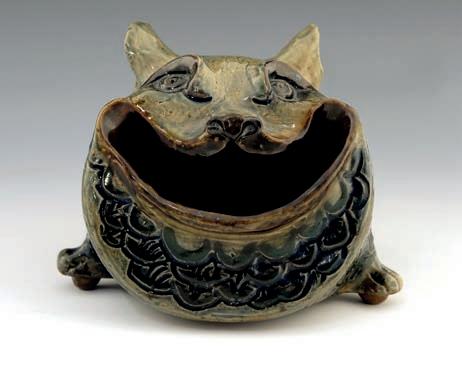
roughout the 1890s – at the height of the brothers’ production – the by now famous birds continued, migrating as incised ornament on to hollow wares and vases.
Wallace also embarked on the modelling of game and sh – an echo and tribute to the 16th-century ceramicist Bernard Palissy as well as face agons – themselves born out of the ancient Toby jug idea.
Right A Martin Brothers barrister face jug, signed RW Martin and Bros, c. 1910, height 17cm, sold for £4,400, image courtesy of Kinghams

Below left Robert Wallace Martin for Martin Brothers, a stoneware sculptural spoon warmer, c. 1885, incised marks 21 RW Martin London + Southall, 17cm long, sold for £15,000, image courtesy of Kinghams
Below right Clement and Robert Wallace Martin for Martin Brothers, a stoneware ribbed gourd vase, c. 1919, incised marks RW Martin & Bros, Southall, 22.5cm high, sold for £320, image courtesy of Kinghams

Decline and closure
But by the 1890s the tide of the Aesthetic movement was on the wane and the new tide of art nouveau came into view. e brothers adapted to the newlook with their use of urchin, seed pod and other organic forms. Fish and other aquatics provide inspiration for more abstract forms. Added to thisthe internal tensions between the brothers began to fracture. Between 1910 and 1915 Wallace’s three brothers died: Charles having been in an asylum since 1909, Edwin dying of facial cancer and Walter dying of a cerebral haemorrhage only three months later in 1912. The company closed in 1915. In the 1920s Wallace’s sonClement oversaw a brief (but unsuccessful)revival of the works producing wares based on originalmodels. But they sadly lacked the glazing effects so developed by Walter Martin.
Adapted from an article by Lars Tharp for a previous issue of the magazine.
ANTIQUE COLLECTING 31
Left A sales ticket from 16 Brownlow St in High Holborn
Q&A
In 2021 Kinghams Auctioneers in MoretonIn-Marsh sold the renowned Richard Dennis collection, including 29 Martin Brothers pieces. Director, George Kingham shares his market insights

QWhat are the most sought-after Martin Brothers periods?
AMartin Brothers collecting can be broken down into four distinct fields: most famously the birds and grotesque creatures almost exclusively sculpted by Robert Wallace Martin, the founder of the pottery, but thrown and glazed by his brother Walter. Next comes the vases with characterful fish and birds which were given almost human features and being anthropomorphic in design. Then come the gourd vases which were developed by Edwin Martin; organic forms inspired by nature. Lastly, the academics often prefer the early work which featured geometric designs and aesthetic style birds and flora and fauna. After their move to Southall, this work became more naturalistic in style - featuring the dragonflies, insects and bullrushes all present along the canal banks outside their studio.
QWho was the most talented of the brothers?
AEach of the four brothers had their own unique talent: The eldest, Robert, was a sculptor. Charles was the business man, promoter and salesman. Walter was the thrower and chemist, developing the glazes. He also fired all of the pottery. Lastly Edwin, the youngest, brought a new and more dynamic style to the pottery with his gourd forms and sgraffito work. Despite not getting along personally, the four talents came together to create great art in pottery form.
QHow has the market changed over the years? When were the boom years of collecting?
ABetween 1880 and 1905, the work of the four brothers was very desirable among the aristocracy and professionals, particularly politicians, barristers and judges. From about 1910, sales went
into decline and production stopped when WWI broke out. Interest in the work of the brothers was revived in the 1970s, championed by Richard Dennis. Richard staged a number of selling exhibitions and published Martin Brothers Potters in 1978. This led to a resurgence in the popularity of the brothers’ work which found new collectors worldwide particularly America, Japan, Canada and Australia as well as the domestic market. The popularity and collectability of their work has remained, with the birds and grotesque creatures being the most sought after.
QHow do you spot a fake?

AFakes exist; the most faked are the face jugs but, more recently, some vases with characterful fish and birds have emerged on to the market. Spotting a fake is relatively easy after handling many original pieces. However, for the more inexperienced eye, studying the glaze can be a good indicator. Glaze on a faked item will be sprayed on, giving it a uniform
Mark Marshall worked for both the Martin Brothers and Doulton Lambeth, and George Tinworth, another highly regarded sculptor for Doulton Lambeth, was a friend of Robert Wallace at art school. Other names to look out for among the Doulton elite are the Barlow Sisters - Florence and Hannah – and Frank Butler and Eliza Simmonds.
QHave you got a favourite design?
AA difficult question as I have handled so many amazing pieces over the last 25 years, including a toad which I sold to a private collector in New York for a world record price of $350,000 in 2016. Although I love all work produced by the brothers, my all-time favourite has to be a sculpted monkey jar and cover that I first sold about 15 years ago and again recently – the monkey has the most menacing grin on his face!
appearance. On a genuine piece, there are often firing flaws and inconsistencies in the colouration of the glaze. Don’t just go by the signature as these are often very well reproduced. As a percentage of pieces on the market today, probably less than one per cent are fakes.
QAre there any designs still affordable for collectors ?
A Vase prices start as low as the mid hundreds for naturalistic and gourd vases, with sculptural vases including snakes and faces commanding prices up to £20,000 to £25,000.
QAre there any lesser-known makers from the same era whose work is similar but still affordable?
A The pottery of Doulton Lambeth used the same salt-glazed stoneware and was produced by extremely talented artists but, due to the far higher output, today’s prices are often significantly lower than those of the Martin Brothers.

Kinghams Auctioneers will be holding a selling exhibition of Martin Ware and Victorian art pottery at its saleroom in Moreton-in-Marsh, Gloucestershire, GL56 0JQ, from March 27 to April 1 ahead of an auction on May 5. For more details go to www.kinghamsauctioneers.com
Above

32 ANTIQUE COLLECTING COLLECTING GUIDES Martin Brothers
‘Interest in the work of the brothers was revived in the 1970s, championed by Richard Dennis. Richard staged a number of selling exhibitions and published Martin Brothers Potters in 1978’
Above left An 1894 signed piece by the Martin Brothers
Robert Wallace Martin for Martin Brothers, 1876, an incised mask jug, sgra to decorated with a Green Man face, marked and dated 2 1876, 23.5cm high, it sold for £1,100, image courtesy of Kinghams














ANTIQUE COLLECTING 33 Contact: George Kingham 10-12 Cotswold Business Village, London Road, Moreton-in-Marsh, GL56 0JQ 01608 695695 adrian@kinghamsauctioneers.com www.kinghamsauctioneers.com MARTIN BROTHERS: ANNIVERSARY CELEBRATION EXHIBITION & AUCTION
TIME TO SELL? Connect with a global audience of buyers when you sell with Dawsons A LANDSCAPE BY SIR KYFFIN WILLIAMS SOLD FOR £16,000 A 1982 ROLEX EXPLORER II SOLD FOR £25,000 AN ART DECO STYLE DIAMOND COCKTAIL RING SOLD FOR £41,000 Contact us today dawsonsauctions.co.uk info@dawsonsauctions.co.uk 0207 431 9445
Exhibition and Talk: 27 March to 1 April. Auction: 5 May Entries Invited for both Events Catalogue Available for both events
FEMME FATALES
for many years. Four decades after her death, our London gallery brought Kean back onto the market with two retrospective exhibitions (in 1999 and in 2002) highlighting her life-long dedication to painting, and her ambitions and identity as a female artist.
While her work sold well at both exhibitions it was for considerably less than her male peers. It is only recently that Kean’s works have appreciated with buoyant sales at the Eye of the Collector Fair in London and rising prices at auction, including the recent sale.
Another artist working in France at the same time, Mildred Bendall, who received praise from Henri Matisse for her drawing skill, is also having her time in the sun. e Museum of Fine Arts in Bordeaux’s (her hometown) recent exhibition Into the limelight. Women artists in the Collection included four works from Whitford’s stock. At the same time, Bordeaux municipality woke up to the talent of one of its least recognised daughters naming a street after her, the Allé Mildred Bendall.
Cissie Kean (1871-1961)
Cissie Kean was born in London in 1871 into a wealthy family of German co ee merchants. Although her interest in painting was established at an early age, her family did not think that a career as a painter would be compatible with her social background.
However, after sustaining a severe injury during a riding accident as a young adult, the strong-willed Kean decided to dedicate her life to painting. In the 19th century it was a required apprenticeship for many male artists from Britain, continental Europe and America to spend some of their training years in Paris. But it was really only from the 1890s that women art students of various nationalities began to do the same in any numbers.
What Paris o ered, though, was a uniquely dense concentration of artists, teachers and studios; and the long-established annual exhibitions known as the Salons o ered a pathway to recognition, as did the various ‘alternative Salons’ of the later years of the century. Kean studied at the legendary Académie Julian, which o ered a free course for women only, where men could pose as models (wearing trousers) in 1876, and then nude.
For young women, the academy was the only alternative to the École des Beaux-arts, created in 1796, admission to which was forbidden to them until 1897.
With March 8 being International Women’s Day, now – as ever – seemed a good time to sing the praises of a 19th-century female artist whose name is known to few. With the market on the alert for undervalued women painters – particularly those operating in avant-garde Paris– it was no surprise that a painting by Elizabeth ‘Cissie’ Kean (1871-1961) recently sold for £7,600 at Mallams, Oxford, more than 70 times its low estimate. Whitford Fine Art has been championing both Kean and her near contemporary Mildred Bendall (1889-1977)
Above Elizabeth ‘Cissie’ Kean (1871-1961) Morning Boudoir, c. 1920, oil on canvas, all images unless otherwise stated courtesy of Whitford Fine Art
Right Elizabeth ‘Cissie’ Kean (1871-1961) Nude and Jug sold for £7,600 at Mallams, Oxford, image courtesy of Mallams


34 ANTIQUE COLLECTING
A painting by the avant-garde British artist Elizabeth ‘Cissie’ Kean, expected to make just £200, recently sold in Oxford for £7,600.
An Jo Fermon from Whitford Fine Art puts both Kean and another overlooked woman painter rmly on collectors’ radar
COLLECTING
GUIDES Women artists
Wartime artist
e work of the French Cubists André Lhote (1885-1962) and Jean Marchand (1883-1940) in uenced her painting during this rst Paris period. Before the outbreak of war in 1914, Kean travelled extensively to Italy, Spain and Brazil, meticulously recording her changing surroundings in her sketchbooks, which she then used as the basis for her nished watercolours and oil paintings.
During WWI, Kean returned to her family in London. Here, she set up a studio and travelled around England with her friends, fellow female artists Bertha Johnson (1846-1927) and Lila Sampson (b. 1882 . 1904-1922) and regularly attended painting groups. During the period 1916-1919, she found herself painting in Chipping Campden with New Zealand-born artist Frances Hodgkins (1869-1947).
Cubist in uence
After the war, Kean travelled back and forth between London and Paris, with breaks in the Mediterranean. During the 1920s, she was again working under André Lhote, once more exploring the human gure through the Cubist style. At the time, she was also attracted to the purism of the French artist Fernand Léger (1881-1955) and Amédée Ozenfant (1886-1966) in which objects are represented as powerful basic forms stripped of detail. Spending time with Léger she started experimenting with balancing representation and abstraction which the Cubists sought to maintain.


INVESTING IN WOMEN ARTISTS
Recalculating Art, an eye-opening programme on Radio 4 by Dr Helen Gorrill recently revealed that for every £1 a male artist earns for his work at auction, a woman earns a mere 10p, writes Maudji Llewellyn. While there are few aesthetic differences between men’s and women’s painting, there is a considerable disparity in the market.
However, there is some hope: according to Gorrill work by female artists is currently rising 29 per cent faster than for art by men (albeit starting from a lower base). Work by three female artists has recently seen a significant upturn at auction: Evelyn Dunbar (1906-1960), Ithell Colquhoun (1906-1988), and Tirzah Garwood (1908-1951).
When a surrealist work by Colquhoun was offered for sale at Sotheby’s in 1985 with an estimate of £1,000 to £2,000, it failed to sell. In 2018, it set a record for the artist when it sold for £30,745. At the same time, her male counterparts such as Paul Nash (1889-1946) were reaching close to seven figures. Last November one of Colquhoun’s works sold for £258,600.
Another comparison is looking at artist couples who worked together such as John Cecil Stephenson (1889-1965) and Kathleen Guthrie (1905-1981). Stephenson’s auction record currently stands at £47,500 while Guthrie’s stands at £3,000. Another beloved couple of Modern British Art, Eric Ravilious (1903-1942) and Tirzah Garwood (1908-1951), shows similar results. Ravilious’ turnover in 2022 was 24 times greater than Garwood – £338,000 to £14,000.
It’s clear that the demand for women artists is growing rapidly as collectors and buyers are gravitating ‘en masse’ towards the last remaining ‘untouched’ markets and under-appreciated names, but the window is closing on affordable art by women.
Maudji Llewellyn is a curator at at RAW (Rediscovering Art by Women) www. r-a-w.net
ree Arts Club
Back in London, Kean was one of the founding members of the ree Arts Club. In 1936, she moved to fashionable Fitzrovia which stayed her home until shortly before her death in 1961.
Despite her talent and determination, at the request of her family, Kean never promoted her work, and it was never commercially accredited. In keeping with her family’s wishes, she instructed her papers be destroyed after her death.
Much of the current knowledge comes from the diaries of her close friend Lila Sampson, an aunt of British artist Roger Hilton. Sampson recounts the time she and Kean spent studying art together in Paris before WWI, developing their skills.
Left Cissie Kean (18711961) Red Kite, c. 1925, signed with studio stamp verso, oil on canvas
Above Cissie Kean (1871-1961) Autumn Leaf, c. 1925, signed with studio stamp verso, oil on canvas
‘Kean studied at the legendary Académie Julian, which offered a free course for women only, where men could pose as models (wearing trousers) in 1876, and then nude. For young women, the academy was the only alternative to the École des Beaux-arts, created in 1796, admission to which was forbidden until 1897’
ANTIQUE COLLECTING 35
Mildred Bendall (1891-1977)
Bendall’s work was admired by Henri Matisse and Albert Marquet who appreciated her drawing technique. Under Matisse’s guidance, Bendall became a key component in the avant-garde group in Bordeaux.
Born in Bordeaux in 1891into a wealthy family she was the third and youngest child of the English merchant, Manley Forbes Bendall and Marie-Blanche-Elisabeth née Chrisman. e family’s apparent formality contrasted with their private non-conformism and, from early on, Bendall’s parents nurtured their daughter’s qualities of independence, individuality and sense of adventure.
Early promise
Bendall trained at the Bordeaux École des Beaux-Arts from 1910-1914 while attending private art classes of local fashionable painter Félix Carme. Bendall’s early paintings emulate the ‘Chardinesque’ style, conforming to the prevalent Academism of the time. In fact, in 1914 when her work Coin de Salon Bordelais won rst prize in the Peinture au Palmarès de l’Union Féminine de Bordeaux, critics hailed it as “worthy of Félix Carme”.
e work is exemplary of the taste of the local bourgeoisie and in stark contrast with the prevailing avant-garde movements of the then art world capital in Paris. Nonetheless, it shows Bendall’s solid grounding in drawing, technique, and composition.
Coastal views
Following her formal training, Bendall travelled around France, drawing and painting the local landscapes and architecture. She toured the Côte d’Azur, the Alps, the Dordogne and the Périgord; with her summers spent at the family holiday home in l’Herbe, an idyllic oyster village in the Bassin d’Arcachon where she painted some of her most enchanting
Left Mildred Bendall (1891-1977) Vue de Collioure, c. 1928, signed lower left, oil on panel

Below right Mildred Bendall (1891-1977) Red Sails, c. 1955, signed with studio stamp verso, oil on paper laid on panel

Below Mildred Bendall (1891-1977) Coin de Salon Bordelais, c. 1914, signed lower left, oil on canvas
Bottom left Mildred Bendall (1891-1977)
Nature Morte aux Masques, c. 1928, signed lower right, oil on canvas

Bottom right Mildred Bendall (1891-1977), Poissons Exotiques, c. 1955, signed lower right, oil on paper laid on canvas

post-Impressionist coastal views. At home in Bordeaux, she continued to paint her traditional still-lifes with paintings exhibited at the local Bordeaux Salon des Beaux Arts and the Musée des Beaux-Arts in Bordeaux.
In 1920, Bendall was admitted to the Salon des Artistes Français in Paris, which prompted her move to the capital.
Change in style
It was during this time that we see a fundamental change in Bendall’s style. In Paris, eastern European émigrés mixed with French avant-garde painters including Georges Braque, Alberto Giacometti, Pablo Picasso, Fernand Léger and Henri Matisse, forming the core of what would later become known as the École de Paris. During her time at the academy, Bendall developed a close friendship with Matisse which would leave a lasting in uence on her and her work. However, an unwelcome marriage proposal by Matisse’s son JeanGérard prompted her to return to Bordeaux.
Exotic sh
Under Matisse’s continued guidance, Bendall became an active force of the avant-garde in Bordeaux, building a real exchange between the provincial capital and Paris. In 1928, she helped found the Artistes Indépendents Bordelais as a countermovement against traditional Academism. Under her in uence, Braque, Matisse and Picasso all submitted paintings to its yearly exhibitions.
In 1937, the Galerie de Paris in Paris exhibited her work in their Jeune France exhibition, alongside works by Kees Van Dongen, Raoul Dufy and Max Jacob.
Following WWII, until her death in 1977, Bendall continued to develop her artistic style by introducing lyrical abstraction often inspired by crustaceans, leaves, or even the sails of regatta yachts. Alongside this she continued her gurative style with unusual underwater scenes of exotic sh and views of the La Rochelle harbour.
Whitford Fine Art manages the estate of Mildred Bendall and has many works by Cissie Kean, for more information go to www.whitford neart.com

36 ANTIQUE COLLECTING
artists
COLLECTING GUIDES Women
e lost Impressionist: Mary Cassatt
Left Mary Cassatt (1844–1926) Woman with a Pearl Necklace in a Loge, 1879, image courtesy of the Metropolitan Museum of Art

Above right Mary Cassatt (1844–1926) e Cup of Tea, c. 1880, image courtesy of the Metropolitan Museum of Art

Right Mary Cassatt (1844–1926), Young Lady in a Loge Gazing to Right, 1878-1879, shattered the artist’s 15-year-old record when it sold for £5.53m, image courtesy of Christie’s New York

Below left Filming for Mary Cassatt: Painting the Modern Woman in the National Gallery of Art in New York, image courtesy of Exhibition on Screen
Behind the painting
At the higher end of the market, prices for better-known women artists are also being shattered. Mary Cassatt’s (1844–1926), Young Lady in a Loge Gazing to Right smashed the artist’s 15-year-old record when it sold for £5.53m at Christie’s in New York, more than doubling its pre-sale estimate.
e work was once owned by Paul Gauguin, who said that “Mlle Cassatt has as much charm, but she has more power” than her female contemporaries.
A lm about the artist, Mary Cassatt: Painting the Modern Woman, directed by Ali Ray also launches in UK cinemas on March 8.

In one of Cassatt’s most famous works (above) the artist portrays an active female perspective in lieu of a passive male gaze. In her 1879 work, the use of a mirror behind the young woman predates a similar technique famously used by Édouard Manet (1832-1883) in his Bar at the Folies-Bergère painted in 1882.
Mary Stevenson Cassatt (1844–1926), born in Allegheny City (now part of Pittsburgh), Pennsylvania, spent her early years with her family in France and Germany. From 1860 to 1862, she studied at the Pennsylvania Academy of the Fine Arts. By 1865, she had convinced her parents to let her study in Paris, where she took private lessons from leading academic painter Jean-Léon Gérôme, copied works of the old masters, and went sketching. In 1868, Cassatt’s painting e Mandolin Player was accepted at the Paris Salon, the rst time her work was represented there. e FrancoPrussian War prompted her return to America in 1870.
Degas invitation

She returned to Europe in 1871 settling in Paris in 1874, where she began to show regularly in the Salons. In 1877 Edgar Degas invited her to join the group of independent artists later known as the Impressionists. e only American o cially associated with the group, Cassatt exhibited in four of their eight exhibitions, in 1879, 1880, 1881, and 1886.
During the late 1870s and early 1880s, the subjects of her works were her family (especially her sister Lydia), the theatre, and the opera. Later, she made a specialty of the mother and child theme, which she treated with warmth and naturalness in paintings, pastels, and prints.
Failing eyesight severely curtailed Cassatt’s work after 1900. She gave up printmaking in 1901, and in 1904 stopped painting. She spent most of the war years in Grasse and died in 1926 at her country home, Château de Beaufresne, at Le Mesnil- éribus, Oise.
ANTIQUE COLLECTING 37
‘In 1877 Edgar Degas invited her to join the group of independent artists known as the Impressionists. She became the only American officially associated with the group’
Puzzle TIME TEST YOUR KNOWLEDGE
Give your brain a spring clean with this taxing series of questions and a head-scratching crossword puzzle from Peter Wade-Wright
MARCH QUIZ
Q1 Flatware designers have always had a rich source of, changing and sometimes improving, eating ‘habits’. By 1898 the Towle Company ‘Georgian’ pattern included (to the closest gure) how many di erent pieces? (a) 130, (b) 140, (c) 150, (d) 160
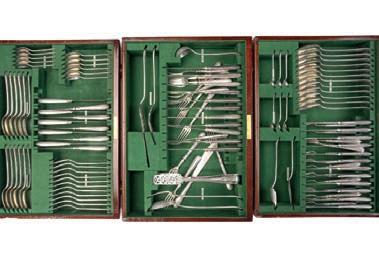
Q2 If you were a collector of certain artefacts described as ‘groving’, ‘sett’, ‘scroll’ and ‘mandrel’. Would they be associated with? (a) printing, (b) carpentry, (c) metal working, (d) calligraphy
Q3 We probably all know the colour of some stones used for jewellery…but match the following (A) cairngorm, (B) bloodstone, (C) carnelian, (D) chalcedony, with their typical characteristics. (i) esh red and translucent, (ii) golden brown and transparent, (iii) pale blue-grey and translucent, (iv) dark green with red blotches.

Q4 In the 16th century what was commonly called a ‘safeguard’? (a) a concealed dagger, (b) a type of guard-dog (often depicted in art) (c) a garment, (d) a braced wheel on coaches

Q5 On a sea chart ‘loxodromic’ refers to what? (a) shipwrecks to be aware of, (b) the course to be taken, (c) compass bearings to certain features on land, (d) whirlpools.
Q6 What are Nuremberg eggs, skeletons and Roskopfs? (a) kitchenware, (b) timepieces, (c) Victorian fashions, (d) cutlery designs.
Q7 e rst label stamp to mark an historic anniversary was produced in England. What was the celebration? (a) beating the Spanish Armada, (b) the Battle of Hastings, (c) the D-day landings, (d) Shakespeare’s birthday.
Q8 Cantus and leaf bracelet are popular patterns of (a) early 20th-century chocolate coloured glass, (b) 1930s American Paden City pottery, (c) religious jewellery motif, (d) furniture decoration.
Send your answers to Crossword, Antique Collecting magazine, Sandy Lane, Woodbridge, Su olk, IP12 4SD, UK. Photocopies are also acceptable, or email your answer to: magazine@ accartbooks.com. e rst three opened by March 10 will win a copy of Jackson’s Hallmarks, Pocket Edition: English, Scottish, Irish Silver & Gold Marks From 1300 to the Present Day, worth £6.95

Q9 During WWII, soccer programmes often contained the names of players who were not normally associated with that particular club. Why? (a) to confuse German spies, (b) to enhance games, (c) contracts were suspended and guest appearances allowed, (d) they didn’t play but were employed as team tness/skills instructors.
Q10 e ‘toucan’ and ‘penguin’ were what? (a) two celebrated 1920s artists’ models of speci c and striking physiognomy, (b) 1950s ashtray designs, (c) Art Nouveau Ti any jewellery, (d) 20th c. lamps.
Finally, here are four anagrams: cash aunt, chest de ler, vegan grin, peeled at sh. Rearrange them to form, in order (a) stylised, leaf-shape ornamentation, (b) deep-buttoned, upholstered settee, (c) decorative patterns cut into a metal surface, (d) silver substitute used from c. 1740 from fused silver and copper (two words). For the answers turn to page 10.
SOLUTION TO LAST MONTH’S CROSSWORD:
The letters in the highlighted squares are T, A, I, L, I, O, G and N, which rearranged spell the world Intaglio. The three winners who will each receive a book are Eric Morgan, Scarborough, by email; Louise Fenton, Congleton, by email and P.J. Jones (Mrs), Stafford.
38 ANTIQUE COLLECTING
Q1 Victorian cutlery sets could be huge, but how many did the Towle Company stretch to?
Q3 What gemstone is this bracelet made of?
1 2 3 12 5 11 13 4 7 6 9 10 19 17 22 23 14 16 24 25 15 8 18 20 21 F A IN E NOLE C EI N DO I ACNNON O E A E L G I OR O SEC H VI R E T R ESCOR A B B IN O C E O T NI A I F E LUTON D SCHE C O T R O LODI T E E B U D D
Across
1 Pillared book support. (7)
5 Long, often decorated and inscribed Varsity trophy. (3)
7 _____ stand. A small table, introduced in the mid. 18th century, for serving tea. (3)

8 The first European hard-paste porcelain. (7)
9 Writing/drawing material found on a stand. (3)
11 Loveable, but jumpy, character in Winnie-the-Pooh. (3)
12 Effie _____ (1828-1897). Married to Ruskin and then Millais. (She is portrayed above in a painting by Millais.) (4)

14 ______ Seyfried (b. 1985) American actress with an engraved Reverso watch (see August 2021 issue of Antique Collecting). (6)
16 Restraining jacket (for those over-excitable auction bidders?) (6)
19 Pre-flood patriarch and a very popular subject for many a painter. (4)
21 A ‘lug’ of winged 3-down furniture. (3)
23 Semi-solid material often mixed with acrylic paint to produce a rich glaze. (3)
24 Laurence _____ (1907-1989). One of the finest English actors of his generation. His memorabilia is most collectable. (7)
25 _____ group. Seated Staffordshire figures (produced from c. 1730-1740) on a high-backed bench. (3)
26 The fifth note of the tonic major scale. (3)
27 ______ of London (founded 1875). The interior of the famous stores pictured above right. (7)

Down
1 _______ porcelain. A general term for articles manufactured in the west-central area of France of the Haute-Vienne department and pictured above right. (7)
2 General name for porcelain reflecting its historic origin. (5)
3 Type of chair introduced in the late 17th c. Originally, upholstered,
high-backed and winged. Nowadays…just comfortable. (4)
4 The calling of the character played by Deborah Kerr in the 1947 film Black Narcissus. (3)
5 Popular edible bulb, and as ____ foot, a more American term for a bun foot. (5)
6 Fabulous Arabian bird that is said to have been able to carry off an elephant. (3)
10 Method of bidding at auction. (3)
11 The Hawk in the _____ (first published 1957) Ted Hughes collection of verse. (4)
13 A Journal of the Plague ____ (first published 1722). Daniel Defoe novel/historical account (mind you, he was five at the time described). (4)
14 Practical skill and its application. (3)
15 Indispensable article for those who moved from snuff to smoking. Many designers produced them, e.g. Lalique. (sing.) (7)
17 Support for a golf ball. In Samuel Pepys’ diary entry from September 25, 1660, he noted: I did send for a cup of ___ of which I never had drank before. His spelling. (3)
18 _____ Lauren. (b. 1939) Fashion designer of note and collector of classic cars. (5)
20 Any willow whose twigs are used for making baskets, for example. (5)
22 General term for a doll’s arm or leg, for example…or at auction, just to go out on one? (4)
23 Type of mask invented in 1847 (although an earlier, very basic model was made for miners in 1779). (3)
24 Bird amusingly used as the model for a condiment container (3)
Finally, rearrange the letters in the highlighted squares to form the name of the historic period (late 17th century) associated with furniture of various types etc. _____ and _____ (7, 4)
ANTIQUE COLLECTING 39
1 2 3 12 5 11 13 4 7 6 9 10 19 17 22 23 14 16 24 25 15 8 18 20 21
27
1
26 27
12 ACROSS CLUE
ACROSS CLUE
DOWN CLUE
NATIONAL TREASURE
e 1,000 piece collection of the Antiques Roadshow ceramics expert – and Worcester porcelain supremo – Henry Sandon, goes on sale next month
For millions of viewers his was the jovial and knowledgable face of the Antiques Roadshow impressing and astounding audiences with his ceramics valuations. Next month the Henry Sandon Ceramic Study Collection, featuring some of the expert’s own much-treasured Royal Worcester pottery, goes under the hammer at Chorley’s in Prinknash Abbey Park, Gloucester.
Made up of 1,000 pieces across 380 lots, the collection is expected to make £500,000.
Sandon, aged 94, who joined the Roadshow in 1979, wants other collectors to enjoy his life’s work.
He said: “Now I am older than most of the ceramics in my collection, I am no longer able to pick up and hold and cherish every one of the hundreds of pieces I have lived with all around me.
“I need other people to help care for me now and so it’s time to nd new owners to care for all my beloved pots. Apart from a few special favourites for my family to treasure, it is time for all of my pots to join new study collections.”
Early passion
Sandon’s lifelong love of porcelain and ceramics started in Worcester, a town he moved to when he started teaching at the local grammar school.
He said: “Once in Worcester I discovered ceramics everywhere. I dug up Roman and Medieval pots in my garden by the cathedral and was immediately captivated by their history.”
e hobby led him to auction houses and antiques shops in the city and sparked a lasting obsession with antiques and Worcester porcelain in particular.
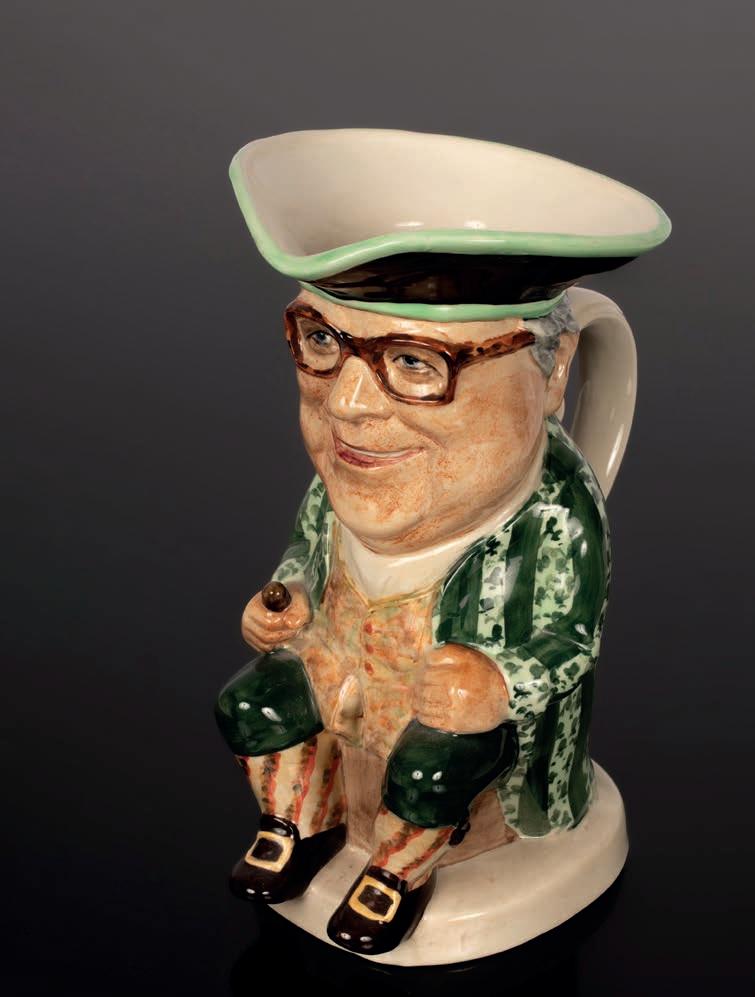
In 1967 he was appointed curator of the Dyson Perrins Museum at the Royal Worcester Factory, a position he held until 1982.
Valuable mentors
While Sandon taught himself valuable caramics knowhow, including the history of Worcester porcelain, he also had three valuable mentors each crucial in developing his passion: Jim Kiddell from Sotheby’s, the collector Dr Bernard Watney and the author and ceramics expert Geo rey Godden, some of whose numerous books is published
Sandon said: “All three told me that the best way to learn about ceramics was to form a study collection. It didn’t matter that I could only a ord damaged examples of the early pottery I coveted. I knew it was important to buy as much as I could and to hold it and live with it.”
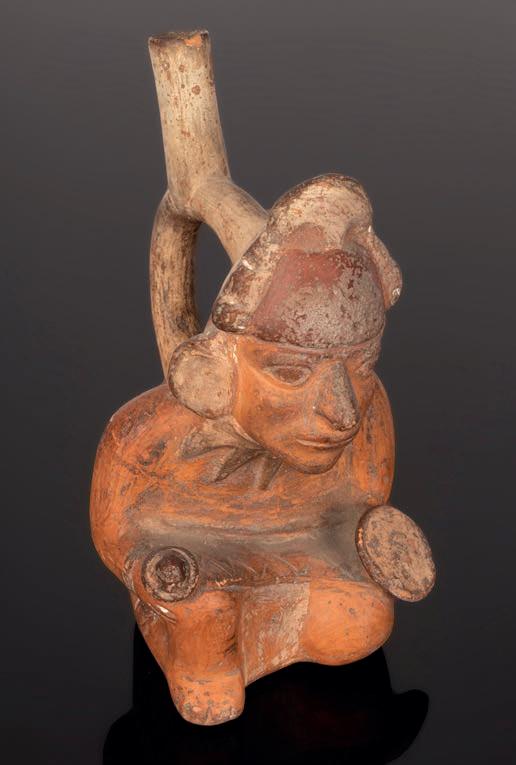
In the 1970s the trio of specialists were frequent visitors to the museum where Sandon worked and helped him identify nds from excavations on the site of the earliest Worcester china
He said:
“At the time, some 50 years ago, Worcester still had a ourishing
40 ANTIQUE COLLECTING
THE EXPERT COLLECTOR e Henry Sandon Ceramic Study Collection
Above A Toby jug modelled on Sandon himself was made by Sta ordshire maker Kevin Francis Ceramics, it has an estimate of £50-£100 at next month’s sale
Right A north coast Peruvian stirrup vessel, dating from 200-600AD. It is estimated at £300£400
china factory. I spent much of my time taking important visitors around the factory and meeting the great artists who had spent their entire lives working at the porcelain works.”
Going for a song
At the same time while attending local auctions Sandon became friends with the legendary antiques specialist Arthur Negus (1903-1985). Sandon went on to appear with Negus on Going for a Song and Arthur Negus Enjoys, before joining him on the Antiques Roadshow in 1979.

He said: “We got on really well and Arthur showed me that a passion and enthusiasm like ours would rub o on others, through lectures and through the new medium of television. e Roadshow gave me a chance to share my love of ceramics with a massive audience around the world.” Sandon appeared on the popular show for decades.
Harry Davis (1885-1970)
Alongside friendships with many of the greatest porcelain academics of the 20th century, Sandon also shared a cherished friendship with the legendary Royal Worcester painter Harry Davis, in his last years.
Davis, who died in 1970 when Sandon was 52, started at the Worcester factory aged just 13 and went on to be, according to Sandon and many others, the greatest porcelain artist of all time.
He became the Royal Worcester foreman in 1928 and
Above Henry Sandon with a dish commissioned by his three sons featuring Ozzie the Owl. Ozzie was a 17th-century slipware owl brought to a Roadshow in Northampton in 1990 and greatly admired by Sandon. e dish was designed by Sally Tu n and made for Sandon by Dennis Chinaworks. Image courtesy of the Sandon family
Below Proving his versatility as an artist, Davis painted Bradman at the crease in 1938 (image for illustration only, not in next month’s sale)
MODERN TASTE
Alongside many Royal Worcester pieces, the sale features more modern work, much of it by local Worcester potters. One such is a stoneware vase by the celebrated studio potter Geoffrey Whiting (1919-1988). Northumberlandborn Whiting trained as an architect but fell in love with pottery, later setting up a studio in Worcestershire.
A number of Whiting’s pots feature in the sale, including a slab-form vase (above) which Sandon lent to a Whiting retrospective exhibition in 1990. The vase, which has ‘resist’ decoration made using a lost-wax technique, carries an estimate of £300-£500 in next month’s sale.
Above Geo rey Whiting (1919-1988), slab vase, it has an estimate of £300-£500 in next month’s sale
known for his exceptional portrayal of sheep in a Highland setting – although he could turn his hand to almost every subject.
In 1938 Davis painted a vase, later known as the ‘Bradman Vase’, for the Australian cricketer Sir Donald Bradman to commemorate his three double centuries on the New Road Ground at Worcester (in 1930, 1934 and 1938). On its front panel Davis depicts Bradman at the crease and Worcester Cathedral in the background.
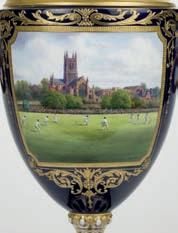

anks to Davis, Henry Sandon went on to enjoy a correspondence with the cricketer about his sport and the vase which Sandon travelled to Australia to see in 2004. One of the highlights of next month’s sale is a vase painted by Davis featuring a stag in a snow scene in experimental sunset colouring. Painted in 1921, Sandon acquired the vase from the artist himself, it is estimated to fetch £800-£1,200.
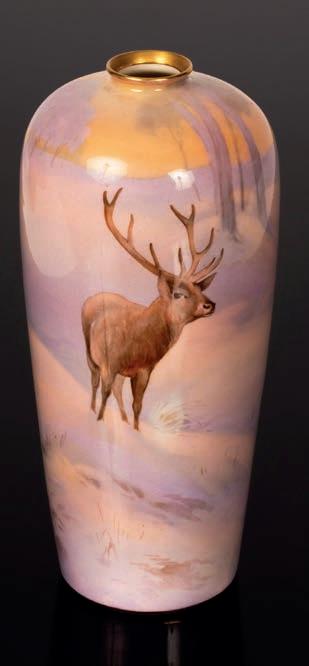
ANTIQUE COLLECTING 41
‘‘Sandon started attending local auctions where he met and became friends with the legendary antiques specialist Arthur Negus (1903-1985). Sandon went on to appear with Negus on GoingforaSong and ArthurNegus Enjoys, before joining him on the Antiques Roadshow in 1979’’
Right A Royal Worcester vase by famed Worcester artist Harry Davis (1885-1970), it has an estimate of £800-£1,200
Consigned for sale
It was in the early ‘70s when the auctioneer in charge of the sale, Simon Chorley, joined Bruton Knowles art and antiques auction business (renamed Chorley’s in 2006) and got to know Sandon.
Chorley said: “When I joined the rm Bruton Knowles I was under the wing of Arthur Negus. Henry often attended auctions and occasionally met and chatted with Arthur.
“After Arthur’s death in 1985, I was involved with arranging the auction of his treasured collection. Henry very much enjoyed that sale and it is now a privilege for me to be involved in arranging Henry’s sale.”
Over a glittering career, Sandon was interviewed on Desert Island Discs and has appeared on is is Your Life. In 2008, he was awarded the MBE in the Queen’s Birthday Honours List for his services to the ceramics industry, broadcasting and for his charitable work.
He sold part of his collection 40 years ago when he went to Canada as the director of e George Gardiner Museum in Toronto but has now decided to sell the rest as he is moving into a care home.
e sale of the Henry Sandon Ceramic Study Collection takes place at Chorley’s on April 18. For more details visit www.chorleys.com
Above Royal Worcester plate by Harry Stinton (1883-1968). It has an estimate of £1,000£1,400 in next month’s sale
Below left Sandon’s glittering career saw him appear in numerous TV programmes devoted to antiques
WORCESTER FAMILY
Among the many highlights is an important Royal Worcester plate by Harry Stinton (1883-1968), a member of one of the most famous Worcester families of artists.
The legacy of Stinton sons and daughters, who painted for the Worcester factories for a total of 158 years, spanning four generations, beginning with Henry Stinton in the early 19th century.
The most prestigious artists of the dynasty that still carry weight in the art market to this day are John Stinton senior (1829-1895), John Stinton junior (1854-1956), James Stinton (1870-1951)
John Stinton senior taught his three sons to paint, pioneering the technique of mixing paint with clove oil to stop it drying too fast while he painted on to the ceramics.
The innovation was passed down the generations, establishing the Stintons’ stylistic stamp over decades. It was his son John who developed his most famous subject – highland cattle in 1903, which kept him fully employed at Royal Worcester until he retired in 1938, aged 84.
Despite his undoubted skills he struggled to paint bovine feet, so many cattle have their hooves hidden in grass.
His brother James painted game birds, especially pheasants and worked at Royal Worcester until he retired in 1951.
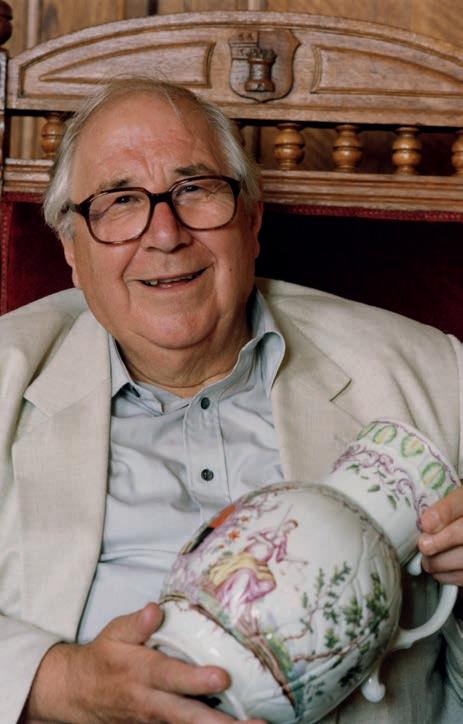
Harry Stinton (1883-1968)
The youngest brother, Harry, joined the Worcester factory in 1896 and studied under his father and learned to produce the same highland cattle scenes, although he used more purples and autumnal tints to differentiate them from his father.
The Harry Stinton plate in next month’s sale comes from a service commissioned in 1928 by the founder of another famous family, William Keith Kellogg (1860-1951) of the legendary cereal company. Kellogg ordered two sets, both comprised of 25 plates. The costly red background on the plates was chosen to match the colour of the famous Kellogg’s logo.
In 1985 Henry Sandon advised on the sale of the service, offered in sets of 12, with the ‘spare’ plate, featuring a watermill in a snow scene and signed by Stinton, going to Sandon’s collection.
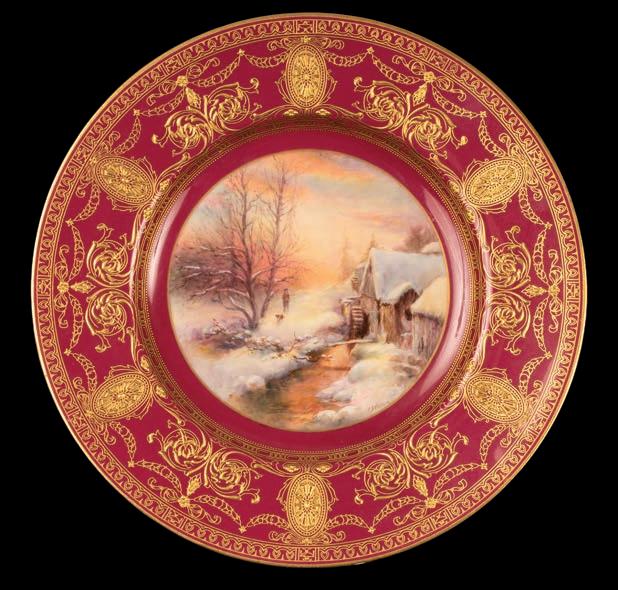
42 ANTIQUE COLLECTING
THE EXPERT COLLECTOR e Henry Sandon Ceramic Study Collection

Lucie Rie’s ceramics
We love Lucie
currently being presented, including the bene ts of allwomen shows and sales, as well as the ongoing debate between craft and ne art.
Rie’s work continues to astonish and inspire collectors today with many of her pieces achieving stratospheric prices at auction both in the UK and around the world. Prices reached a new high in 2020 when Phillips New York sold a 14cm diameter footed bowl, expected to make $25,000 to $35,000, for $180,000 (£136,800).
Chris Large, the ceramics expert at Peter Wilson said: “Demand for Lucie Rie has been consistently high and remains so, re ecting the appeal of her unique and much appreciated work.
“Part of the beauty of Lucie Rie’s work lies in its complex texture and varied decoration, and the pieces displaying her trademark brilliant glazes in rainbow colours such as peacock blue, magenta and gold remain particularly popular.”
Early years
Lucie Rie (1902–1995) may be one of the UK’s best-loved potters, renowned for the playful elegance of her work but due, in part, to the historical hierarchy of art versus craft her name still remains unfamiliar to many.

at is a situation set to change this month when Kettle’s Yard in Cambridge unveils a major exhibition celebrating Rie’s ground-breaking ceramics across six decades. It will feature more than 100 works from private and public collections, highlighting the singular nature of Rie’s artistic achievement.
Work by Rie also appears in this month’s selling exhibition at Sotheby’s Form: (Women) Makers, which explores the way in which pottery by female makers is
Below Lucie Rie (1902–1995), turquoise bowl with bronze rim, 1980s, stoneware. e Derek Williams Trust on long term loan to Amgueddfa Cymru-National Museum Wales. Images courtesy of Erskine, Hall & Coe; Photography by Michael Harvey

Rie’s life story is a fascinating tale of triumph over adversity. An Austrian Jewish potter she came to Britain as a refugee eeing the Nazis, making ends meet in the wartime years by making ceramic buttons.
She was was born in Vienna to a wealthy and educated family and brought up surrounded by new ideas and creativity. Vienna in the early 20th century was still enjoying the legacy of a proud imperial history, as well as playing a pivotal role in the burgeoning art nouveau movement. It was the height of the Secession movement and Rie enrolled at the city’s Kunstgewerbeschule in 1922 where she learnt to throw and where she developed a scienti c understanding and fascination with glazes –something which stayed with her throughout her life.
Flight to London
In 1938, like a number of other Jewish artists, including Frank Auerbach and Naum Gabo, Rie quit the Austrian capital, choosing the relative sanctuary of Britain.
When she arrived in London, at the age of 36, she was already a talented ceramicist having won a gold medal at the Brussels International Exhibition of 1935 as well as other European accolades. But in the UK, Rie was unknown in British craft-pottery circles, which tended to idealise the traditional aspects of making by hand. British studio pots were stylistically inspired by a singular admiration for historical Far Eastern pottery, as witnessed by the designs of Bernard Leach who established a pottery in St Ives in 1920.
While followers of Leach embraced stoneware and earthenware, often in brown and yellow glazes, Rie remained loyal to the aesthetic of Viennese modernism, and her continented preference for minimalism. Despite the fact her work had taken centre stage in Werkstätte galleries, in the UK Rie received sustained criticism for her designs, varying from her pots being too thin to using inappropriate glazes.
44 ANTIQUE COLLECTING
An exhibition at Kettle’s Yard this month highlights the pioneering ceramics of Lucie Rie. Antique
Collecting reveals her remarkable journey from wartime refugee to British dame
Above Lucie Rie (1902-1995) in her studio in Albion Mews, reproduced with kind permission of the Crafts Study Centre, University for the Creative Arts
COLLECTING
GUIDES
Wartime privation
Employment was a major issue for Jewish refugees seeking entry to Britain in the 1930s. Home O ce policy was that Jewish immigrants could not be granted a work permit unless they were able to establish a new business, or were prepared to work in domestic service.
In this climate Rie had to content herself making buttons and jewellery, and even umbrella and furniture handles, turning her rented mews at in Albion Mews, Paddington, into a small factory employing up to six people. She took on fellow Viennese émigré Hans Coper as an employee, despite his complete lack of experience with clay. Coper came to Rie’s workshop in 1946 looking for work, penniless, and nursing a dream of becoming a sculptor. For Rie the work represented a pragmatic income in the straitened economic environment of postwar Britain – her buttons, and other accessories like jewellery and buckles, were custom-made for the couture market who could not source industrially-made items under rationing restrictions.
Fashionable tableware
After the war, Rie continued to forge her own path, gaining a reputation for her tableware and ambitious one-o bowls and vases. She also produced simple tea and co ee sets and other functional wares for fashionable London shops including Heal’s and Liberty. is work generated the revenue she needed in order to make her trademark pieces and experiment with new pioneering techniques.
Writing in the catalogue accompanying the exhibition Eliza Spindel, said : “As Rie’s reputation grew she was able to work on more ambitious individual pieces and she began to revisit some of the textured surfaces of her earlier work.
“Towards the end of the 1940s, Rie had switched from using earthenware to high red stoneware and porcelain. is was a crucial development: not only did it allow her to make pots with thinner walls, but when combined with her unusual method of raw glazing, it enabled a greater fusion between the glaze and the clay body, giving the pots a feeling of homogeneity rather than a separation between form and surface.”
Unlike most other potters Rie’s pieces were red
Above Lucie Rie (1902–1995), bowl, c.1962, stoneware. Courtesy Andrey Gertsev

Above right Lucie Rie (1902–1995), buttons, 1940s, earthenware. Courtesy of Mitochu Koeki.

Photograph: Takao Oya
Below Lucie Rie (1902–1995) vase, 1970s, stoneware, porcelain slip and dolomite glaze with incised vertical lines. From the Crafts Study Centre, University for the Creative Arts. © Estate of Lucie Rie.

Photograph: Whitechapel Gallery / Stephen White Photography
RIE’S BUTTONS
During the exhibition one of Kettle’s Yard’s gallery’s studios will be transformed into a ‘button workshop’, drawing inspiration from Lucie Rie’s ceramic buttons made between 1941 and 1955.
It may have been Rie’s old Viennese contacts that introduced her to fashion accessories. Fritz Lampl, a Viennese gallery owner who showed Rie’s work started a glass manufacturers in London during the war. As well as producing glass tableware he started to make buttons, some of which were pressed using plaster casts of Roman coins supplied from the British Museum. He employed many of his old friends from Vienna, including Rie for whom he provided a steady stream of work during and after the war.
The wartime button-making venture at Albion Mews is represented in 20 duplicate books from the years 1941-1951 containing invoices for orders for designs described as Toronto or Knots. For Rie it was only ever a money-making venture and one she was keen to quit. In the face of a rising order book she wrote: “The point is that I don’t want to earn such a lot of money – but that I want to work less and to make pots.”
Below Lucie Rie (1902–1995) bowl, 1983, porcelain. Sainsbury Centre

ANTIQUE COLLECTING 45
‘After the war, Rie continued to forge her own path, gaining a reputation for her tableware and ambitious one-off bowls and vases. She also produced simple tea and coffee sets for fashionable London shops includng Heal’s and Liberty’
only once, and the glaze was applied by brush when the clay was still raw and un red. e technique was both economic and resulted in surfaces, textures and colours that appear more vivid and alive.
Rie drew inspiration from many sources such as Neolithic and Bronze Age ceramics, modern design and the natural world. Works from this period exhibit Rie’s signature use of sgra to (etched linear designs).
Her innovation continued into her later decades, with long-necked vases and footed bowls demonstrating elegance o set with colourful glazes full of expressive life. Works from this period were nished with vibrant turquoise, bronze and yellow glazes. is month’s exhibition includes a pink bowl adorned with delicate inlaid lines and a golden manganese drip, which Rie completed in 1990 at the age of 88.
Visit to Albion Mews
e vendor of a vase which sold at the auction house Peter Wilson in 2015, recalled a trip to Rie’s small London studio in 1983. In a letter sold with the lot, she wrote: “Lucie Rie’s telephone [at her studio in Albion Mews] was in the London directory. I dialled and yes, I could visit to choose a pot. When I did so it was to a tiny mews cottage with the sitting room upstairs and studio with big windows downstairs. Lucie Rie’s pots sat about like found seashells.”
Above Lucie Rie (1902–1995), co ee set, c.1960, stoneware. Private Collection. Photograph David Gerrans
Above right Lucie Rie (1902–1995), cache-pot, 1936-1937, stoneware, Sainsbury Centre

Below Lucie Rie (19021995), bowl, 1956, Crafts Council Collection.

Photo: Stokes Photo Ltd.

Below right Lucie Rie (1902–1995), teapots, 1950s, stoneware. Private Collection.

Photograph David Gerrans
She described Rie as a “tiny, sparkling person” who invited her upstairs for tea and cake. “We sat at a table at one end of a long thin room. ere were Bernard Leach pots, huge ones, by the stove. A window was propped open by a stainless teapot. It transpired David Attenborough had advised her that the teapot’s re ective surface would scare away a grey squirrel which she had discovered dancing among her Hans Coper pieces. e squirrel would think another squirrel was already in residence.” e vendor went on to pay £80 for the small hand held pot.
Worthy damehood
In 1987 one of her pots, along with those of Bernard Leach, Elizabeth Fritsch and Hans Coper, was selected to appear on a set of four stamps celebrating British studio pottery issued by the Post O ce. Five years later, in January 1992, a year after being created a Dame, the Crafts Council celebrated Rie’s 90th birthday with a retrospective exhibition of her pots at its new London gallery. Highly acclaimed and attracting record attendances, it introduced her work to a new generation of potters.

One of the most creative studio potters of this century, Rie left a legacy of work which will be admired and enjoyed by collectors for years to come.
Lucie Rie: e Adventure of Pottery, is on at Kettle’s Yard, Cambridge from March 4 to June 25. For more details go to www.kettlesyard.co.uk. e exhibition is accompanied by a fully illustrated publication, including new texts by Eliza Spindel, Kimberley Chandler, Tanya Harrod, Edmund de Waal and Nigel Wood. For details contact ACC Art Books, or visit www.accartbooks.com
Sotheby’s selling exhibition Form: (Women) Makers, including pieces by Lucie Rie, is on at Bing Gallery, New Bond Street, London from March 10-16, with bidding open from March 2-16. For more details go to www.sothebys.com
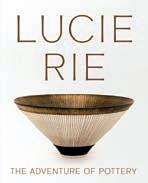
46 ANTIQUE COLLECTING
COLLECTING GUIDES Lucie Rie’s ceramics
‘Rie drew inspiration from many sources including Neolithic and Bronze Age ceramics, modern design and the natural world’
Q&A
We asked Marijke Varrall-Jones founder of the ceramics auction specialists Maak for her tips on collecting works
 by Lucie Rie
by Lucie Rie
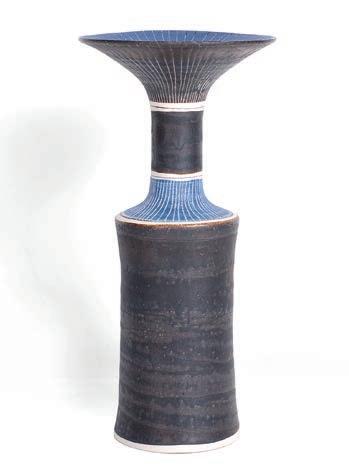

QHow would you describe Rie’s style?
ARie developed a unique style that combined traditional wheel thrown ceramic techniques with modern design principles routed in her early years at the Kunstgewerbeschule in Vienna. Her work was characterised by the use of simple, elegant forms and precise, intricate decoration, often combined with vivid coloured glazes, which earned her widespread recognition and made her one of the most influential ceramicists of the 20th century.
QHow at odds was her work from the prevailing styles of the time?
AIt offered an alternative aesthetic to the Anglo-Oriental style lauded by Bernard Leach that had dominated studio pottery since its earliest days in the 1920s. Bernard Leach was such a dominant figure that in spite of Rie having enjoyed considerable successes and wide spread recognition for her work prior to her arrival in England, when she first met with Leach he persuaded her to abandon her modernist style and she very briefly started working more in line with his ‘brown pot’
style. Thankfully this period was brief and when Hans Coper started working with Rie he convinced her to stay true to her origins grounded in European modernism. Rie’s was fundamentally an urban style routed entirely in the avant garde artistic developments of European modernism. This was a new and starkly opposing aesthetic to the ‘country’ pottery of Bernard Leach and the AngloOriental style that he represented, fusing the English country slipware tradition with Japanese and Chinese stoneware ceramic tradition as an ideal standard.
QWhat advice have you got for people wanting to start a collection?
AFundamentally the advice is the same for a specific artist as it is for collecting ceramics generally. Collect what you love – over time you’ll refine your eye and build confidence in finding what it is that turns you on to one piece over another. It can be that you are drawn to a certain form, colour, texture. Obviously for Rie affordability will be a limiting factor for most. Generally I’d say buying less of the best you can afford is better than buying more of lesser works, but this should be driven by what you love above anything.
Certainly focusing on her tableware is a good option if you’re keen to find something more affordable. While condition is an important consideration, if a work has sustained damage and been professionally restored it can look entirely perfect to the naked eye yet the price can be as little as 25 per cent of the ‘perfect’ value. So if owning a major work by Rie is an ambition, well restored works can be an opportunity to acquire something that would otherwise fall out of your price range.
QWhat makes the ‘ideal’ piece?




AFashions change. Where once her bottle vases with flared lips were most sought after, today her bowls are the most desired, particularly those that combine her bright golden bronze glaze with sgraffito and inlay.
Regardless of the style of her work, what you’re always looking for is balance of form – no leaning, slumping or bloating combined with clarity and evenness of the glaze – not over or under fired – and execution of the design – is the sgraffito or inlay executed well. Every artist has good and bad days and so there is definitely an element of range in the standard of what Rie was producing.
QHave you got a favourite piece or style, glaze, form etc?
AHaving been fortunate to handle so much of Rie’s work over the years it’s difficult to pick just one favourite style. Although they are not the most desirable in the current market, I love her spiral works – where she combined two different clay bodies and would throw them together on the wheel causing the two clays to spiral through each other. When the pot is then glazed the chemicals in the glaze react differently to the two clays and so produce coloured spirals that are integral to the piece. It’s a process entirely reliant on being hand made and the sense of the potter’s hand being evident has always been a huge draw to me with ceramics overall.
Maak’s next auction of modern and contemporary ceramics is on May 22-25, for more details go to www.maaklondon.com
ANTIQUE COLLECTING 47
‘Certainly focusing on her tableware is a good option if you’re keen to find something more affordable. Restored works can also be an opportunity to acquire something in your price range’
Above Lucie Rie, vase with ared lip, c.1978, porcelain. Private Collection. Photograph Maak Contemporary Ceramics
Below Lucie Rie (1902–1995), straight-sided bowl, 1970, porcelain. Private Collection. Photograph Maak Contemporary Ceramics
I believe in 2023 original concert posters will become more widely accepted as valuable assets as collectors from other areas will begin pursuing rare posters for the rst time.
And high net worth individuals (HNWIs) will decide to add a high-grade poster or two to their portfolio of rare collectables.
e potential is there to acquire some of the world’s rarest pop culture artefacts, at prices far lower than comparable pieces in other categories. I predict 2023 could be a banner year.
Headline news
e ve most valuable posters of all-time have all sold within the past two years. And in 2022 the world record price for a concert poster was smashed twice. Such highpro le sales achieve two important things.
1) ey bring new rare posters to the market. Often these examples have been stored away for decades, preserved by the original owners who never previously considered them particularly valuable – until they saw the headlines and dollar signs.
TRIPLE JUMPS
Above is incredibly rare 1953 Hank Williams poster, for the show he died on the way to, sold in 2021 for a record $150,000. Image courtesy of Heritage Auctions

CONCERT POSTERS
Rare vintage concert posters are popular with many collectors, but one that hasn’t quite broken out into the mainstream yet. And as such, I believe it has the potential for signi cant growth over the next 12 months and beyond. Best of all they are seriously undervalued. For now...
As a music fan and a collector myself, I’ve always loved concert posters. Rare, original versions are works of art in their own right. ey capture an exact time and place in music history. ey can hold strong memories and inspire nostalgia in collectors.
Above right A unique Bob Dylan poster for his landmark 1963 show at Town Hall in New York, with doodles from Dylan himself, sold for $68,750 in 2022, image courtesy of Heritage Auctions

Right is original 1966 Beatles Shea Stadium poster sold at Heritage Auctions last year for a record $275,000. Image courtesy of Heritage Auctions

2) ey bring new collectors into the hobby. HNWIs – particularly those with a passion for musicrealise rare posters are a safe and potentially pro table place to store their wealth. And what was once considered an indulgent purchase now becomes viewed as a sound investment. is wider awareness increases demand, which in turn increases prices.
e Beatles
A quick way to illustrate this signi cant rise is with a poster considered one of the hobby’s holy grails: an original poster for e Beatles’ 1966 concert at Shea Stadium. is original 1966 Beatles Shea Stadium poster sold at Heritage Auctions last year for a record $275,000. Until 2019, only four or ve examples of this poster were known to exist.
ey were the “rarest of the rare”. Most dealers and collectors had never even seen one, let alone owned one. And then... lift-o .
In November
2019 a copy set a new auction record when it sold at Heritage Auctions for $125,000.
In April 2020 a second copy sold at Heritage for
48 ANTIQUE COLLECTING
With one category reporting a 172 per cent increase in less than four years, Paul Fraser reveals three memorabilia areas every collector should know about in 2023
COLLECTING GUIDES ree ‘must-own’ memorabilia
1
$137,500. In November 2021 a third sold for $150,000. And in April 2022 another example sold for $275,000, setting a world-record price for any concert poster at auction.
All four were fresh to the market. at record-breaking rst sale in 2019 brought the following three examples out of the woodwork. And the value more than doubled in the space of two and-a-half years.
Heritage Auctions director of rare posters, Pete Howard, said: “ e hobby’s never seen anything quite like this. It’s clearly a domino e ect in action. e consignors are simply reacting to the strong market for this poster and concert posters in general, and deciding now is the time to sell.” You could say exactly the same thing about the buyers as well.
Dylan & e Dead
Another great example of the rising market is one of the most iconic vintage concert posters of all-time: A 1966 Grateful Dead ‘Skeleton & Roses’ poster for two concerts at the Avalon Ballroom in San Francisco.
According to Howard, the poster’s popularity and value is “soaring like a piece of ne European art.”
In August 2018 a near-mint condition copy sold at auction for $50,600.
And in April 2022 another near-mint example sold for a record $137,500. at’s a 172 per cent increase in value in less than four years.
RECORD BREAKER
One of the main strengths of the concert poster market is the huge rarity of original posters. Thin sheets of paper, they were never meant to last more than a few weeks. The world’s most valuable concert poster is a Buddy Holly Winter Dance Party poster advertising a gig in Minnesota on February 3, 1959, famously known as ‘The Day the Music Died’. Holly and his tour mates Ritchie Valens and the Big Bopper were on their way to the show when their plane tragically crashed. There’s only one poster known to survive. And in November 2022 it sold at Heritage for $447,000. It’s the world’s most valuable concert poster by a clear margin.
Above right e onlyknown unused ticket for Michael Jordan’s NBA debut for the Chicago Bulls in 1984, sold at Heritage Auctions last year for $468,000, image courtesy of Heritage Auctions

Above e classic 1966 Grateful Dead Skeleton and Roses poster is perhaps the most famous of the ‘60s psychedelic era. Image courtesy of Heritage Auctions
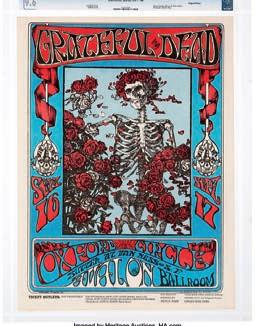
Left e Buddy Holly Winter Dance Party poster sold last November for a world record of $447,000, making it the world’s most valuable concert poster by a clear margin, image courtesy of Heritage Auctions
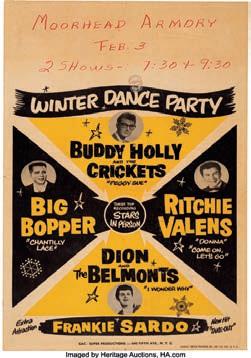
Below right Sports stubs are set to be the next hot ticket collectable
memorabilia in 2023. In 2022 they were described as “unquestionably the hottest segment in sports collecting.”
In a world where sports cards now regularly fetch more than $1m, with the nest examples solely available to the super-wealthy, it’s unsurprising that some collectors have turned their focus elsewhere. With sports tickets, it’s still possible to own the highestgraded copy of a ticket for thousands, not millions.

Building a world-class collection, and owning the pieces you love, is still a ordable for many collectors. And in many cases tickets are actually far rarer than sports cards, which adds to their desirability.
Ticket to ride
e world’s 10 most valuable tickets all sold in the past two years. And the record price for a ticket was broken three times last year within the space of a month.
ere are several great reasons why tickets are so popular with collectors:
• ey are rare, as most fans discarded their stubs after games. And complete, unused examples are rarer still.
• ey were present at some of the most iconic moments in sports history.
• ey can be professionally graded and slabbed, which adds guaranteed authenticity and a great deal of value.
• ey can hold a signi cant emotional connection for collectors who were actually at the games.
ANTIQUE COLLECTING 49
‘Heritage Auctions director of rare posters, Pete Howard, said: “The hobby’s never seen anything quite like this. It’s clearly a domino effect in action. The consignors are simply reacting to the strong market for this poster and concert posters in general, and deciding now is the time to sell.”’
2
COLLECTING GUIDES ree ‘must-own’ memorabilia
Shattering records
With almost all event tickets now existing in digital form only, there’s also the added nostalgia for owning physical tickets. e only-known unused ticket for Michael Jordan’s NBA debut for the Chicago Bulls in 1984, sold at Heritage Auctions last year for $468,000. Back in 2018 a used stub from the same match sold for $33,000. At the time it was considered a huge price.

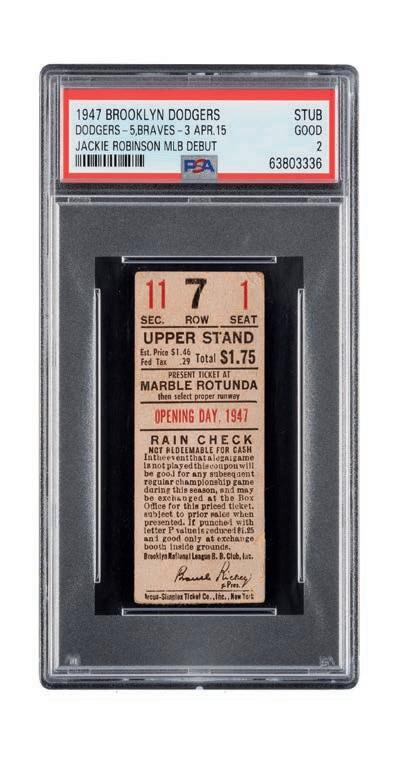
Fast-forward to 2021, and another stub from that game sold for $270,600 – a record price for any sports ticket. en in February 2022 that record was shattered twice in a matter of minutes during the same sale at Heritage.
First was another ticket for Jordan’s debut. It was the only complete, unused example known to exist in the hobby. And it sold for $468,000.
Jackie Robinson
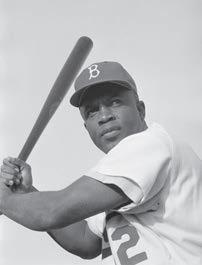
But it was soon beaten by a ticket from an even more signi cant moment in sports history.
Jackie Robinson’s MLB debut for the Brooklyn Dodgers in April 1947. e day he broke the colour barrier and changed baseball forever. at ticket sold for a stunning $480,000.
And even then, the record lasted less than a month. An original ticket for the rst U.S Masters golf tournament in Augusta in 1934, sold by Golden Age Golf Auctions in March 2022 for a record $600,000. e ticket that currently holds the record comes from the world of golf. ere are believed to be around 10 surviving tickets from the very rst U.S Masters tournament in 1934.
In 2007 one of those tickets sold for $50,000. At the time it was a record price for a sports ticket. It remained in the same private collection for 15 years. In March 2022 the same ticket sold again for $600,000. at’s an 1100 per cent increase in value, at a growth rate of 73.3% per annum.
LOOK OUT FOR
Collectors are also spending big on tickets from the debuts of current legends. In the past 12 months strong results have included:
• A signed ticket from Tom Brady’s 2000 NFL debut for the New England Patriots against the Detroit Lions, which sold for $175,200.
• A signed ticket from Tiger Woods’ PGA Tour debut at the 1992 Nissan Open at Riviera, which sold for $104,700.

• An unused ticket from Lionel Messi’s 2003 debut for Barcelona, in a friendly match against F.C Porto, which sold for $49,200.

Left Jackie Robinson’s MLB debut for the Brooklyn Dodgers in April 1947 sold for $480,000 in 2022, image courtesy of Heritage Auctions
Right Diego Maradona’s 1986 World Cup Argentina jersey sold at Sotheby’s in May for $8.93m, image courtesy of Sotheby’s

THE BEAUTIFUL GAME
When Diego Maradona’s 1986 World Cup Argentina jersey sold at Sotheby’s in May for $8.93m, it was a major turning point for the market. It set a new record for a game-worn sports jersey; a result that woke many people up to the value of historic football memorabilia. And it marked a signi cant change in a sports market previously dominated by baseball, basketball and U.S collectors.
Above An original ticket for the rst U.S Masters golf tournament in Augusta in 1934 set a record when it sold for $600,000 in March 2022, image courtesy of Golden Age Golf Auctions
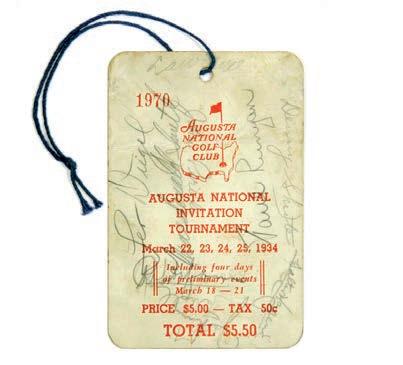
Left Jackie Robinson playing for the Brooklyn Dodgers in 1954, image Wikicommons media
Football’s global reach of 3.5bn fans has created a generation of passionate, wealthy collectors across Asia, Africa, Europe and the Middle East.
So I believe that trend will continue in 2023 with further high-pro le sales.
ere may not be another result on the same level as the Maradona jersey, but the new attention focused on football memorabilia should help increase prices across the category at every level. And in particular, there are three players I’d like to focus on.
50 ANTIQUE COLLECTING
Right A signed ticket for legendary quarterback Tom Brady’s NFL debut in 2000, sold for $175,200, image courtesy of Goldin Auctions
3
Below right An unused ticket for Lionel Messi’s debut for Barcelona in 2003, sold for $49,200, image courtesy of Goldin Auctions
e legend of Pelé
When it comes to individual players, it’s impossible to look past Pelé. His death last year at the age of 82 marked a sad moment for football fans of every generation.
And, as with the death of any major historic or cultural gure, it will also spark a big interest among collectors. Because Pelé’s autograph is one that collectors in every eld - not just football - want to own. Back in 2002 the iconic yellow Brazil jersey Pelé wore to victory in the 1970 World Cup Final sold for $222,400. It was a record price for any football jersey, and it stood for 20 years. But if that same Pelé jersey came to auction again today, I’d expect it to fetch ten times that amount.
In 2016 his World Cup winner’s medal from the same tournament sold for $427,000. Just seven years on, I believe it would also now sell for a much greater sum. Pelé comfortably stands alongside the likes of Muhammad Ali as an icon who truly transcends sport. Such special athletes are few and far between.
And when you see Ali’s ‘Rumble in the Jungle’ title belt selling for more than $6m, as it did in July last year, you realise the market for Pelé memorabilia may really just be getting started.
Lionel Messi
And then there’s Lionel Messi, now regarded by many as the nest football player of all-time. e seven-time Ballon d’Or winner had already achieved every honour possible in the modern game, with the exception of lifting the World Cup. And when he nally did so in December, his legacy among the pantheon of greats was con rmed. Again, 2022 saw a signi cant rise in his memorabilia prices.

For example, in 2019 the boots in which Messi scored his 500th goal for Barcelona – a winner in the 2017 ‘El
Clásico’ game against Real Madrid – sold for $10,240. But in April 2022, the jersey he wore during the same match sold for $450,000. It was a remarkable price for a non-international jersey worn just ve years previously. More than twice as much as Pelé’s 1970 Brazil jersey. And it showed collectors now seriously value memorabilia from the modern game, as well as historic pieces. en in December 2022 a rare 2014 Messi trading card sold for $522,000 - a record for any football card featuring a current player.
Importantly, both these record-breaking sales came before he won the World Cup in December. And I believe in 2023 he could potentially become the next player to pass the $1m mark at auction.

Kylian Mbappé
And nally you have the heir to the throne, French superstar Kylian Mbappé. At just 23 Mbappé has already played in two World Cup nals, winning one as a teenager and scoring a remarkable hat-trick in the other. He’s also the second-most valuable footballer in history, a record goal scorer in the French league, and has over 100 million followers on social media. In terms of the modern game, Mbappé is as big as they come. And collectors all want a piece of the action. His game-worn Paris St Germain jerseys from regular season matches can already fetch more than $30,000 at auction.
e rapid recent growth in his memorabilia valueand the football memorabilia market in general - is clearly evident. In June 2021, one of his game-worn jerseys from a 2018 Champion’s League game sold at auction for $3,750. en in June 2022, another of his jerseys from the same 2018 tournament sold for $23,400. at’s a huge leap in value in the space of 12 months.
And following his stunning World Cup nal performance, I suspect the value of his memorabilia will continue to increase even more in 2023. With most of his career still ahead of him, Mbappé truly has the potential to create a legacy as signi cant as Pelé, Maradona and Messi.
Paul Fraser is the founder of Paul Fraser Collectbles, for more details go to www.paulfrasercollectibles.com

ANTIQUE COLLECTING 51
‘An original ticket for the first US Masters golf tournament in Augusta in 1934, sold by Golden Age Golf Auctions in March 2022 for a record $600,000. There are believed to be around 10 surviving tickets’
Above Lionel Messi is regarded as the nest player in football history, image Shutterstock
Below Kylian Mbappé has the world at his feet and the potential to become one of the all-time greats, image Shutterstock
Driving passion
We have one man and his passion to thank for preserving a century of motoring marvels. A retired businessman from Burton-on-Trent, Sta ordshire, built up this extraordinary collection over the course of 45 years.
Before retirement he drove one of his classics to his former Burton-based business, Applied Signs. e 1926 Austin 12/4 proudly displays its livery. Every vehicle has been loved, driven, enjoyed and well maintained. Some have been owned from new and cherished for decades. All are now destined to get collectors’ pulses racing when they go under the hammer. Such is their quality and rarity the collection could achieve in excess of £80,000.
Secret car museum
An Auctioneer’s Lot


It’s the stu of dreams for me and any fellow motoring enthusiasts. An incredible array of classic cars, uncovered in a Midlands barn, go on sale later this month. And aside from the inevitable layers of dust which have settled over time, all are in remarkable condition given their age.
Some 10 curvaceous classics are a “Who’s Who” of British, USA and French motoring history. e earliest example, a Citroën open two-seater, dates back to 1923 with four cars from that decade in the sale.
Above 1923 Citroën open two-seater owned by the vendor for more than 30 years, photo credit Mark Laban, Hansons
Left 1926 Austin 12/4 van was driven by the vendor and displayed his Applied Signs livery, photo credit Mark Laban, Hansons
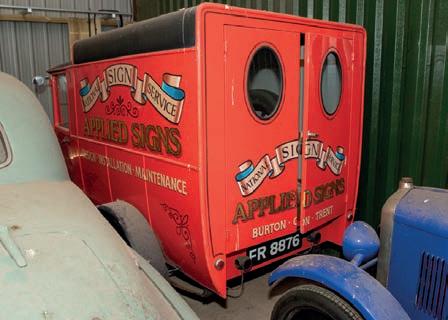
Right 1928 Franklin Airman, photo credit Mark Laban, Hansons
e vehicles were found by Hansons’ classic car consultant Jim Ronan who could hardly believe his eyes. He described it as like uncovering a secret small car museum, hidden from view in the countryside. His favourites are the Hudson 6 Coupe and the Franklin.
As well as the 1923 Citroën, the nds included a 1952 Austin A125 Sheerline; a 1929 Peugeot open tourer; a 1928 Chevrolet Doctor’s Coupe (popular with doctors because the trunk was large enough for extra medical equipment); an extremely rare 1941 Hudson 6 coupe; a 1926 Austin 12/4 van; a 1928 Franklin Airman and a 1981 Rolls-Royce Silver spirit. e Austin A125 sheerline - Austin’s answer to the Bentley - has been owned by the vendor for 40 years, while the rare 1928 Chevrolet Doctor’s Coupe has been in his care for 30 years. Also steering into auction is a 1973 Rolls-Royce shadow 1, also owned from new, and a 1997 Jaguar 3.2 sport.
e vehicles go under the hammer at Hansons’ classic cars sale on March 18. To arrange a classic car valuation email jronan@hansonsauctioneers.co.uk or call 01283 733988.
US CLASSIC CAR
The most valuable car on sale this month is a 1928 Franklin Airman worth up to £20,000, built from 1902 until 1934 and distinguished by their air-cooled engines.


When US aviator Charles Lindbergh flew across the Atlantic with an air-cooled motor in 1927, Franklin played up the connection by introducing an ‘Airman’ sedan.
Franklin’s models were known for their lightness and responsiveness compared to other luxury makes.
‘The vehicles were found by Hansons’ classic car consultant Jim Ronan who could hardly believe his eyes. He described it as like uncovering a secret small car museum, hidden from view in the countryside. His favourites are the Hudson 6 Coupe and the Franklin’
52 ANTIQUE COLLECTING
COMMENT Charles Hanson
Charles Hanson is driven wild by an extraordinary collection of classic cars discovered in a barn, described as a “secret motoring museum”
EXPERT




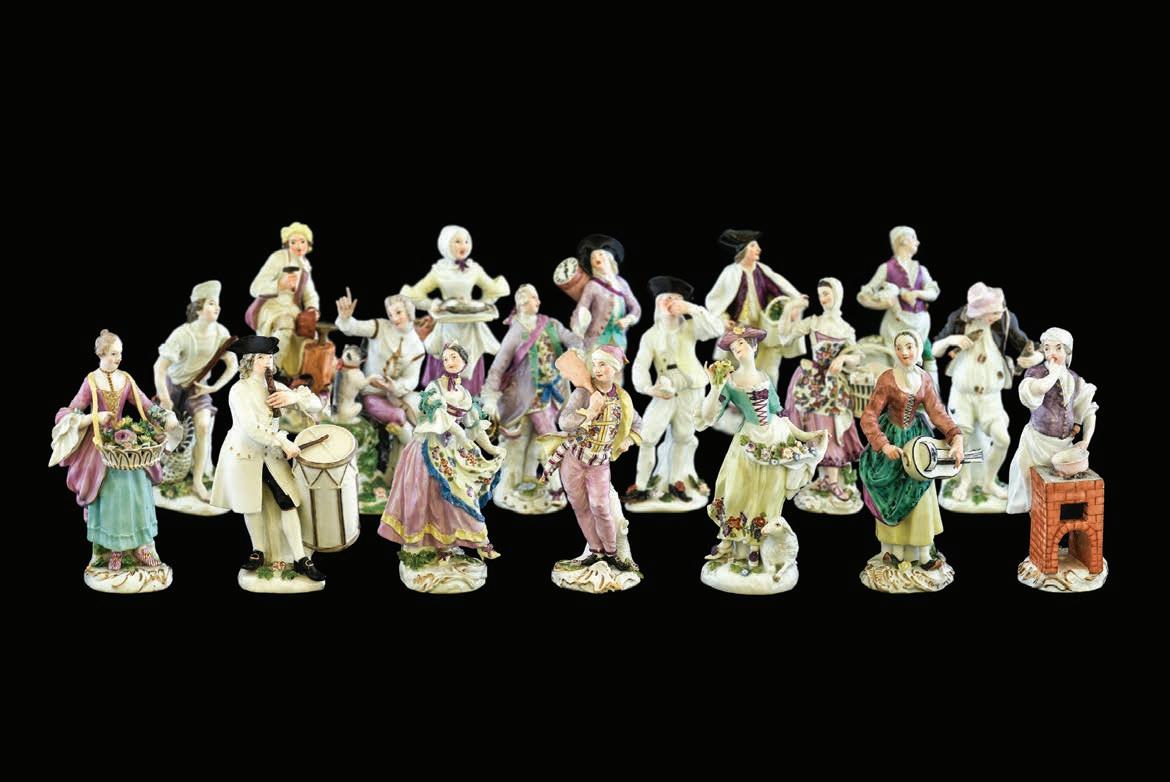
ANTIQUE COLLECTING 53
ANTIQUES UNDER THE HAMMER Lots in March
TOP of the LOTS
A collection of antique textiles is up for sale in London while a JK Rowling signature causes a stir
A rare stained glass window of St Margaret of Antioch by pre-Raphaelite and arts and crafts luminary Sir Edward Burne-Jones has an estimate of £15,000-£20,000 at North Yorkshire auctioneers Tennants' 0th-century design sale on March 4.

As the vast majority of BurneJones’ stained glass windows remain in their original buildings, it is extremely rare to see an example of his work coming onto the open market. The window was designed by BurneJones, but was made and sold by Morris & Co., the company set up by William Morris in 1861. The late 19th century saw an extraordinary period of church building and renovation, with Morris & Co. given many important commissions.
A 1929 Cadillac town car is expected to make £10,000-£15,000 in Charterhouse’s vintage and classic car auction on March 9. It is one of four vintage American cars dating from the 1920s on sale at the Sherborne auction house in Dorset, along with a 1924 Buick, a 1927 Packard a 1928 Packard (each with the sameestimate).

Charterhouse’s Richard Bromell said: “To say these are imposing cars is probably an understatement. They are all ready to be enjoyed or possibly evenas a business as they are perfect for use as wedding, prom or TV hire cars.
A painting of the Norfolk seaside town of Gorleston by Edward Seago (1910-1974) has an estimate of £6,000-£8,000 at Bonhams Knightsbridge’s sale of British and European art on March 8.

Lowestoft-born Seago painted in both oils and watercolours –many of his works featuring the East Anglian coast - with his oeuvre variously described as either Impressionist or post-Impressionist.
The Queen Mother purchased so many that eventually the artist gave her two each year, on her birthday and at Christmas, and in 1956 Prince Philip invited him on a tour of the Antarctic, and his subsequent paintings, considered to be among his best, hang at Balmoral.
Above e painting is expected to make £6,000-£8,000 in London this month



An early French 20th-century emerald, sapphire and diamond brooch in the shape of a peacock’s feather has an estimate of £2,000-£4,000 in Wilson 55’s fine jewellery and watches sale on March 16.

Set in 18ct gold and suspending a pear cut diamond weighing over 1.50cts, it bears French assay marks and a Liz Bailey from the auction house based in Nantwich, Cheshire, said: “It was no doubt inspired by the iconic Question Mark necklace famously made by Frédéric Boucheron in the late 19th century reputedly for Grand Duke
e brooch is inspired by a 1879 design by Boucheron
A signed copy of a first-edition, 23rd-issue paperback of Harry Potter and the Philosopher’s Stone, and a firstedition, first-issue paperback of Harry Potter and the Chamber of Secrets have a pre-sale estimate of £1,500£2,000 at Hansons’ sale in Derbyshire on March 7.

Both were signed in 1999 before JK Rowling became a global phenomenon while she was visiting children at Waterstones book shop in Wells, Somerset.
Hansons’ Jim Spencer said: “In a market completely flooded with fake Rowling signatures, it’s lovely to have such great provenance.”
Right e paperbacks were signed in 1999 before Harry Potter mania hit
Below e 1929 Cadillac town car came from a West County deceased estate
Above e stained glass window has a pre-sale estimate of £15,000-£20,000
Early English crewelwork and tapestries from the renowned French manufactory Aubusson are among the contents sale of a celebrated London textiles shop at Bonhams Knightsbridge this month.


Textiles specialist Peta Smyth is closing her store in Pimlico after 45 years, having started in the business trading from a stall in Portobello Road market in the ‘70s.
She said: “After 45 years of trading, I have decided to close my shop in Moreton Street and pursue a more leisurely life.”
In that time she became known for her keen eye, building up a dedicated clientele of interior designers and collectors
The diverse selection of stock going under the hammer on March 21 includes items fromher personal collection, as well a needlework for antique furniture, silk brocades, embroidery, appliquéd and printed textiles and curtains. Smaller decorative pieces such as cushions, braids and fringes will also be on sale, with a particular emphasis on European textiles of the 16th century through to the 19th century.
High praise

Bonhams’ Charlie Thomas said: “Thesale will be the final chance for collectors to acquirepieces from her impeccably curated selection. We are sure it won’t fail to entice those new to fine textiles and seeking inspiration, as well as established interior design connoisseurs.”
Quoted in The London Magazine, the designer Nicky Haslam said: “Peta Smyth’s rare and beautiful antique textiles provide not just unique furnishing materials, but are also a source of constant inspiration.”
Peta was a regular at both the LAPADA fair and the Lo Antique Rug and Textile Art Fair (LARTA) – the UK’s only specialist fair dedicated to antique textiles and rugs – held on the mezzanine level of the Decorative Fair in Battersea Park.
Aubusson treasures
The collection includes a number of Aubusson tapestries, named after the town where they originated, approximat 200 miles south of Paris in theCreuse valley.

In 1665 the town was granted thetitle of Royal Manufactory by King Louis XIV. Like its rival workshops at Beauvais and Gobelins, Aubusson was renowned for its exceptional textiles and tapestries that reflected the height of contemporary fashions. The tapestries were based on work from well-known artists, including drawings of biblical and historical scenes, as well as pastoral, and floral patterns. Typically, Aubusson tapestries depended on engravings as a design source, or scale drawings from which the low-warp tapestry-weavers worked.
The Peta Smyth Collection of Antique Textiles and Tapestries takes place at Bonhams Knightsbridge on March 21.
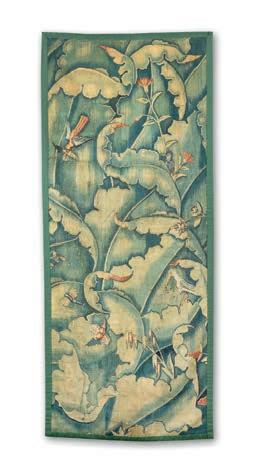
1Peta Smyth’s Pimlico shopis set to close 2 Peta Smyth in the shopthe contents of which go under the hammer this month 3 An early English 18th-century crewelwork curtain has an estimate of £4,000-£6,000 4 A large-leaf tapestry fragment, c. 1550, southern Netherlands, has an estimate of £12,000-£18,000 5 A late 17th-century Aubusson tapestry has an estimate of £8,000-£12,000 in this month’s sale 6 A pair of French tapestry portières, c 1720-1730, probably Beauvais, has an estimate of £8,000-£12,000



55
‘Over 45 years Peta became renowned for her keen eye, building up a dedicated clientele of interior designers and collectors’
BOOK OFFERS
From surprising stories about whisky to secret Edinburgh, stay up to date with the latest titles from our sister publisher ACC Art Books and save more than a third on the RRP
UP TO 35% DISCOUNT



PHOEBE ANNA TRAQUAIR
BY ELIZABETH CUMMING
ISBN 9781911054436
RRP £19.99
OFFER PRICE £12.99
This is a compelling account of the life and career of Phoebe Anna Traquair, a leading figure in Britain’s Arts and Crafts movement. The new edition features new research about her artistic practice, materials and technique as well as her intellectual life, including her correspondence with John Ruskin. Traquair was remarkable for her openness to all types of art, and worked in a range of media including embroidery, enamels, illuminated manuscripts and murals. This current edition features 120 illustrations including the latest discoveries, as well as some of her most famous and best-loved works. Beautifully illustrated and featuring the artist’s own words, this book is at once a fascinating biography and an artistic study of one of Scotland’s first professional women artists.

150 GARDENS YOU NEED TO VISIT BEFORE YOU DIE
BY STEFANIE WALDEK
ISBN 9789401479295
RRP £30.00

OFFER PRICE £19.50
This book profiles a selection of the most beautiful gardens in the world, renowned for their exceptional flora, imaginative designs, and inspiring locations. From Kew Gardens in London to the Singapore Botanical Gardens, and from Monet’s garden at Giverny to the Zen garden of the Ryōan-ji Temple in Kyoto, this handsomely bound book captures in words and images the most notable features of these 150 glorious, not-to-be-missed gardens. An essential bucket list book for garden lovers!

111 PLACES IN EDINBURGH THAT YOU MUST NOT MISS
 BY GILLIAN TAIT
BY GILLIAN TAIT
ISBN 9783740814762
RRP £13.99
OFFER PRICE £9.09
Edinburgh is rightly celebrated for its famous historical and cultural attractions. But for the discerning visitor it has much more to offer away from the well-worn tourist trail. This book takes you to hidden corners and secret sights in this city of contrasts, exploring fascinating locations unknown even to most residents, and revealing unexpected aspects of some familiar local landmarks. Discover the human stories behind a wide range of places, both exceptional and commonplace, bringing to life the greatly varied cityscape where people have been leaving their mark for at least 5,000 years.
56 ANTIQUE
COLLECTING
SUBSCRIBER
ORDER NOW! Email lauren.kerr@accartbooks.com, or call 01394 389988. Postage to UK addresses is £6, call for overseas rates.
EXCLUSIVE
WONDERFUL WHISKIES - 40 BOTTLES WITH AN UNUSUAL STORY
 BY FERNAND DACQUIN
BY FERNAND DACQUIN
ISBN 9789401486293
RRP £25.00

OFFER PRICE £16.25
In his second book for the connoisseur of whiskies and spirits, whisky expert and enthusiast Fernand Dacquin has gathered 43 amusing, surprising, and memorable anecdotes about the most beautiful and luxurious bottles of whiskey he has encountered. For almost 40 years, he has been travelling through this wonderful whisky world, in search of the most striking stories and images. At close to 400 pages, with enticing illustrations, he shares these stories in his own engaging style, offering the ideal entertainment for the reader with a glass of whisky in hand.
SPAIN & THE HISPANIC WORLD - TREASURES FROM THE HISPANIC SOCIETY MUSEUM & LIBRARY
 BY PATRICK LENAGHAN
BY PATRICK LENAGHAN
ISBN 9781912520947

RRP £20.00
OFFER PRICE £13.00
Published to accompany a landmark exhibition, with over 150 dazzling and fascinating pieces, at the Royal Academy, London, from January 21 to April 10, 2023. The Hispanic Society of America in New York is the vision of Archer M. Huntington. From an early age, Huntington developed an abiding love both of Hispanic culture and of museums and libraries. He resolved to devote his considerable fortune to combining these two passions and carried out his project so resourcefully that the collections he assembled remain exceptional for their depth and richness, displaying the culture of Spain and Latin America in the broadest sense. Their scope ranges from the prehistoric era to the early 20th century, including antiquities, decorative arts, Islamic works, manuscripts and rare books as well as superb canvases by Old Masters such as El Greco, Velázquez and Goya.
developed an abiding love both of Hispanic culture and of museums and

111 PLACES IN MANCHESTER THAT YOU SHOULDN’T MISS
 BY JULIAN TREUHERZ & PETER DE FIGUEIREDO
BY JULIAN TREUHERZ & PETER DE FIGUEIREDO
ISBN 9783740818623
RRP £13.99
OFFER PRICE £9.09
Manchester is far more than a grey provincial city preoccupied with the business of making money. The bales of cotton goods awaiting export have gone from the grand warehouses styled like palaces, and the mills no longer hum with the sound of machinery. Yet the buildings remain in all their glory of tiles, terracotta and stained glass – converted to hotels, offices, chic apartments, hipster bars, fine eateries or gritty drinking dens. The textile trade may have disappeared, but you can find sustainable fashion in the old rag-trade district, and top-quality coats and jackets are still being hand-sewn in the last remaining family-owned clothing factory. The ultimate insider’s guide to Manchester.
ANTIQUE COLLECTING 57
FAIR NEWS
Details of the recent cancellation of two major London fairs this summer, as well as other events set to get pulses racing in March
Went to Gloucester Art and antiques specialists with an eye for the decorative and collectable gather this month at the the Cotswolds Decorative, Antiques & Art Fair at Westonbirt School, near Tetbury, from March 31 to April 2.

Organiser Sue Ede, from Cooper Events, said: “This is where people come to decorate and furnish their homes in their own personal style. The fair offers a special mix of decorative antiques and 20th-century pieces such as jewellery, silver and watches.”
Among the dealers taking part are Bristol dealer Brian Ashbee Antiques, the London art deco specialist Hickmet Fine Arts, as well as Antique Collecting’s David Harvey from WH Harvey Antiques, and Rowles Fine Art from Ludlow.
The Great Hall and Orangery of Westonbirt House – now a private school – provdes the historic backdrop for the event.
Above e three-day event attracts collectors after that certain something
Palace in Westminster
The third monthly “Horti” fair, one of the stalwarts of the Lonson fairs calendar, takes place on March 26 from 10am-4.30pm.
Taking its name from the Sunday fair’s location – the Royal Horticultural Halls – in Westminster, the one-day event attracts dealers and collectors from the capital and beyond. Established in the 1970s, the fair welcomes 120 exhibitors to the Lindley Hall, one of two buildings on the site, named after the English botanist John Lindley.
Fairs cancel

Two of the landmark summer London fairs have cancelled this year blaming increasing costs, Covid-19 and Brexit. Both Masterpiece and the summer edition of the Art & Antiques Fair Olympia – due to mark its 50th-anniversay this year – are no longer taking place although the latter event is expected to return for its winter edition on October 31.
In a statement for Masterpiece, Emanuel Kuhn, for the Swiss events company MCH Group, said: “Escalating costs and a decline in the number of international exhibitors mean that the event is not commercially viable this year. Brexit has certainly had an impact on the fair.”


The fair, which launched in 2010, had been scheduled for June 28-July 5 at the Royal Hospital in Chelsea.

Art & Antiques Fair Olympia’s cancellation was also due to rising costs.
Fair director Mary Claire Boyd blamed “escalating costs” meaning the event “just didn’t have the strength of commitment that we needed to have to go ahead this year.”
Medal power
Collectors are advised to “make a day of it” when they visit this month’s Mark Carter Militaria and Medal Fair in Stratford upon Avon.
The 90-dealer event on March 19 at the Stratford Leisure and Visitor Centre, is close to the historic town centre. Each of the exhibitors taking part are specialists in militaria, medals and military books. The event was established in 1998 and attracts the best dealers and collectors from around the UK.

Below e guildhall in Stratford upon Avon is close to the fair’s location

58 ANTIQUE COLLECTING
OUT AND ABOUT March
Above e fair takes place in Lindley Hall, one of two Royal Horticultural Halls in London
Above e high-end event took place at the Royal Hospital in Chelsea
FAIRS Calendar
Because this list is compiled in advance, alterations or cancellations to the fairs listed can occur and it is not possible to notify readers of the changes. We strongly advise anyone wishing to attend a fair especially if they have to travel any distance, to telephone the organiser to confirm the details given.
LONDON: Inc. Greater London
Adams Antiques Fairs
020 7254 4054 www.adamsantiquesfairs.com
Adams Antiques Fair, The Royal Horticultural Halls, Elverton Street, SW1P 2QW, Mar 26
Etc Fairs 01707 872 140
www.bloomsburybookfair.com
Turner Suite at Holiday Inn, Coram Street, London, WC1N 1HT, Bloomsbury Book Fair, Booker & Mar 12
Sunbury Antiques
01932 230946
www.sunburyantiques.com
Kempton Antiques Market, Kempton Park Race Course, Staines Road East, Sunbury-on-Thames, Middlesex TW16 5AQ, Mar 14, 28
SOUTH EAST & EAST ANGLIA: including Beds, Cambs, Essex, Hertfordshire, Kent, Norfolk, Suffolk, Surrey, Sussex.
Antique, Vintage and Collectables Fair
020 8776 0108
Hayes Free Church, 111 Pickhurst Lane, Hayes, Kent, BR2 7HU, Mar 11
Arun Fairs 07563 589725
Rustington Antiques & Collectables Fair, The Woodland Centre, Woodlands Avenue, Rustington West Sussex, BN16 3HB, Mar 5
Continuity Fairs
01584 873634
www.continuityfairs.co.uk
Antique Fair, Epsom Downs
Racecourse
Tattenham Corner Rd, Epsom KT18 5LQ, Mar 21
Dovehouse Fine Antiques Fair
07952689717
dovehousefineantiquesfairs.com
Dorking Halls, Reigate Road, Dorking, Surrey, RH4 1SG, Mar 26
Grandmas Attic Antique and Collectors Fairs
www.grandmasatticfairs.co.uk
The Westgate Leisure Centre, Via Ravenna, Chichester, PO19 1RJ, Mar 12
IACF 01636 702326 www.iacf.co.uk
South of England Showground, Ardingly, Nr Haywards Heath, West Sussex, RH17 6TL, Mar 7-8
Love Fairs 01293 690777
www.lovefairs.com
Brighton Racecourse, Freshfield Road, Brighton, East Sussex, BN2 9XZ, Mar 5
Marcel Fairs 07887648255
www.marcelfairs.co.uk
Antique and Collectors Fair, Sarratt Village Hall, The Green, Rickmansworth, Herts WD3 6AS, Mar 12
Antique and Vintage Fair –Eagle Farm Road, Biggleswade, Bedfordshire, SG18 8JH, Mar 19
The Three Counties Antique and Fine Art Fair 01933 353517 www.castlewoodantique-fairs.co.uk
The Rufus Centre Steppingly Road, Flitwick, Bedfordshire, MK45 1AH Mar 11-12
SOUTH WEST including Berkshire, Buckinghamshire, Cornwall, Devon, Dorset, Gloucestershire, Hampshire, Isle of Wight, Oxfordshire, Somerset, Wiltshire.
AFC Fairs 07887 753956 www.antiquefairscornwall.co.uk
Lostwithiel Antique & Collectors Fair, Lostwithiel Community Centre, Pleyber Christ Way, Lostwithiel, Cornwall, PL22 0HE, Mar 12 Pensilva Antiques Fair, Millennium House, Princess Road, Liskeard, Cornwall, PL14 5NF, Mar 26
Arun Fairs 07563 589725
Emsworth Antiques and Collectors Fair, Emsworth Community Centre., North Street, Emsworth, Hampshire, PO10 7DD, Mar 12
Cooper Events
01278 784912
CooperEvents.com
Bath Decorative Antiques Fair
01225 743647
The Pavilion, Bath BA2 4EU Mar 9-11
The Cotswolds Decorative, Antiques & Art Fair, Westonbirt School
Tetbury, Gloucestershire GL8 8QG, Mar 31
Continuity Fairs 01584 873634
www.continuityfairs.co.uk
Matford Centre, Matford Park Rd, Marsh Barton, Exeter EX2 8FD, Mar 4
Gloucestershire Antiques & Collectables Market
01264 393225
The Corn Hall, 26 Market Place, Cirencester, Gloucestershire, GL7 2NW, Mar 3, 10, 17, 24, 31
IACF 01636 702326
www.iacf.co.uk
Royal Bath & West Showground
Shepton Mallet, Somerset, BA4 6QN, Mar 17-19
Jay Fairs 01235 815633
Benson Antiques and Collectors Fair, Benson Parish Hall, Sunnyside, Benson, Nr. Wallingford, Oxfordshire, OX10 6LZ, Mar 19
EAST MIDLANDS including Derbyshire, Leicestershire, Lincolnshire, Northamptonshire, Nottinghamshire, Rutland.
IACF 01636 702326
www.iacf.co.uk
Newark & Nottinghamshire
Showground, Nottinghamshire, NG24 2NY
Newark International Antiques & Collectors Fair, Mar 13 Runway Newark, Mar 30-31
Navenby Antiques and Collectors Fair at The Venue, 07522 679 630 Venue at Navenby, Grantham Road, Navenby, Lincolnshire, LN5 0JJ, Mar 26
Stags Head Events
07583 410862
www.stagsheadevents.co.uk
Antiques & Vintage Fair, Hodson Hall, Endowed Campus, Off A6, Loughborough, LE11 2DU Mar 26
WEST MIDLANDS including Birmingham, Coventry, Herefordshire, Shropshire, Staffordshire, Warwickshire, Worcestershire
B2B Events 07774 147197 or 07771 725302
www.b2bevents.info
Malvern Flea & Collectors Fair Three Counties Showground, Malvern, Worcestershire, WR13 6NW, Mar 5
Mark Carter Militaria and Medal Fairs 2023 01753 534777
www.milweb.net/dealers/trader/ markcarter.htm Stratford Leisure Centre, Bridgefoot, Stratford Upon Avon, Warwickshire, CV37 6YY, Mar 19
Midland Vintage and Antique Fair
0121 784 1581
Antique and Vintage Fair, Fentham Hall, Marsh Lane, Hampton-in-Arden, West Midlands, B92 0AH, Mar 12
NORTH including Cheshire, Cumbria, Lancashire, Northumberland, Tyne and Wear, Yorkshire.
V&A Fairs
01244 659887
www.vandafairs.com
Civic Hall Nantwich
Beam Street, Nantwich, Cheshire England, CW5 5DG, Mar 16
SCOTLAND
Glasgow, Antique, Vintage & Collectors Fair 07960 198409, 31 Bellahouston Drive, Glasgow, G52 1HH, Mar 19
IRELAND
Naas Antiques, Vintage & Collectables Fair
00353 85 862 9007
Osprey Hotel
John Devoy Quarter
Naas, Co. Kildare
W91X4 0K, Mar 5
ANTIQUE COLLECTING 59
SPECIALIST GLASS
AUCTION Calendar
Because this list is compiled in advance, alterations or cancellations to the auctions listed can occur and it is not possible to notify readers of the changes. We strongly advise anyone wishing to attend an auction especially if they have to travel any distance, to telephone the organiser to confirm the details given.
LONDON: Inc. Greater London
Bonhams
101 New Bond St, London
W1S 1SR, 020 7447 7447
www.bonhams.com
Post-War and Contemporary Art, Mar 16
Modern and Contemporary African Art, Mar 22
British. Cool, Mar 29
19th Century and British Impressionist Art, Mar 29
Bonhams Montpelier St, Knightsbridge, London, SW7 1HH, 020 7393 3900
www.bonhams.com
British and European Art, Mar 8
Designer Handbags and Fashion, Mar 8
Knightsbridge Jewels (Online), Mar 3-15
Collections: Including The Peta Smyth Collection of Antique
Textiles and Tapestries and Important Historical Portraits and Decorative Arts from the Collection of Lord and Lady Flight, Mar 21
Modern British and Irish Art, Mar 22
Fine Books and Manuscripts, Mar 29
Chiswick Auctions
Barley Mow Centre
Chiswick, London, W4 4PH 020 8992 4442
www.chiswickauctions.co.uk
19th and 20th Century Paintings and Works on Paper, Mar 8
Jewellery, Mar 14
Designer Handbags and Fashion, Mar 15
Books and Works on Paper, Mar 16
Fine Oriental Rugs and Carpets, Mar 23
Watches, Mar 23
Silver and Objects of Vertu, Mar 23
Wine, Whisky and Spirits, Mar 26
Modern British and Irish Art, Mar 28
Design and Modern Contemporary, Mar 28
Christie’s
8 King St, St. James’s, SW1Y 6QT, 020 7839 9060
www.christies.com
Post-War and Contemporary Art Day Sale, Mar 1
Impressionist and Modern Art Day and Works on Paper Sale, Mar 3
First Open: Post-Wat and Contemporary Art (Online), Ends Mar 9
Contemporary Edition: London (Online), Ends Mar 14
Prints and Multiples (Online), Mar 2-16
Modern British and Irish Evening Sale, Mar 21
Modern British and Irish Day Sale, Mar 22
Elmwood’s 101 Talbot Road London, W11 2AT 0207 096 8933
www.elmwoods.co.uk
Fine Jewellery, Mar 1, 22
Important Jewels, Mar 7 Jewellery, Mar 15, 29
Designer Handbags and fashion, Mar 16
Forum Auctions
220 Queenstown Road, London, SW8 4LP, 020 7871 2640
www.forumauctions.co.uk
Single Owner Collection (Online), Mar 9
Books and Works on Paper (Online), Mar 23
Fine Books, Manuscripts and Works on Paper, Mar 30
Hansons Auctioneers
The Normansfield Theatre, 2A Langdon Park, Teddington
TW11 9PS, 0207 018 9300
www.hansonsauctioneers.com
March Fine Art and Collectables
Auction, Mar 25
Lyon & Turnbull
Mall Galleries, The Mall, St. James’s, London SW1Y 5AS, 0207 930 9115
www.lyonandturnbull.com
Select Jewellery(Live Online), Mar 29
Select Watches (Live Online), Mar 29
Noonans Mayfair
16 Bolton St, Mayfair, W1J 8BQ, 020 7016 1700
www.noonans.co.uk
Banknotes, Mar 1-2
Ancient Coins and Antiquities, Mar 8
Phillips 30 Berkeley Square, London, W1J 6EX, 020 7318 4010
www.phillips.com
20th Century and Contemporary Art Evening Sale, Mar 2-3 New Now, Mar 8
Roseberys Knights Hill, Norwood, London, SE27 0JD 020 8761 2522
www.roseberys.co.uk
Modern and Contemporary Prints and Multiples, Mar 7
Modern British and 20th-Century Art, Mar 14
Design Since 1860, Mar 22
Jewellery and Watches, Mar 28
Old Master, British and European Pictures, Mar 29
Sotheby’s New Bond St., W1A 2AA 020 7293 5000
www.sothebys.com
The Now Evening Auction, Mar 1
Modern and Contemporary, Mar 1-2
Made in Britain (Online) Mar 8-14
Prints and Multiples (Online), Mar 9-16
Form: (Women) Makers (Selling (Women) Artists (Online), Mar 10-16
Modern and Contemporary African Auction (Online), Mar 15-21
TimeLine Auctions
23-24 Berkeley Square
London W1J 6HE
www.timelineauctions.co.uk
020 7129 1494
None listed in March
SOUTH EAST AND EAST
ANGLIA: Inc. Bedfordshire, Cambridgeshire, Essex, Hertfordshire, Kent, Norfolk, Suffolk, Surrey, Sussex
Bishop and Miller
19 Charles Industrial Estate, Stowmarket, Suffolk, IP14 5AH, 01449 673088
bishopandmillerauctions.co.uk
Medals and Militaria
Coins, Stamps and Postcards, Mar 23
Remarkable Rooms with Fine Pictures, Mar 30
Bishop and Miller
Unit 12 Manor Farm, Glandford, Holt, Norfolk, NR25 7JP
bishopandmillerauctions.co.uk Fine Jewellery, Watches and Silver, Mar 29
Bellmans Newpound, Wisborough Green, West Sussex, RH14 0AZ, 01403 700858 www.bellmans.co.uk
Old Master, British & European Paintings, Mar 28
Silver, European Ceramics, Jewellery and Interiors, Mar 29-30
Burstow & Hewett The Auction Gallery, Lower Lake, Battle, East Sussex,TN33 0AT, 01424 772 374
www.burstowandhewett.co.uk
Luxury Watches, Fine Jewellery and Silver, Mar 3, Mar 31
Home and Interiors, Mar 8-9 Antiques, Mar 23
20th-Century Design, Mar 23 Fine Art and Sculpture, Mar 23
Cheffins Clifton House, Clifton Road, Cambridge, CB1 7EA 01223 213343, www.cheffins.co.uk
The Interiors Sale, Mar 9
The Fine Sale, Mar 22-23
Ewbank’s
London Rd, Send, Woking, Surrey, 01483 223 101 www.ewbankauctions.co.uk
Pre-loved, Vintage and Antiques, Mar 1
James Bond Live, Mar 2
Magic The Gathering: 1993-1996, Mar 3
Jewellery, Watches and Coins, Mar 22
Silver and Fine Art, Mar 23
Antiques, Books, Clocks & Antique
Furniture, Mar 24
Automobilia, Mar 30
Cars and Motorbikes, Mar 31
Excalibur Auctions Limited Unit 16 Abbots Business Park Primrose Hill Kings Langley, Hertfordshire, WD4 8FR 020 3633 0913
www.excaliburauctions.com
60 ANTIQUE COLLECTING
TOGMAC - Collection of Model Cars - Part 3, Mar 4
Toys and Model Railways Collectors Sale, Mar 25
Gorringes 15 North Street, Lewes, East Sussex, BN7 2PE, 01273 472503
www.gorringes.co.uk
Weekly, Mar 6, 13
Spring Fine Sale, Mar 14
Horners the Auctioneers
Old Norwich Road, Acle, Norwich, NR13 3BY 01493 750225
www.horners.co.uk
Antiques and Collectables, Mar 2, 16
John Nicholson’s
Longfield, Midhurst Road, Fernhurst, Haslemere, Surrey, GU27 3HA, 01428 653727
www.johnnicholsons.com
Fine Painting Auction, Mar 22
Lacy Scott & Knight
10 Risbygate Street, Bury St Edmunds, Suffolk, IP33 3AA, 01284 748 623
www.lskauctioncentre.co.uk
Homes and Interiors, Mar 11
20th-Century Art and Design, Mar 17
Music, Film and Sport Memorabilia, Mar 17
Fine Art and Antiques, Mar 18
Lockdales Auctioneers
52 Barrack Square, Martlesham Heath, Ipswich, Suffolk, IP5 3RF 01473 627110
www.lockdales.com
Toys, Antiques, Books and Ephemera, Mar 1
Coins, Medals, Militaria and Weapons, Mar 21-22
Parker Fine Art Auctions
Hawthorn House, East Street, Farnham, Surrey, GU9 7SX, 01252 203020
www.parkerfineartauctions.com
General, Mar 9
Reeman Dansie
8 Wyncolls Road, Severalls Business Park, Colchester, Essex, CO4 9HU, 01206 754754
www.reemandansie.com
Model Railway from the Late
Ian Claude Standfast Collection (Timed Online), ends Mar 5
Home and Interiors, Mar 7-8
Fine & Affordable Art - (Timed Online) Ends Mar 12
Specialist Collectors’, Mar 28
Summers Place, The Walled Garden, Billingshurst West Sussex, RH14 9AB, 01403 331331
www.summersplaceauctions.com
Home, Garden and Natural History Mar 28
Home, Garden and Natural History (Sealed Bids) Mar 29
Sworders Fine Art Auctioneers
Cambridge Road, Stansted Mountfitchet, Essex, CM24 8GE 01279 817778
www.sworder.co.uk
Homes and Interiors (Online), Mar 7
Fine Interiors Two-Day Sale, Mar 14-15
Homes and Interiors (With Militaria) (Online), Mar 28 Jewellery, Mar 29
Toovey’s Antique & Fine Art Auctioneers Spring Gardens, Washington, West Sussex, RH20 3BS, 01903 891955
www.tooveys.com
Wristwatches and Pocket Watches, Clocks and Barometers, Cameras and Scientific Instruments, Mar 2
Die-cast Model Vehicles and Accessories, Model Trains and Railways, Tinplate and Mechanical Toys and Models, Dolls, Dolls’ Houses and Accessories,Silver and Plate and Jewellery, Mar 15 Furniture, Collectors’ Items, Works of Art and Light Fittings, Rugs and Carpets, Mar 16
Antiquarian and Collectors’ Books, Mar 22
T.W. Gaze
Diss Auction Rooms, Roydon Road, Diss, Norfolk, IP22 4LN, 01379 650306.
www.twgaze.com
Antiques and Interiors, Mar 3, 10, 17, 24, 31
Blyth Barn Furniture Auction, Mar 7, 14, 21, 28
SOUTH WEST: Inc. Berkshire, Buckinghamshire, Cornwall, Devon, Dorset, Gloucestershire, Hampshire, Isle of Wight, Oxfordshire, Somerset, Wiltshire
Bearnes Hampton & Littlewood St. Edmund’s Court, Okehampton Street, Exeter EX4 1DU
O1392 41310
www.bhandl.co.uk
Sporting and Collectors’ Sale, Mar 21
British Bespoke Auctions
The Old Boys School, Gretton Rd, Winchcombe, Cheltenham, GL54 5EE 01242 603005
www.bespokeauctions.co.uk
Antiques and Collectables, Including Jewellery, Silver and Watches, Mar 2
Chippenham Auction Rooms
Unit H, The Old Laundry. Ivy Road, Chippenham, Wiltshire. SN15 1SB, 01249 444544
chippenhamauctionrooms.co.uk
None listed in March
Chorley’s Prinknash Abbey Park, Near Cranham, Gloucestershire, GL4 8EU, 01452 344499 www.chorleys.com
Modern Art and Design, Mar 28
Asian Art and Carpets, Mar 29
David Lay Auctions
Penzance Auction House , Alverton, Penzance, Cornwall 01736 361414, TR18 4RE www.davidlay.co.uk
Asian Sale, Mar 9-10
Dawsons Unit 8 Cordwallis
Business Park, Clivemont Rd, Berkshire, SL6 4DP, 01628 944100 www.dawsonsauctions.co.uk
The March Jewellery, Watches and SIlver Auction, Mar 23
The March Fine Art and Antiques Auction, Mar 30
Dominic Winter
Mallard House, Broadway Lane, South Cerney, Cirencester, Gloucestershire, GL7 5UQ, 01285 860006 www.dominicwinter.co.uk
Printed Books, Natural History, Maps ad Documents, The Robert Gillmor Collection of Bird Books and Art, Mar 1
British and European Paintings, Old Master Prints and Drawings, 19th and 20th Century Paintings and Prints, Mar 8
Fine Antiques and Historic Textiles, Silver and Jewellery, Select Furniture and Objets d’Art, Mar 9
Dore & Rees
Auction Salerooms, Vicarage Street, Frome, Somerset BA11 1PU, 01373 462 257 www.doreandrees.com
Classic Cars, Mar 11
Fine Jewellery and Watches, Mar 22
Dreweatts Donnington Priory Newbury, Berkshire RG14 2JE 01635 553 553
www.dreweatts.com
Old Master British and European Art (Live Online), Mar 2
Fine Clocks, Barometers and Scientific Instruments (Live Online), Mar 7
Modern and Contemporary Art (Live Online), Mar 15
Fine Jewellery, Silver, Watches and Objects of Vertu (Live Online), Mar 22
Fine Furniture, Sculpture, Carpets, Ceramics and Works of Art, Day 1 and 2 (Live Online), Mar 29 and 30
Duke’s Brewery Square, Dorchester, Dorset, DT1 1GA, 01305 265080
www.dukes-auctions.com
Avenue Auctions, Mar 7
The du Boulay Collection, Mar 8 Interiors, Mar 9
Silver, Jewellery, Watches and Coins, Mar 23
East Bristol Auctions
Unit 1, Hanham Business Park, Memorial Road, Hanham, BS15 3JE, 0117 967 1000
www.eastbristol.co.uk
Antique & Vintage Jewellery, Watch & Gold Auction, Mar 1
Gardiner Houlgate 9 Leafield Way, Corsham, Wiltshire, SN13 9SW, 01225 812912
www.gardinerhoulgate.co.uk
The Guitar Auction Three-Day Sale, Mar 8-10
Greenslade Taylor Hunt
The Octagon Salerooms, 113a East Reach, Taunton, Somerset TA1 3HL 01823 332525. www.gth.net
Antique Sale, Mar 2, Collectors’ Sale, Mar 3 General Sale, Mar 23
Hansons Auctioneers
49 Parsons Street, Banbury, Oxford, OX16 5NB, 01295 817777
www.hansonsauctioneers.co.uk
March Fine Art, Antiques & Collectors Auction, Mar 4
Kinghams 10-12 Cotswold Business Village, London Road, Moreton-in-Marsh, Gloucester, GL56 0JQ, 01608 695695
www.kinghamsauctioneers.com
Fine and Decorative Arts, Mar 9-11
ANTIQUE COLLECTING 61
AUCTION Calendar
Because this list is compiled in advance, alterations or cancellations to the auctions listed can occur and it is not possible to notify readers of the changes. We strongly advise anyone wishing to attend an auction especially if they have to travel any distance, to telephone the organiser to confirm the details given.
Lawrences Auctioneers Ltd.
Crewkerne, Somerset, TA18 8AB, 01460 703041
www.lawrences.co.uk
Books, Maps, Manuscripts and Photography, Mar 16
Mallams Oxford Bocardo House, St Michael’s St, Oxford, OX1 2EB 01865 241358
www.mallams.co.uk
Art and Music, Mar 8
Mallams Cheltenham
26 Grosvenor St, Cheltenham. Gloucestershire, GL52 2SG 01242 235 712
www.mallams.co.uk
Modern Living March, Mar 22
Mallams Abingdon
Dunmore Court, Wootten Road, Abingdon, OX13 6BH, 01235 462840
www.mallams.co.uk
The House and Gardens Sale, Mar 27
Michael J Bowman
Chudleigh Town Hall, Chudleigh, Newton Abbot, Devon, TQ13 0HL, 01626 295107
www.michaeljbowman.co.uk
General Sale, Mar 26
Moore Allen & Innocent Burford Road Cirencester, Gloucestershire GL7 5RH, 01285 646050
www.mooreallen.co.uk
Vintage and Antique Furniture and Home Interiors (Live Online), Mar 8-9
Vintage and Antique Furniture and Home Interiors (Timed Online) Mar 10-15
Philip Serrell
Barnards Green Rd, Malvern, Worcestershire.
WR14 3LW, 01684 892314
www.serrell.com
Fine Art and Antiques, Mar 16
Stroud Auctions Bath Rd, Trading Est, Bath Rd, Stroud, Gloucestershire, GL5 3QF 01453 873 800
www.stroudauctions.co.uk
Jewellery, Watches, Silver, Clocks, Coins and Classic Cars and Motorcycles, Mar 8-9
Special Auction Services
Plenty Close, Newbury, Berkshire, RG14 5RL 01635 580 595 wwwspecialauctionservices.
Antiques and Collectables
Auction, Mar 7
Popular Diecast Toys and Trains
Auction, Mar 14
Jewellery, Watches, Coins and Silver Auction, Mar 23
Music and Entertainment Auction, Mar 28
The Cotswold Auction Company Bankside saleroom Love Lane, Cirencester, Gloucestershire, GL7 1YG, 01285 642420
www.cotswoldauction.co.uk
None listed in March
The Cotswold Auction Company Chapel Walk saleroom, Chapel Walk Cheltenham, Gloucesterhire, GL50 3DS, 01242 256363
www.cotswoldauction.co.uk
Modern Art and Design, Vintage Fashion & Textiles, Mar 21
The Pedestal The Dairy, Stonor Park, Henley-on-Thames, Oxfordshire RG9 6HF, 01491 522733
www.thepedestal.com
Fine Interiors, Mar 7
Wessex Auction Rooms
Westbrook Far, Draycot Cerne Chippenham, Wiltshire, SN15 5LH, 01249 720888
www.wessexauctionrooms.co.uk
Antiques, Collectables and Furniture (with BBC Bargain Hunt), Mar 4
Coins, Mar 9
Jewellery, Silver, Watches and Pocket Watches, Mar 10 Antiques, Collectables & Furniture Mar 18
Toys, Mar 30-31
Woolley & Wallis, 51-61 Castle Street, Salisbury, Wiltshire, SP1 3SU, 01722 424500
www.woolleyandwallis.co.uk
Old Masters, British and European Paintings, Mar 8
Clarice Cliff, Art Deco and Design, Mar 22
Wotton Auction Rooms
Tabernacle Road
Wotton-under-Edge,
Gloucestershire, GL12 7EB, 01453 708260
www.wottonauctionrooms.co.uk
Antiques and General Sale, Mar 13-15
EAST MIDLANDS: Inc.
Derbyshire, Leicestershire, Lincolnshire, Northamptonshire, Nottinghamshire, Sheffield
Batemans
Ryhall Rd, Stamford, Lincolnshire, PE9 1XF, 01780 766 466
www.batemans.com
Monthly Antiques and Specialists Collectors’, Mar 4
Gildings Auctioneers
The Mill, Great Bowden Road, Market Harborough, LE16 7DE 01858 410414
www.gildings.co.uk
Antiques and Collectors’, Mar 7, 21
Golding Young & Mawer
The Lincoln Auction Rooms, Thos Mawer House, Station Road North Hykeham, Lincoln LN6 3QY, 01522 524984
www.goldingyoung.com
Lincoln Collective Sale, Mar 22-23
Hansons
Heage Lane, Etwall, Derbyshire, DE65 6LS 01283 733988
www.hansonsauctioneers.co.uk
March Historica, Coins and Banknotes Auction, Mar 8
March Toys, Models, Live Steam and Video Game Auction, Mar 14
March Music Memorabilia, Musical Instruments & Film Auction, Mar 15
March Antique and Collectors’ Auction, Mar 16-21
March Decorative Art Auction: To Include Works of Art, Teak, Ercol & 20th Century Furniture, Mar 22
March Two-Day Derbyshire Fine Art Auction, Mar 30-31
WEST MIDLANDS: Inc.
Birmingham, Coventry, Herefordshire, Shropshire, Staffordshire, Warwickshire
Cuttlestones Ltd
Wolverhampton Auction Rooms, No 1 Clarence Street, Wolverhampton, West Midlands, WV1 4JL, 01902 421985
www.cuttlestones.co.uk
Antiques and Interiors, Mar 16
Cuttlestones Ltd
Pinfold Lane, Penkridge Staffordshire ST19 5AP, 01785 714905
www.cuttlestones.co.uk
Spring Antiques, Mar 9 Antiques and Interiors, Mar 23
Fellows
Augusta House, 19 Augusta Street, Hockley, Birmingham, B18 6JA 0121 212 2131
www.fellows.co.uk
Pawnbrokers, Jewellery and Watches, Mar 2, 16
Silver, Coins and Medals, Mar 2 Antiques, Fine Art and Collectables, Mar 3
Jewellery Day 1, Mar 7, 14, 28
Jewellery Day 2, Mar 8, 15, 29
The Luxury Watch Sale, Mar 16
Fieldings
Mill Race Lane, Stourbridge, DY8 1JN 01384 444140
www.fieldingsauctioneers.co.uk
Online Timed Auction, Ends Mar 6
Decades Of Design including Clarice Cliff, Mar 16-17
Halls
Bowmen Way, Battlefield, Shrewsbury, Shropshire, SY4 3DR 01743 450700
www.hallsgb.com/fine-art.com
Antiques and Interiors, Mar 8
Books, Manuscripts and Autographs, Mar 9
Fine Art, Antiques and Jewellery Auction, Mar 22
Timed Moorcroft Pottery, Mar 24 to April 4
Hansons Auctioneers
Bishton Hall, Wolseley Bridge, Stafford, ST18 0XN,
62
ANTIQUE COLLECTING
0208 9797954
www.hansonsauctioneers.co.uk
March Fine Jewellery, Silver and Watch Auction, Mar 3
March Library Auction, Mar 7
March Classic Car Auction, Mar 18
March Country House Attic and Interiors Auction, Mar 25
March Monthly Fine Art and Antiques Auction, Mar 28
Potteries Auctions
The Cobridge Saleroom, 271 Waterloo Road, Cobridge, Stoke-on-Trent, Staffordshire, ST6 3HR, 01782 212489
www.potteriesauctions.com
Antiques Auction, Mar 26
Trevanion
The Joyce Building, Station Rd, Whitchurch, Shropshire, SY13 1RD, 01928 800 202
www.trevanion.com
Fine Art and Antiques, Mar 22
NORTH: Inc. Cheshire, Co.
Durham, Cumbria, Humberside, Lancashire, Greater Manchester, Northumberland, Tyne & Wear, Sheffield, Yorkshire
Adam Partridge
Withyfold Drive, Macclesfield, Cheshire, SK10 2BD
01625 431 788
www.adampartridge.co.uk
Northern and Fine Art with Sporting and Militaria, Mar 1-3
One Day Sale of Studio Ceramics, Mar 24
Adam Partridge The Liverpool Saleroom, 18 Jordan Street, Liverpool, L1 OBP 01625 431 788
www.adampartridge.co.uk
Photographic, Optical and Scientific, Silver and Jewellery with Antiques and Collectables, Mar 1
Anderson and Garland Crispin Court, Newbiggin Lane, Westerhope, Newcastle upon Tyne, NE5 1BF, 0191 432 1911
www.andersonandgarland.com
The Music Auction, Mar 1
Homes and Interiors, Mar 7
Fine Silver, Jewellery and Watches, Mar 21
Spring Country House and Fine Interiors, Mar 21-23
Capes Dunn The Auction Galleries, 40 Station Road, Heaton Mersey, SK4 3QT. 0161
273 1911
www.capesdunn.com
Interiors, Vintage and Modern Furniture, Mar 6, 20
Antique Furniture, Clocks, Eastern Carpets; Traditional Paintings, Mar 7
Antiquarian and Collectable Books, Maps, Prints and Affordable Art, Mar 21
Duggleby Stephenson
The Saleroom, York Auction Centre, Murton, York YO19 5GF,01904 393 300
www.dugglebystephenson.com
Jewellery and Watches, Mar 9 The Silver Sale, Mar 9 Antiques and Collectors’, Mar 9 Collectors’ and Clearance, Mar 9 Fine and Affordable Art, Mar 10 Furniture, Rugs and Interiors, Mar 10
Elstob & Elstob
Ripon Business Park, Charter Road, Ripon, North Yorkshire HG4 1AJ, 01677 333003
www.elstobandelstob.co.uk
Asian Art, Mar 1
Silver, Mar 29
Omega Auctions Ltd
Sankey Valley Industrial Estate, Newton-Le-Willows, Merseyside WA12 8DN, 01925 873040
www.omegaauctions.co.uk
The Bob Solly Collection of Rare Records - Part Five, Mar 14
The Beatles Colllection, Mar 28
Sheffield Auction Gallery
Windsor Road, Heeley, Sheffield, S8 8UB, 0114 281 6161
www.sheffieldauctiongallery.com
Vinyl Records and Music
Ephemera, Mar 2
Silver, Jewellery and Watches, plus Specialist Collectable Coins, Mar 2
Antiques and Collectables, Mar 3, 31
Medals and Militaria, Mar 16
Fine Silver, Jewellery and Watches, Mar 16
Antiques and Fine Art, Mar 17 Football Programmes and Sporting Memorabilia, Mar 30
Silver, Jewellery and Watches, Mar 30
Tennants Auctioneers
The Auction Centre, Harmby Road, Leyburn, North Yorkshire DL8 5SG. 01969 623780
www.tennants.co.uk
Modern and Contemporary Art, Mar 4
20th-Century Design, Mar 4
Antiques and Interiors,
Mar 10, 24
Stamps, Postal History and Postcards, Mar 15
British, European and Sporting Pictures, Mar 18
Spring Fine Sale, Mar 18
Fine Jewellery, Watches and Silver, Mar 18
Military and Ethnographica, Mar 22
Thomson Roddick
The Auction Centre, Marconi Road, Burgh Road Industrial Estate, Carlisle, Cumbria, CA2 7NA, 01228 535 288
www.thomsonroddick.com
Antiquarian and Collectable Books and Related Items, Mar 16
Vectis Auctions Ltd Fleck Way, Thornaby, Stockton on Tees, TS17 9JZ, 01642 750616
www.vectis.co.uk
Die Cast Sale, Mar 7-8
Model Train Sale, Mar 17 General Toy Sale, Mar 23
TV and Film-Related Sale, Mar 28 Matchbox Models of Yesteryear Sale, Mar 29
Vinyl, Music and Associated Items Sale, Mar 30
Wilson55
Victoria Gallery, Market St, Nantwich, Cheshire CW5 5DG 01270 623 878
www.wilson55.com
Modern and Contemporary Art, Mar 8
Northern Art, Mar 9
Fine Jewellery and Watches, Mar 16
SCOTLAND
Bonhams 22 Queen St, Edinburgh, EH2 1JX 0131 225 2266
www.bonhams.com
Pictures and Prints (Online), Mar 22-19
Lyon & Turnbull
33 Broughton Place, Edinburgh. EH1 3RR, 0131 557 8844
www.lyonandturnbull.com
Silver and Objects de Vertu, Mar 7
Jewellery, Mar 8
Asian Works of Art, Mar 15 Select Jewellery, Mar 29 Select Watches, Mar 29
McTears Auctioneers
31 Meiklewood Road, Glasgow, G51 4GB, 0141 810 2880
www.mctears.co.uk
The Scottish Contemporary Art Auction, Mar 2
Whisky, Mar 3
Antiques and Interiors, Mar 10, 24
Scottish Pictures, Mar 15
Silver and Luxury Accessories, Mar 16
Life in Style, Mar 16
Jewellery, Mar 17
Asian Art, Mar 17
Stamps and Postcards:, Mar 17
WALES
Anthemion Auctions, 15 Norwich Road, Cardiff, CF23 9AB. 029 2047 2444
www.anthemionauction.com
Monthly General sale, Ceramics, Glass, Paintings, Furniture, Clocks, Works of Art, Books, Sporting and Memorabilia, Mar 8
Jones & Llewelyn
Unit B, Beechwood Trading Estate, Llandeilo, Carmarthenshire, SA19 7HR, 01558 823 430
www.jonesandllewelyn.com
General Sale, Mar 11, 25
Rogers Jones & Co
17 Llandough Trading Estate, Penarth, Cardiff, CF11 8RR, 02920 708125
www.rogersjones.co.uk
Jewellery and Collectables, Mar 17
IRELAND
Adam’s
26, Stephens Green, Dublin 2, D02 X665, Ireland 00 353 1 6760261
www.adams.ie
Important Irish Art, Mar 1
Fonsie Mealy’s
Chatsworth Auction Rooms, Chatsworth St., Castlecomer, Co. Kilkenny, Ireland
00 353 56 4441229
www.fonsiemealy.ie
(Online timed) Books and Collectors sale, Mar 13
Whyte’s
38 Molesworth St. Dublin D02 KF80 Ireland, 0 353 1 676 2888
www.whytes.ie
Irish and International Art, Mar 6
ANTIQUE COLLECTING 63

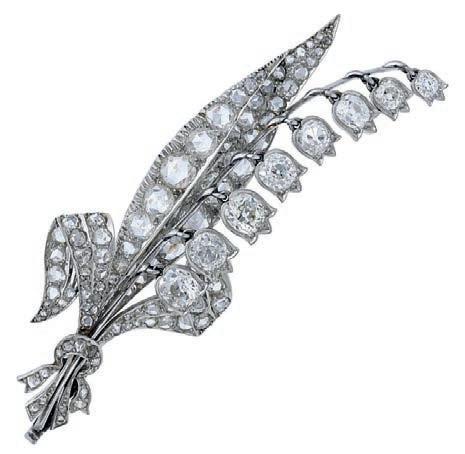



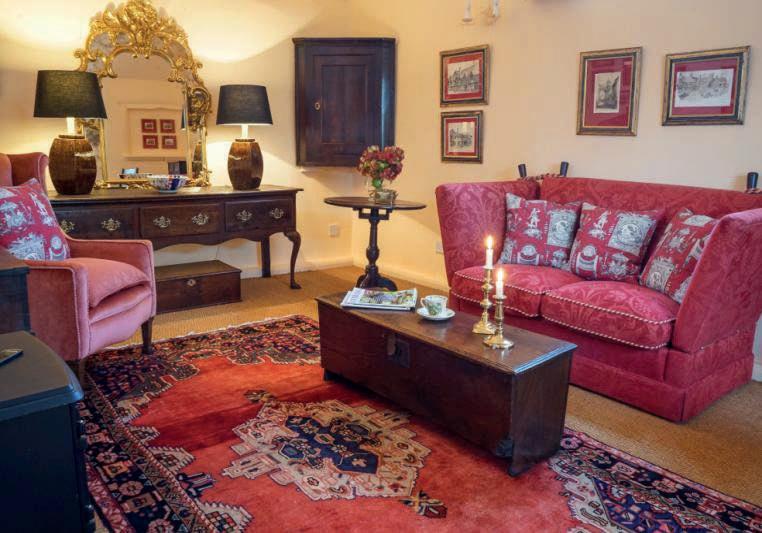

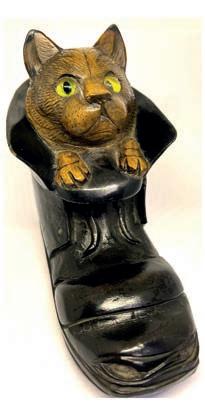


Please check www.b2bevents.info in case these dates have changed or been cancelled Tel: 01636 676531 • www.b2bevents.info
Collectors Fair Three Counties Showground, Worcestershire, WR13 6NW. Entrance: 7.30am - 3.30pm - £5 Easter Monday 10th April
Malvern Flea &
The Severn Hall, Three Counties Showground, Malvern, Worcs, WR13 6NW Sunday 5th March Antiques, Art Deco, collectables & much more Early entry: 8.30am- £5 Entrance: 10am - 3:30pm- £4 NO OUTSIDE PITCHES FORTHCOMING AUCTION JEWELLERY, WATCHES & OBJECTS OF VERTU TUESDAY 29 NOVEMBER ALL ENQUIRIES PLEASE CALL 020 7016 1700 OR EMAIL JEWELLERY@NOONANS.CO.UK A LATE 19TH CENTURY LILY OF THE VALLEY DIAMOND SPRAY BROOCH BY J.E. CALDWELL & CO. ESTIMATE: £4,000–£6,000 NOONANS • 16 BOLTON STREET MAYFAIR LONDON W1J 8BQ WWW.NOONANS.CO.UK Coachmans Holiday Cottage and The Antiques Source Country House Style Created with Antiquesin West Wiltshire. The perfect self-catering retreat for 2 guests in the Village of Steeple Ashton See www.coachmans-cottage.com for Holidays And www.theantiquessource.co.uk for Antiques Contact Penny.Email: phornseys@gmail.com Tel: 01380 870764 for Antique Sales or Bookings 64 ANTIQUE COLLECTING 01422 843189 o ce@terrierantiques.co.uk www.terrierantiques.co.uk QUALITY ANTIQUES & OBJETS D’ART 26 Market St, Hebden Bridge, West Yorkshire, HX7 6AA
Malvern Antiques & Collectors Fair
CATO ANTIQUES & WORKS OF


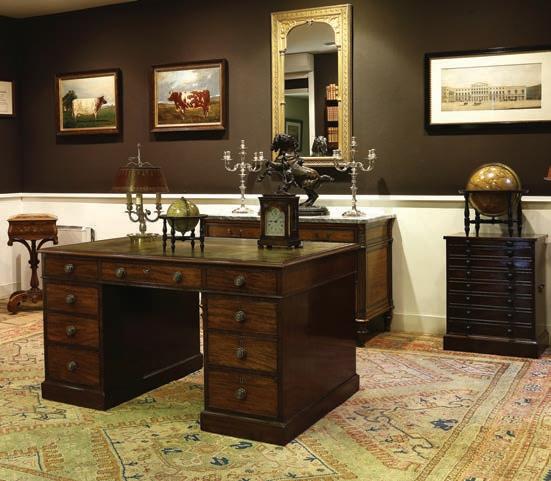
Labelled/ stamped branded furniture from Georgian to Victorian, eg Thomas Butler, Morgan & Sanders, J Alderman, Ross of Dublin (pictured), Gregory Kane, Wilkinson of Ludgate Hill, Robert James of Bristol, James Winter, W Priest, Samuel Pratt and many others. Tables all types, chairs, bookcases, , Davenport. mirrors etc. Campaign shower.
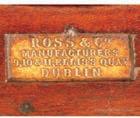
Georgian chamber horse exercise chair (pictured)
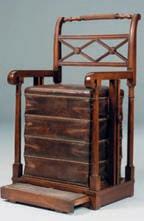
Signed and unusual furniture. Georgian, Regency, William IV. Sofa / Pembroke / side tables, library furniture / bookcases. Also Victorian campaign chests, armchairs etc. Ross of Dublin, Morgan & Sanders, Williams & Gibton, James Winter, Hill & Millard and many others.
•WANTED• VINTAGE WRISTWATCHES


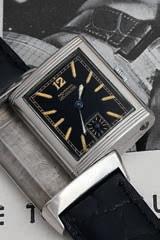
Omega Seamasters and pre-1980s Omegas in general. IWC and Jaeger LeCoultres, all styles. Looking for Reversos. American market filled and 14k pieces possibly, at the right price.
Omega Seamasters and pre-1980s Omegas in general. IWC and Jaeger LeCoultres, all styles. Looking for Reversos. American market filled and 14k pieces possibly, at the right price.
Breitling Top Times, Datoras and 806 Navitimers.
Pre-1960s Rolex models, with a focus in pre-war tanks, tonneaus etc. Gold or silver/steel. Also World War I Rolex 13 lignes etc. Princes.

Breitling Top Times, Datoras and 806 Navitimers. Pre-1960s Rolex models, with a focus in pre-war tanks, tonneaus etc. Gold or silver/steel. Also World War I Rolex 13 lignes etc. Princes.

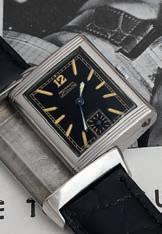
Longines, Tudors and Zeniths, pre-1970. Even basic steel models in nice condition. All the quirky oddities like Harwoods, Autorists, Wig Wag, Rolls etc, and World War I hunter and semi-hunter wristwatches.
Longines, Tudors and Zeniths, pre-1970. Even basic steel models in nice condition. All the quirky oddities like Harwoods, Autorists, Wig Wag, Rolls etc, and World War I hunter and semi-hunter wristwatches.
Early, pre-war ladies’ watches also wanted by Rolex, Jaeger LeCoultre etc. Prefer 1920s/30s deco styles, but early doughnuts also considered.
Early, pre-war ladies’ watches also wanted by Rolex, Jaeger LeCoultre etc. Prefer 1920s/30s deco styles, but early doughnuts also considered.
Yorkshire based, but often in London and can easily collect nationwide.
Yorkshire based, but often in London and can easily collect nationwide.
07958 333442
J Alderman. Daws and George Minter reclining chairs. Shoolbred/ Hamptons / Cornelius Smith Victorian armchairs.
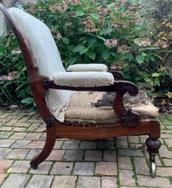
Unusual Georgian to William IV architectural features eg doors, door frames, over door pediments. 18th century staircase spindles and handrail needed. Anything Georgian or Regency with lots of character considered.
Marble fire surrounds. Georgian / Regency/ William IV. Bullseyes etc. Exceptional Georgian / Regency fire grates
Rectangular Georgian fanlight.
Sash windows x 4 identical. Georgian reclaimed. Approx 58” high x 36” wide. Wide reclaimed floorboards. Approx 100 m2. Early decorative oil / gas / electric light fittings. Ceiling, wall or table. Early gasoliers. Colza lamps. Gimble lamp.
Four identical reclaimed Georgian wooden sash windows with boxes, approx 60 high x 37 wide.
Roland Ward, Van Ingen taxidermy. Human skull. Hippopotamus skull. Stuffed crocodile / alligator.
Marble fire surrounds from 1750 to 1850ish. White or coloured. Bullseyes, William IV styles etc. Brass Regency reeded fire insert and Victorian griffin grate (pictured)
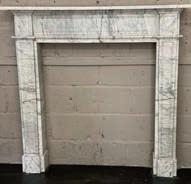

Quirky architectural features. Regency columns, corbels, marble and stone pieces, over door pediments, folding/rolling multi part Georgian room dividing doors.
Human skull, stuffed crocodile/ alligator. Grand tour souvenirs.
Victorian canopy shower bath. Decorated toilets etc Unitas, Simplicitas, Deluge etc. Decorated basins x 3.

Malvern
PM Antiques & Collectables are a modern and innovative antiques retailer based in Surrey. Specialising in a wide array of collector’s items, including contemporary art, entertainment and memorabilia, vintage toys, decorative ceramics, watches and automobilia.
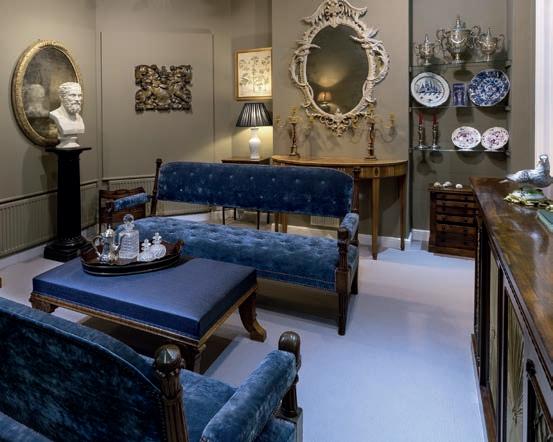
We Buy & Sell pm-antiques.co.uk Contact

Up to 400 inside & outside exhibitors. Entrance: 7.30am-3.30pm - £5

640113
Three Counties Showground, Worcestershire, WR13 6NW
Sunday 12th February Please

vintagejewellery@yahoo.co.uk or tel
07958 333442
For East Yorkshire town house renovation. ~ WANTED ~ vintagejewellery@yahoo.co.uk or tel 07958 333442 Europe’s largest choice of antiques & collectables www.hemswell-antiques.com The centres are open 7 days a week 10am - 5pm ANTIQUE COLLECTING 65 ANTIQUE COLLECTING 65
1 The Square, Church Street, Edenbridge, Kent TN8 5BD 01732 865 988 or 07836233473 cato@lennoxcato.com www.lennoxcato.com •WANTED• VINTAGE WRISTWATCHES vintagejewellery@yahoo.co.uk or tel
LENNOX
ART EST: 1978
•WANTED• for epic East Yorkshire Georgian townhouse restoration. vintagejewellery@yahoo.co.uk or tel 07958 333442
phil@pm-antiques.co.uk
PM_Antiques Tel: 01636 676531 • www.b2bevents.info
us:
01932
PMAntiques2015
Flea & Collectors Fair
check www.b2bevents.info in case dates have changed or been cancelled
Marc My Words

Below left Indian jewellery shops can deliver unexpected treasures, image

I’ve travelled to many countries over the years and relish being immersed in diverse cultures and the richness of the exchange it brings. I have just got back from two weeks in Rajasthan and was touched by the warmth and hospitality which greeted us. Although it was predominantly a voyage around some of the greatest and most iconic sights in history (the Taj Mahal at sunrise is now my screen saver) I was also eager to see whether India still o ered interesting antiques and curios. Naturally, I hate to think of myself as a tourist. I love to get involved in the nitty-gritty of life, whether having a haircut on the side of the road, or drinking the best masala chai out one of the lthiest cups I’ve ever seen. It is all part and parcel of what makes a ful lling trip. But, as we soon found out, we were not immune to the hustle and age-old traps common on all the tourist routes.

Sales patter
We don’t tend to swallow any of the sales patter so, when we got the hard sell in a pietra dura marble workshop in Agra, I was amused rather than impressed by a
demonstration that had obviously seen the same chap chiselling the same table top foryears. While thework was amazing, the prices were eyewatering and after beating a hasty retreat I bought a lovely carnelian and lapis lazuli inlaid box further down the road for 800 rupees (£80) –every bit as good asthe one the workshop was charging 3 500 rupees (£350) for.
After visiting various ‘antique’ shops on our sojourn through Rajasthan, and not really nding many antiques (one problem being that in India everything tends to look old) we were happy to buy things that – quite simply – we liked, which included decorative textiles and jewellery.
Buyer beware
e constant warning from nearly all vendors is that the seller next door is hawking fakes,so one should make sure all purchases come with a certi cate! In one high-end jewellery shop Lisa alighted on rather spectacular emerald, diamond and ruby tiger-head bangle which despite every assurance that it was from an ‘oldfamily’ was patently of modern craftsmanship. Haggling started at £15,000 and after a couple of cups of chai dropped to £11,000. We then sauntered down theroad to an ‘imitation’ jewellery shop and bought a not too shabby look-alike for £15. I also bought an ‘emerald and diamond’ ring for £15.I love Indian wedding jewellery shops.
But there was one shop in Udaipur owned by a rather suave Hindu priest that was di erent. We chatted for ages, he knew people that we knew, we drank more chai and looked at some exquisite objects. It was a pleasure. So having navigated this glorious region ofIndia with my antiques honour intact we left with anextra suitcase, some lovely items and an unfortunate last-minute bout of food poisoning. But don’t let that put you o .
66 ANTIQUE COLLECTING LAST WORD Marc Allum
‘In one high-end jewellery shop Lisa alighted on rather spectacular emerald, diamond and ruby tiger-head bangle which despite every assurance that it was from an’ old family’ was patently of modern craftsmanship’
Above e Taj Mahal featured on Marc’s tour of Rajest an, image Shutterstock
Shutterstock
Marc Allum isan author, lecturer and specialist on the BBC’s Antiques Roadshow, www.marcallum.co.uk
Marc Allum discovers his nose for a real antique is as acute in India as it is in the UK


40 Station Road West Canterbury, Kent CT2 8AN t 01227 763337 e general@tcag.co.uk Weekend Online Auction Dates 2023 All Auctions to be Held on Saturdays and Sundays 4th & 5th February, 1st & 2nd April, 3rd & 4th June 29th & 30th July, 30th September & 1st October 25th & 26th November Call Us to Book a Valuation Appointment at Home or at Our Saleroom in Canterbury. All Appointments are subject to current social distancing guidelines. Visit Our Website for More Details thecanterburyauctiongalleries.com Featured Poster: A.E. Halliwell Studio Collection





























































































 John Kane, Nottingham, by email
John Kane, Nottingham, by email









































































































































































 by Lucie Rie
by Lucie Rie





















































 BY GILLIAN TAIT
BY GILLIAN TAIT
 BY FERNAND DACQUIN
BY FERNAND DACQUIN

 BY PATRICK LENAGHAN
BY PATRICK LENAGHAN


 BY JULIAN TREUHERZ & PETER DE FIGUEIREDO
BY JULIAN TREUHERZ & PETER DE FIGUEIREDO





































